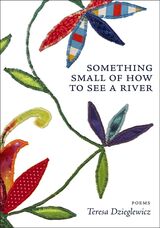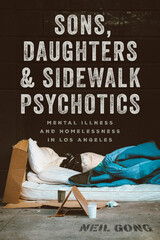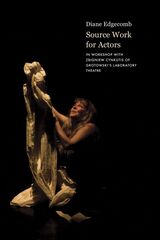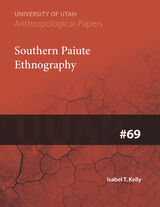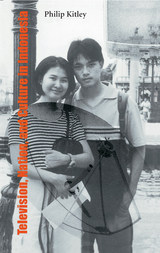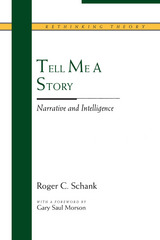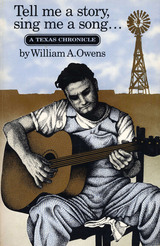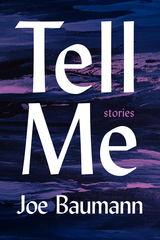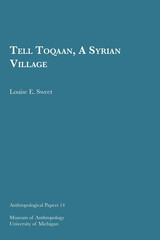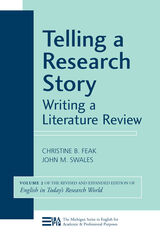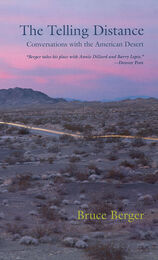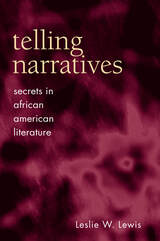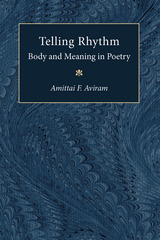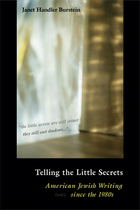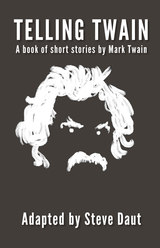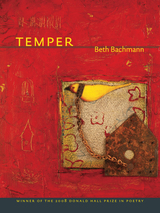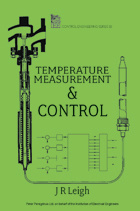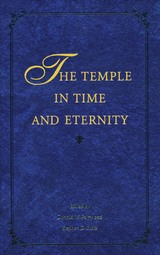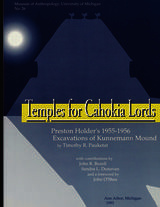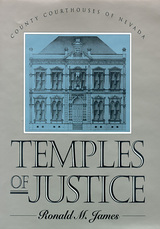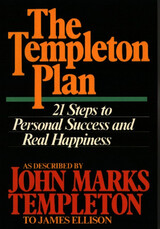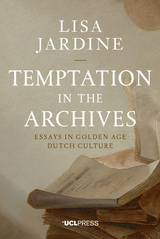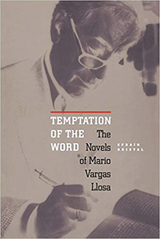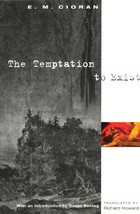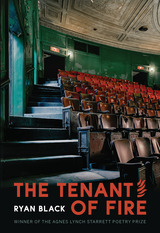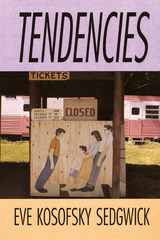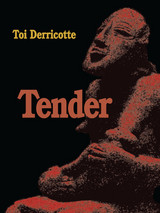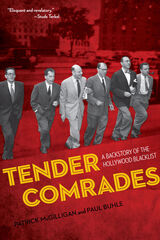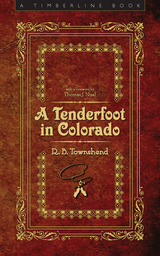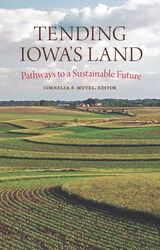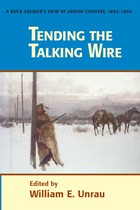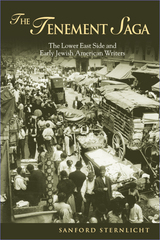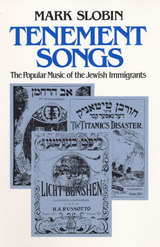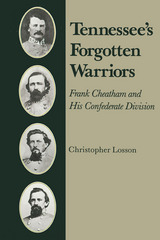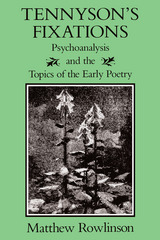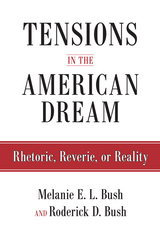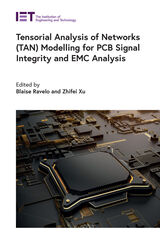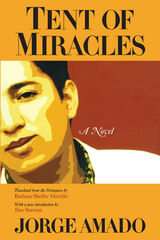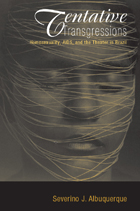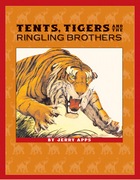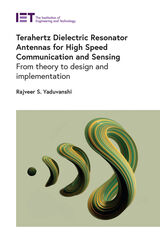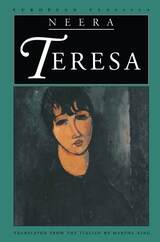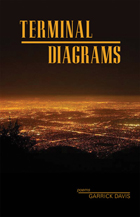 Television, History, and American Culture: Feminist Critical Essays
Mary Beth Haralovich and Lauren Rabinovitz, eds.
Duke University Press, 1999 In less than a century, the flickering blue-gray light of the television screen has become a cultural icon. What do the images transmitted by that screen tell us about power, authority, gender stereotypes, and ideology in the United States? Television, History, and American Culture addresses this question by illuminating how television both reflects and influences American culture and identity. The essays collected here focus on women in front of, behind, and on the TV screen, as producers, viewers, and characters. Using feminist and historical criticism, the contributors investigate how television has shaped our understanding of gender, power, race, ethnicity, and sexuality from the 1950s to the present. The topics range from the role that women broadcasters played in radio and early television to the attempts of Desilu Productions to present acceptable images of Hispanic identity, from the impact of TV talk shows on public discourse and the politics of offering viewers positive images of fat women to the negotiation of civil rights, feminism, and abortion rights on news programs and shows such as I Spy and Peyton Place. Innovative and accessible, this book will appeal to those interested in women’s studies, American studies, and popular culture and the critical study of television. Contributors. Julie D’Acci, Mary Desjardins, Jane Feuer, Mary Beth Haralovich, Michele Hilmes, Moya Luckett, Lauren Rabinovitz, Jane M. Shattuc, Mark Williams
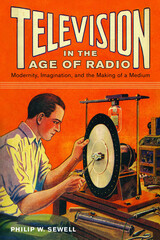 Television in the Age of Radio: Modernity, Imagination, and the Making of a Medium
Sewell, Philip W
Rutgers University Press, 2014 Television existed for a long time before it became commonplace in American homes. Even as cars, jazz, film, and radio heralded the modern age, television haunted the modern imagination. During the 1920s and 1930s, U.S. television was a topic of conversation and speculation. Was it technically feasible? Could it be commercially viable? What would it look like? How might it serve the public interest? And what was its place in the modern future? These questions were not just asked by the American public, but also posed by the people intimately involved in television’s creation. Their answers may have been self-serving, but they were also statements of aspiration. Idealistic imaginations of the medium and its impact on social relations became a de facto plan for moving beyond film and radio into a new era.
In Television in the Age of Radio, Philip W. Sewell offers a unique account of how television came to be—not just from technical innovations or institutional struggles, but from cultural concerns that were central to the rise of industrial modernity. This book provides sustained investigations of the values of early television amateurs and enthusiasts, the fervors and worries about competing technologies, and the ambitions for programming that together helped mold the medium.
Sewell presents a major revision of the history of television, telling us about the nature of new media and how hopes for the future pull together diverse perspectives that shape technologies, industries, and audiences.
 Television Is Where You Find It: A History of Feature Filmmakers in TV
Craig S. Simpson
Rutgers University Press Television is Where You Find It is a revelatory journey into the overlooked world of feature filmmakers who brought their cinematic vision to the small screen between 1955 and 1990—long before directing for television became trendy in the age of “Prestige TV.” With ten compelling case studies—from legends like Alfred Hitchcock, David Lynch, and Orson Welles to trailblazers like Ida Lupino, Melvin Van Peebles, and Martin Scorsese—author Craig S. Simpson uncovers how these directors reshaped the language of television with style and imagination. Far from simply dabbling in a “lesser” medium, these filmmakers pushed the boundaries of what TV could do, crafting bold, innovative work that challenges the old notion that television belongs solely to writers and producers. In this fresh, critical study, Television is Where You Find It makes a case for rediscovering and reevaluating a rich chapter of television history—one in which cinematic artistry quietly flourished, often hidden in plain sight.
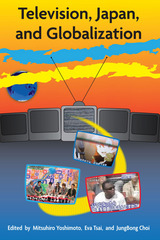 Television, Japan, and Globalization
Mitsuhiro Yoshimoto, Eva Tsai, and JungBong Choi, Editors
University of Michigan Press, 2010 Television, Japan, and Globalization makes a monumental contribution to the literature of television studies, which has increasingly recognized its problematic focus on US and Western European media, and a compelling intervention in discussions of globalization, through its careful attention to contradictory and complex phenomena on Japanese TV. Case studies include talent and stars, romance, anime, telops, game and talk shows, and live-action nostalgia shows. The book also looks at Japanese television from a political and economic perspective, with attention to Sky TV, production trends, and Fuji TV as an architectural presence in Tokyo. The combination of textual analysis, clear argument, and historical and economic context makes this book ideal for media studies audiences. Its most important contribution may be moving the study of Japanese popular culture beyond the tired truisms about postmodernism and opening up new lines of thinking about television and popular culture within and between nations.
Television, Nation, and Culture in Indonesia: Ris Sea#104
Philip Kitley
Ohio University Press, 2000 The culture of television in Indonesia began with its establishment in 1962 as a public broadcasting service. From that time, through the deregulation of television broadcasting in 1990 and the establishment of commercial channels, television can be understood, Philip Kitley argues, as a part of the New Order's national culture project, designed to legitimate an idealized Indonesian national cultural identity. But Professor Kitley suggests that it also has become a site for the contestation of elements of the New Order's cultural policies. Based on his studies, he further speculates on the increasingly significant role that television is destined to play as a site of cultural and political struggle.
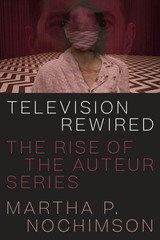 Television Rewired: The Rise of the Auteur Series
By Martha P. Nochimson
University of Texas Press, 2019 In 1990, American television experienced a seismic shift when Twin Peaks premiered, eschewing formulaic plots and clear lines between heroes and villains. This game-changing series inspired a generation of show creators to experiment artistically, transforming the small screen in ways that endure to this day. Focusing on six shows (Twin Peaks, with a critical analysis of both the original series and the 2017 return; The Wire; Treme; The Sopranos; Mad Men; and Girls), Television Rewired explores what made these programs so extraordinary. As their writers and producers fought against canned plots and moral simplicity, they participated in the evolution of the exhilarating new auteur television while underscoring the fact that art and entertainment don't have to be mutually exclusive. Nochimson also makes provocative distinctions between true auteur television and shows that were inspired by the freedom of the auteur series but nonetheless remained entrenched within the parameters of formula. Providing opportunities for vigorous discussion, Television Rewired will stimulate debates about which of the new television series since 1990 constitute “art” and which are tweaked “business-driven storytelling.”
 Television, Tabloids, and Tears: Fassbinder and Popular Culture
Jane Shattuc
University of Minnesota Press, 1995 Television, Tabloids, and Tears was first published in 1995. Minnesota Archive Editions uses digital technology to make long-unavailable books once again accessible, and are published unaltered from the original University of Minnesota Press editions. "I am Biberkopf," Rainer Werner Fassbinder declared, aligning himself with the protagonist of his widely seen television adaptation of Berlin Alexanderplatz. The statement provoked an unprecedented national debate about what constituted an acceptable German artist and who has the power to determine art. More than any recent German director, Fassbinder embodied this debate, and Jane Shattuc shows us how much this can tell us, not just about the man and his work, but also about the state of "culture" in Germany. It is fascinating in itself that Fassbinder, a highly controversial public figure, was chosen to direct Berlin Alexanderplatz, Germany's longest, costliest, and most widely viewed television drama. Shattuc exposes the dichotomy of institutional support for this project versus the scandalous controversial reputation of Fassbinder as a gay man who flaunted his sexuality and involvement with drugs. Fassbinder built his reputation on two separate images of the director-the faithful adapter and the underground star; with Berlin Alexanderplatz these two identities came together explosively. Tracing the two artistic paths that led Fassbinder to this moment, Shattuc offers us a look at cultural class divisions in Germany. Her account of Fassbinder's history as an Autor reveals both the triumph and the failure of bourgeois cultural domination in postwar West Germany.
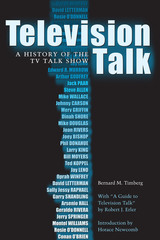 Television Talk: A History of the TV Talk Show
By Bernard M. Timberg
University of Texas Press, 2002 A CHOICE Outstanding Academic Book Flip through the channels at any hour of the day or night, and a television talk show is almost certainly on. Whether it offers late-night entertainment with David Letterman, share-your-pain empathy with Oprah Winfrey, trash talk with Jerry Springer, or intellectual give-and-take with Bill Moyers, the talk show is one of television's most popular and enduring formats, with a history as old as the medium itself. Bernard Timberg here offers a comprehensive history of the first fifty years of television talk, replete with memorable moments from a wide range of classic talk shows, as well as many of today's most popular programs. Dividing the history into five eras, he shows how the evolution of the television talk show is connected to both broad patterns in American culture and the economic, regulatory, technological, and social history of the broadcasting industry. Robert Erler's "A Guide to Television Talk" complements the text with an extensive "who's who" listing of important people and programs in the history of television talk.
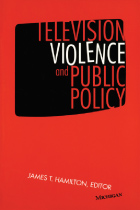 Television Violence and Public Policy
James T. Hamilton, Editor
University of Michigan Press, 2000 Since 1954, violence in television programming has been the subject of legislative debate, congressional hearings, agency pronouncements, and presidential commentary. Most recently, ratings of television programs have been discussed and implemented while other means of controlling the access to certain kinds of television programs have been discussed. The debate over the age-based program rating system recently implemented by the television industry has generated many questions about television violence.
The essays in the volume provide answers to many of these questions on specific policy issues surrounding media violence. The contributors suggest that the research on television violence can serve as the basis for a framework that categorizes programs based on the context in which the violence is presented. The manner in which information is conveyed about violent content affects how viewers react to such warnings. Program warnings with MPAA-style ratings have the potential to confuse parents (since they do not provide detailed content information) and attract some viewers such as teenage males.
The contributors include some of the top researchers in the field of communications, several of whom participated in the National Television Violence Study. Contributors are Eva Blumenthal, Joanne Cantor, Wayne Danielson, Ed Donnerstein, Tim Gray, Kristen Harrison, Cynthia Hoffner, Marlies Klijn, Marina Krcmar, Dale Kunkel, Dominic Lasorsa, Rafael Lopez, Dan Linz, Adriana Olivarez, James Potter, Stacy Smith, Matthew L. Spitzer, Ellen Wartella, D. Charles Whitney, and Barbara Wilson.
This volume will be of interest to communications researchers, media policy experts, legal scholars, government and industry officials, and social scientists interested in media and television.
James Hamilton is Director of the Program on Violence and the Media, Duke University.
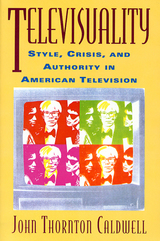 Televisuality
Caldwell, John T
Rutgers University Press, 1995
“Holling is tormented by Koyaanisqatsi dreams until he goes out and does the wild thing with a young stag . . . . ”––Synopsis from production company “Bible,” Northern Exposure, March 30, 1992
The collision of auteurism and rap––couched by primetime producers in the Northern Exposure script––was actually rather commonplace by the early 1990s. Series, and even news broadcasts, regularly engineered their narratives around highly coded aesthetic and cultural fragments, with a kind of ensemble iconography. Televisuality interrogates the nature of such performances as an historical phenomenon, an aesthetic and industrial practice, and as a socially symbolic act. This book suggests that postmodernism does not fully explain television's stylistic exhibitionism and that a reexamination of “high theory” is in order. Caldwell’s unique approach successfully integrates production practice with theory in a way that will enlighten both critical theory and cultural studies.
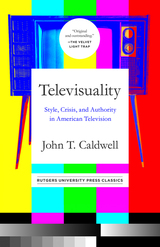 Televisuality: Style, Crisis, and Authority in American Television
John T Caldwell
Rutgers University Press, 2020 Although the "decline" of network television in the face of cable programming was an institutional crisis of television history, John Caldwell's classic volume Televisuality reveals that this decline spawned a flurry of new production initiatives to reassert network authority. Television in the 1980s hyped an extensive array of exhibitionist practices to raise the prime-time marquee above the multi-channel flow. Televisuality demonstrates the cultural logic of stylistic exhibitionism in everything from prestige series (Northern Exposure) and "loss-leader" event-status programming (War and Remembrance) to lower "trash" and "tabloid" forms (Pee-Wee's Playhouse and reality TV). Caldwell shows how "import-auteurs" like Oliver Stone and David Lynch were stylized for prime time as videographics packaged and tamed crisis news coverage. By drawing on production experience and critical and cultural analysis, and by tying technologies to aesthetics and ideology, Televisuality is a powerful call for desegregation of theory and practice in media scholarship and an end to the willful blindness of "high theory."
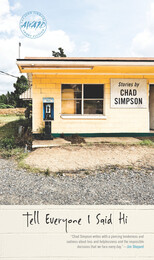 Tell Everyone I Said Hi
Chad Simpson
University of Iowa Press, 2012 The world of Tell Everyone I Said Hi is geographically small but far from provincial in its portrayal of emotionally complicated lives. With all the heartbreaking earnestness of a Wilco song, these eighteen stories by Chad Simpson roam the small-town playgrounds, blue-collar neighborhoods, and rural highways of Illinois, Indiana, and Kentucky to find people who’ve lost someone or something they love and have not yet found ways to move forward. Simpson’s remarkable voice masterfully moves between male and female and adolescent and adult characters. He embraces their helplessness and shares their sad, strange, and sometimes creepy slices of life with grace, humor, and mounds of empathy. In “Peloma,” a steelworker grapples with his preteen daughter’s feeble suicide attempts while the aftermath of his wife’s death and the politics of factory life vie to hem him in. The narrator of “Fostering” struggles to determine the ramifications of his foster child’s past now that he and his wife are expecting their first biological child. In just two pages, “Let x” negotiates the yearnings and regrets of childhood through mathematical variables and the summertime interactions of two fifth-graders. Poignant, fresh, and convincing, these are stories of women who smell of hairspray and beer and of landscapers who worry about their livers, of flooded basements and loud trucks, of bad exes and horrible jobs, of people who remain loyal to sports teams that always lose. Displaced by circumstances both in and out of their control, the characters who populate Tell Everyone I Said Hi are lost in their own surroundings, thwarted by misguided aspirations and long-buried disappointments, but fully open to the possibility that they will again find their way.
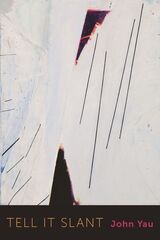 Tell it Slant
John Yau
Omnidawn, 2023 Poems that consider doubleness and truth-telling through the voice of an Asian American poet, while referencing a range of writers and pop culture figures.
Emily Dickinson begins one of her poems with the oft-quoted line, “Tell all the truth but tell it slant." For Asian Americans, the word “slant” can be heard and read two ways, as both a racializing and an obscuring term. It is this sense of doubleness—culminating in the instability of language and an untrustworthy narrator—that shapes, informs, and inflects the poems in John Yau’s new collection, all of which focus on the questions of who is speaking and who is being spoken for and to. Made up of eight sections, each exploring the idea of address—as place, as person, as memory, and as event —Tell It Slant does as Dickinson commands, but with a further twist. Yau summons spirits who help the author “tell all the truth,” among whom are reimagined traces of poets, movie stars, and science fiction writers, including Charles Baudelaire, Thomas de Quincey, Philip K. Dick, Li Shangyin, and Elsa Lanchester.
 Tell: Love, Defiance, and the Military Trial at the Tipping Point for Gay Rights
Major Margaret Witt
University Press of New England, 2017 In 1993 Margie Witt, a young Air Force nurse, was chosen as the face of the Air Force’s “Cross into the Blue” recruitment campaign. This was also the year that President Clinton’s plan for gays to serve openly in the military was quashed by an obdurate Congress, resulting in the blandly cynical political compromise known as Don’t Ask, Don’t Tell. Contrary to its intent, DADT had the perverse effect of making it harder for gay servicemen and -women to fight expulsion. Over the next seventeen years more than 13,000 gay soldiers, sailors, marines, coast guard, and airmen and -women were removed from military service. That is, until Margie Witt’s landmark case put a stop to it. Tell is the riveting story of Major Margaret Witt’s dedicated and decorated military career as a frontline flight nurse, and of her love and devotion to her partner—now wife—Laurie Johnson. Tell captures the tension and drama of the politically charged legal battle that led to the congressional repeal of the controversial law and helped pave the way for a suite of landmark political and legal victories for gay rights. Tell is a testament to the power of love to transform hearts and minds, as well as a celebration of the indomitable spirit of Major Witt, her wife Laurie, her dedicated legal team, and the brave men and women who came forward to testify on her behalf in a historic federal trial. “The name Margaret Witt may join the canon of US civil rights pioneers.” —Guardian “Major Witt’s trial provided an unparalleled opportunity to attack the central premise of [Don’t Ask, Don’t Tell] . . . and set an important precedent.”— New York Times “A landmark ruling.”—Politico
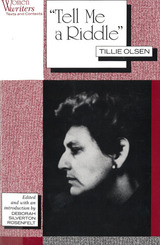 "Tell Me a Riddle": Tillie Olsen
Rosenfelt, Deborah S
Rutgers University Press, 1995 “Tell Me a Riddle” renders an unforgettable portrait of a working class couple when the gender determined differences in their experiences of poverty and familial life give rise to bitter conflict after almost four decades of marriage. As she dies from cancer, Eva, the protagonist, recollects a revolutionary past that both critiques and offers hope for the present. Deborah Rosenfelt’s introduction and the essays in this volume survey the critical reception of this highly acclaimed story, analyze its biographical and historical contexts, examine the text’s language, structure, spiritual and moral significance, and illuminate Olsen’s relationship to the American midwest, the American left, and the Jewish enlightenment tradition.
This casebook includes an introduction by the editor, a chronology of Olsen’s life, an authoritative text of “Tell Me a Riddle,” relevant essays by Olsen, seven critical essays, and a bibliography.
The contributors are: Joanne Trautmann Banks, Constance Coiner, Rachel Blau Duplessis, Mara Faulkner, Elaine Orr, Linda Ray Pratt, and Deborah Silverton Rosenfelt.
Tell Me a Story: Narrative and Intelligence
Roger C. Schank
Northwestern University Press, 1995 How are our memories, our narratives, and our intelligence interrelated? What can artificial intelligence and narratology say to each other? In this pathbreaking study by an expert on learning and computers, Roger C. Schank argues that artificial intelligence must be based on real human intelligence, which consists largely of applying old situations, and our narratives of them, to new situations in less than obvious ways.
Tell Me a Story, Sing Me a Song: A Texas Chronicle
By William A. Owens
University of Texas Press, 1983 Texas, the 1930s—the years of the Great Depression. It was the Texas of great men: Dobie, Bedichek, Webb, the young Américo Paredes. And it was the Texas of May McCord and "Cocky" Thompson, the Reverend I. B. Loud, the Cajun Marcelle Comeaux, the black man they called "Grey Ghost," and all the other extraordinary "ordinary" people whom William A. Owens met in his travels. "Up and down and sideways" across Texas, Owens traveled. His goal: to learn for himself what the diverse peoples of the state "believed in, yearned for, laughed at, fought over, as revealed in story and song." Tell me a story, sing me a song brings together both the songs he gathered—many accompanied by music—and Owens' warm reminiscences of his travels in the Texas of the Thirties and early Forties.
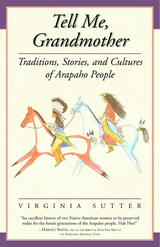 Tell Me, Grandmother: Traditions, Stories, and Cultures of Arapaho People
Virginia Sutter
University Press of Colorado, 2004 "[A] readable portrayal of both the acute losses and the cultural survival of the Arapaho people." - Watonga Republican "Virginia Sutter uses an interesting technique to write the history of her people, the Northern Arapaho Indian Nation. She constructs her work as a series of conversations between herself and her paternal great-grandmother. . . . [T]hrough this device, the history of the Arapaho people is traced from the early nineteenth-century years, when the buffalo ran aplenty and the prairies were boundless, through present-day living conditions in American Indian tribal reservations."
- Moira Richards, www.WomenWriters.net "Emblematic of the struggle of so many Native Americans of the twentieth century, who seek to reconcile modernity with tradition, and who struggle to recast, reframe, and restore what is Native, even as the majority culture has done its best to uproot, separate, and tell Natives that they can be either modern or Native, but certainly not both."
- Brian Hosmer, Studies in American Indian Literatures (SAIL) Tell Me, Grandmother is at once the biography of Goes-in-Lodge, a traditional Arapaho woman of the nineteenth century, and the autobiography of her descendant, Virginia Sutter, a modern Arapaho woman with a Ph.D. in public administration. Sutter adeptly weaves her own story with that of Goes-in-Lodge - who, in addition to being Sutter's great-grandmother, was first wife of Sharpnose, the last chief of the Northern Arapaho nation. Writing in a question-and-answer format between twentieth-century granddaughter and matriarchal ancestor, Sutter discusses four generations of home life, including details about child rearing, education, courtship, marriage, birthing, and burial. Sutter's portrait of Goes-in-Lodge is based on tribal history and interviews with tribal members. Goes-in-Lodge speaks of social and ceremonial gatherings, the Sun Dance, the sweat lodges, and the changes that took place on the Great Plains throughout her lifetime. Sutter details her own life as a child born in a teepee to a white mother and Indian father and the discrimination and injustice she faced struggling to make her way in an increasingly Euro-American world.
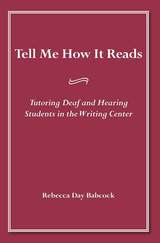 Tell Me How It Reads: Tutoring Deaf and Hearing Students in the Writing Center
Rebecca Day Babcock
Gallaudet University Press, 2012 Deaf students are attending mainstream postsecondary institutions in increasing numbers, raising the stakes for the complicated and multifaceted task of tutoring deaf students at these schools. Common tutoring practices used with hearing students do not necessarily work for deaf people. Rebecca Day Babcock researched and wrote Tell Me How It Reads: Tutoring Deaf and Hearing Students in the Writing Center to supply writing instructors an effective set of methods for teaching Deaf and other students how to be better writers.
Babcock’s book is based on the resulting study of tutoring writing in the college context with both deaf and hearing students and their tutors. She describes in detail sessions between deaf students, hearing tutors, and the interpreters that help them communicate, using a variety of English or contact signing rather than ASL in the tutorials. These experiences illustrate the key differences between deaf-hearing and hearing-hearing tutorials and suggest ways to modify tutoring and tutor-training practices accordingly. Although this study describes methods for tutoring deaf students, its focus on students who learn differently can apply to teaching writing to Learning Disabled students, ESL students, and other students with different learning styles. Ultimately, the well-grounded theory analysis within Tell Me How It Reads provides a complete paradigm for tutoring in all writing centers.
 Tell Me Lies: Propaganda and Media Distortion in the Attack on Iraq
Edited by David Miller
Pluto Press, 2003 Did the US and UK governments lie about weapons of mass destruction to promote an attack on Iraq?
Did the media hold them to account or act as cheerleaders for war?
Tell me Lies reveals the systematic propaganda used by both the US and UK governments to convince us of the 'threat' from Iraq. It shows how we were deliberately misled into a war that has resulted in a humanitarian disaster in Iraq and threatens to create further instability and resentment of the US and UK throughout the Middle East.
Written by some of the world's leading journalists and commentators, it's a scathing indictment of the role of the mainstream media in legitimising government actions and undermining dissent. Critics, activists and journalists from both sides of the Atlantic explore alternatives such as the internet and Al Jazeera and provide analysis and guidance on resisting the media war.
Contributors include John Pilger, Noam Chomsky, Robert Fisk, Edward Herman, Mark Thomas, Mark Steel, Phillip Knightley, Tim Llewelyn (BBC Middle East Correspondent), Abdul Hadi Jiad (Iraqi journalist sacked by the BBC before the war), David Cromwell and David Edwards (Media Lens), Mark Curtis, John Stauber and Sheldon Rampton (PR Watch, and co-authors of Weapons of Mass Deception and Toxic Sludge is Good For You), Pat Holland, Norman Solomon (columnist and director of the Institute for Public Accuracy), Nancy Snow (California State University, Fullerton, author of Propaganda Inc. and Information War), Doug Kellner (UCLA), Julian Petley, Yvonne Ridley (Aljazeera.net and author of In the Hands of the Taliban), Tim Gopsill (Campaign for Press and Broadcasting Freedom), Faisal Bodi (UK Guardian, Aljazeera.net), Alistair Alexander (Stop the War Coalition), Greg Philo (Glasgow University Media Group), Steve Dorrill, Andy Rowell, Granville Williams and cartoonists Steve Bell, Steve Caplin and Polyp.
Tell Me: Stories
Joe Baumann
Northwestern University Press, 2024 Queer stories about love, loneliness, the surreal, and the self
The stories in Tell Me feature queer men of various ages reckoning with loneliness, selfishness, and the struggle for self-discovery and identity. In “The Vanisher,” a young bisexual man struggling with his own desire to be seen receives a bandana that allows him to become invisible. In “Retreat,” a widower travels to an artists’ colony to seek an audience with his recently deceased husband. And in “We Are Rendered Silent,” people lose their ability to speak when a man they love dies. Through Baumann’s inventive employment of the strange and surreal, these stories set out to explore the bizarre and often confounding experience of navigating modern-day queerness. With his unique voice and magnificent imagination, Baumann fully immerses readers in the queer experience.
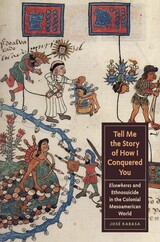 Tell Me the Story of How I Conquered You: Elsewheres and Ethnosuicide in the Colonial Mesoamerican World
By José Rabasa
University of Texas Press, 2011 Folio 46r from Codex Telleriano-Remensis was created in the sixteenth century under the supervision of Spanish missionaries in central Mexico. As an artifact of seismic cultural and political shifts, the manuscript painting is a singular document of indigenous response to Spanish conquest. Examining the ways in which the folio's tlacuilo (indigenous painter/writer) creates a pictorial vocabulary, this book embraces the place "outside" history from which this rich document emerged. Applying contemporary intellectual perspectives, including aspects of gender, modernity, nation, and visual representation itself, José Rabasa reveals new perspectives on colonial order. Folio 46r becomes a metaphor for reading the totality of the codex and for reflecting on the postcolonial theoretical issues now brought to bear on the past. Ambitious and innovative (such as the invention of the concepts of elsewheres and ethnosuicide, and the emphasis on intuition), Tell Me the Story of How I Conquered You embraces the performative force of the native scribe while acknowledging the ineffable traits of 46r—traits that remain untenably foreign to the modern excavator/scholar. Posing provocative questions about the unspoken dialogues between evangelizing friars and their spiritual conquests, this book offers a theoretic-political experiment on the possibility of learning from the tlacuilo ways of seeing the world that dislocate the predominance of the West.
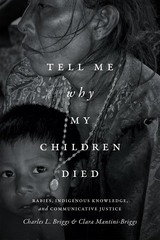 Tell Me Why My Children Died: Rabies, Indigenous Knowledge, and Communicative Justice
Charles L. Briggs and Clara Mantini-Briggs
Duke University Press, 2016 Tell Me Why My Children Died tells the gripping story of indigenous leaders' efforts to identify a strange disease that killed thirty-two children and six young adults in a Venezuelan rain forest between 2007 and 2008. In this pathbreaking book, Charles L. Briggs and Clara Mantini-Briggs relay the nightmarish and difficult experiences of doctors, patients, parents, local leaders, healers, and epidemiologists; detail how journalists first created a smoke screen, then projected the epidemic worldwide; discuss the Chávez government's hesitant and sometimes ambivalent reactions; and narrate the eventual diagnosis of bat-transmitted rabies. The book provides a new framework for analyzing how the uneven distribution of rights to produce and circulate knowledge about health are wedded at the hip with health inequities. By recounting residents' quest to learn why their children died and documenting their creative approaches to democratizing health, the authors open up new ways to address some of global health's most intractable problems.
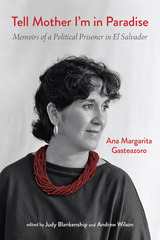 Tell Mother I'm in Paradise: Memoirs of a Political Prisoner in El Salvador
Ana Margarita Gasteazoro, edited by Judy Blankenship and Andrew Wilson
University of Alabama Press, 2022 The life and times of Ana Margarita Gasteazoro: political activist, clandestine operative, and prisoner of conscience
Ana Margarita Gasteazoro (1950–1993) was a Salvadoran opposition activist and renowned Amnesty International prisoner of conscience. Tell Mother I’m in Paradise:Memoirs of a Political Prisoner in El Salvador recounts her extraordinary life story. From a privileged Catholic upbringing, with time spent studying and working abroad, Ana Margarita first became a member of the legal political opposition in the late 1970s and later a clandestine operative at work against the brutal military junta.
Gasteazoro recounts her early rebellion against the strictures of conservative upper-class Salvadoran society. She spoke perfect English and discovered a talent for organizing in administrative jobs abroad and at home. As the civil war progressed, she quickly became a valued figure in the National Revolutionary Movement (MNR), a social democratic party, often representing it at international meetings. Against the backdrop of massive social oppression and the “disappearances” of thousands of opposition members, Gasteazoro began a double life as an operative in a faction of the Farabundo Martí National Liberation Front (FMLN). Multitalented and energetic, she organized safe houses for fellow activists, transported weapons and equipment, wrote scripts for an underground radio station, and produced an award-winning documentary film. But the toll on her family life and personal relationships was heavy.
Ana Margarita was disappeared in May 1981 by the infamous National Guard and endured a nightmare 11 days of interrogations, beatings, and abuse. Through international pressure and the connections of her family, her arrest was finally made public, and she was transferred to the women’s prison at Ilopango. There, she and other activists continued the political struggle through the Committee of Political Prisoners of El Salvador (COPPES). During her two years in prison, tested by hunger strikes, violence, and factional divisions, she became one of Amnesty International’s best-known prisoners of conscience. Tell Mother I’m in Paradise is a gripping story of a self-aware activist and a vital young woman’s struggle to find her own way within a deeply conservative society.
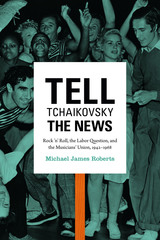 Tell Tchaikovsky the News: Rock 'n' Roll, the Labor Question, and the Musicians' Union, 1942-1968
Michael James Roberts
Duke University Press, 2014 For two decades after rock music emerged in the 1940s, the American Federation of Musicians (AFM), the oldest and largest labor union representing professional musicians in the United States and Canada, refused to recognize rock 'n' roll as legitimate music or its performers as skilled musicians. The AFM never actively organized rock 'n' roll musicians, although recruiting them would have been in the union's economic interest. In Tell Tchaikovsky the News, Michael James Roberts argues that the reasons that the union failed to act in its own interest lay in its culture, in the opinions of its leadership and elite rank-and-file members. Explaining the bias of union members—most of whom were classical or jazz music performers—against rock music and musicians, Roberts addresses issues of race and class, questions of what qualified someone as a skilled or professional musician, and the threat that records, central to rock 'n' roll, posed to AFM members, who had long privileged live performances. Roberts contends that by rejecting rock 'n' rollers for two decades, the once formidable American Federation of Musicians lost their clout within the music industry.
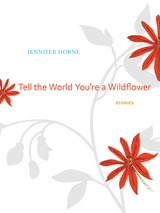 Tell the World You're a Wildflower: Stories
Jennifer Horne
University of Alabama Press, 2014 Tell the World You’re a Wildflower is a collection of loosely interwoven stories in the voices of southern women and girls of different ages and backgrounds. Beginning with the youngest characters and ending with the oldest, the stories encompass plastic surgery and white supremacists, family secrets and family trees, the United Daughters of the Confederacy and a young writer who describes her work in progress as “the bastard love-child of William Faulkner and Alice Walker.”
In Tell the World You’re a Wildflower, each character must decide what to tell, whether to tell it, and to whom to tell it. Each struggles with questions of identity and truth, trying to understand who she is and what holds true for her. Some tell their stories plainly, directly, others more obliquely, nesting one within another. Anchored in the tradition of southern storytelling, these women contend with loss, change, and growth while going to church, school, and prison, navigating love and sex, and worrying too much about what people might think.
Yet these women generally refuse to behave, and they wander in and out of each other’s stories just like people do in small towns across the South. Small town lives are always interconnected: your third-grade teacher is your new neighbor’s aunt and the boy you dated your senior year falls from political grace after being caught in a hot tub with your second cousin. Though they may have had little say in where they were planted, Horne’s protagonists nevertheless do their best to bloom.
Rich, multifaceted, and unforgettable, Tell the World You’re a Wildflower is the work of a veteran explorer of the twentieth and twenty-first century South. Horne’s quest to understand her culture through decades of reading and observing has now yielded these narratives that imaginatively and insightfully enter the hearts and minds of southern women.
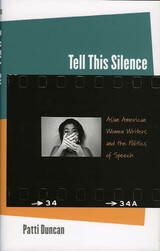 Tell This Silence: Asian American Women Writers And The Politics Of Speech
Patti Duncan
University of Iowa Press, 2004 Tell This Silence by Patti Duncan explores multiple meanings of speech and silence in Asian American women's writings in order to explore relationships among race, gender, sexuality, and national identity. Duncan argues that contemporary definitions of U.S. feminism must be expanded to recognize the ways in which Asian American women have resisted and continue to challenge the various forms of oppression in their lives. There has not yet been adequate discussion of the multiple meanings of silence and speech, especially in relation to activism and social-justice movements in the U.S. In particular, the very notion of silence continues to invoke assumptions of passivity, submissiveness, and avoidance, while speech is equated with action and empowerment.
However, as the writers discussed in Tell This Silence suggest, silence too has multiple meanings especially in contexts like the U.S., where speech has never been a guaranteed right for all citizens. Duncan argues that writers such as Maxine Hong Kingston, Mitsuye Yamada, Joy Kogawa, Theresa Hak Kyung Cha, Nora Okja Keller, and Anchee Min deploy silence as a means of resistance. Juxtaposing their “unofficial narratives” against other histories—official U.S. histories that have excluded them and American feminist narratives that have stereotyped them or distorted their participation—they argue for recognition of their cultural participation and offer analyses of the intersections among gender, race, nation, and sexuality.
Tell This Silence offers innovative ways to consider Asian American gender politics, feminism, and issues of immigration and language. This exciting new study will be of interest to literary theorists and scholars in women's, American, and Asian American studies.
Tell Toqaan, A Syrian Village
Louise E. Sweet
University of Michigan Press, 1960 Anthropologist Louise E. Sweet conducted her fieldwork in 1954 in Tell Toquaan, a Muslim Arab village in northwest Syria. In this volume, she presents her research: a thorough description of life in the village. She discusses in detail the geography and climate, history and language, settlement patterns, animal husbandry, agriculture, buildings and compounds, household technology and economics, commerce, division of labor, social structure, and ideology and ritual.
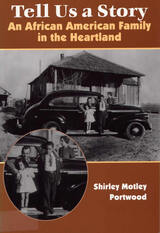 Tell Us a Story: An African American Family in the Heartland
Shirley Motley Portwood
Southern Illinois University Press, 2000 Illinois State Historical Society's Certificate of Excellence (2002)
Supplemented by recollections from the present era, Tell Us a Story is a colorful mosaic of African American autobiography and family history set in Springfield, Illinois, and in rural southern Illinois, Missouri, and Arkansas from the 1920s through the 1950s. Shirley Motley Portwood shares rural, African American family and community history through a collection of vignettes about the Motley family. Initially transcribed accounts of the Motleys’ rich oral history, these stories have been passed among family members for nearly fifty years. In addition to her personal memories, Portwood presents interviews with her father, three brothers, and two sisters plus notes and recollections from their annual family reunions. The result is a composite view of the Motley family. A historian, Portwood enhances the Motley family story by investigating primary data such as census, marriage, school, and land records, newspaper accounts, city directories, and other sources. The backbone of this saga, however, is oral history gathered from five generations, extending back to Portwood's grandparents, born more than one hundred years ago. Information regarding two earlier generations—her great- grandfather and great-great-grandparents, who were slaves—is based on historical research into state archives, county and local records, plantation records, and manuscript censuses. A rich source for this material—the Motley family reunions—are week-long retreats where four generations gather at the John Motley house in Burlington, Connecticut, the Portwood home in Godfrey, Illinois, or other locations. Here the Motleys, all natural storytellers, pass on the family traditions. The stories, ranging from humorous to poignant, reveal much about the culture and history of African Americans, especially those from nonurban areas. Like many rural African Americans, the Motleys have a rich and often joyful family history with traditions reaching back to the slave past. They have known the harsh poverty that made even the necessities difficult to obtain and the racial prejudice that divided whites and blacks during the era of Jim Crow segregation and inequality; yet they have kept a tremendous faith in self-improvement through hard work and education.
Tell Your Life Story: Creating Dialogue among Jews and Germans, Israelis and Palestinians
Dan Bar-On
Central European University Press, 2006 Describes Dan Bar-On's method of using storytelling as both a qualitative biographical research method and as an intervention, to bring people from opposite sides of an abyss to a dialogue. Such work needs slow pace and long-term commitment, with a special combination of a scientific rigorous analysis with a sensitive approach toward the people one approaches.
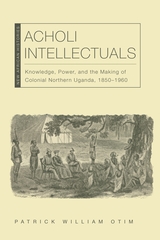 Teller Tales: Histories
Jo Carson
Ohio University Press, 2007 “All my work fits in my mouth,” Jo Carson says. “I write performance material no matter what else the pieces get called, and whether they are for my voice or other characters’ voices … they are first to be spoken aloud.” Following an oral tradition that has strong roots in her native Tennessee, the author of Teller Tales invites the reader to participate in events in a way that no conventional history book can. Both stories in this book are set in East Tennessee in the mid-eighteenth century and share certain characters. The first narrative, “What Sweet Lips Can Do,” recounts the story of the Overmountain Men and the battle of King’s Mountain, a tide-turning battle in the American Revolution. “Men of Their Time” is an exploration of white-Cherokee relationships from early contact through the time of the Revolution. Although not well known to the outside world, the stories recounted in Teller Tales are cornerstones in the heritage of the Appalachian region and of American history. In ways that will appeal to young and old alike, Jo Carson’s irreverent telling will broaden the audience and the understanding for the stories of native Americans, settlers, explorers, and revolutionaries of early America.
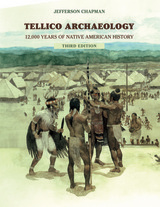 Tellico Archaeology: 12,000 Years Native American History
Jefferson Chapman
University of Tennessee Press, 2014 This book is an updated edition of Jefferson Chapman's 1985 account of one of the most productive and significant research efforts in the eastern United States. For fourteen years (1967–1981), archaeologists from the University of Tennessee conducted excavations and surveys in the Little Tennessee River Valley, which was being inundated by the TVA's creation of the Tellico Reservoir. The project produced a wealth of new information about more than 12,000 years of Native American history in the region.
This revision retains the full text and illustrations of the original edition, with its compelling descriptions of ancient ways of life and the archaeological detective work that was done to obtain that knowledge. The new material, contained in a postscript, summarizes the discoveries, research methods, and other developments that have, over the past ten years, further enhanced our knowledge of the Native Americans who occupied the area. Included, for example, are details about some fascinating new techniques for dating human remains, as well as discussions of burial practices, native crops, new archaeological laws, and the "Bat Creek Stone," a controversial artifact that, according to some claims, gives evidence of migrations of Mediterranean peoples to the New World during Roman times.
Jefferson Chapman is director of the Frank H. McClung Museum at the University of Tennessee, Knoxville, and a research associate professor in the department of anthropology.
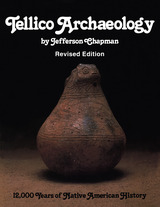 Tellico Archaeology Rev Ed: 12000 Years Native American History
Jefferson Chapman
University of Tennessee Press, 1995 This book is an updated edition of Jefferson Chapman's 1985 account of one of the most productive and significant research efforts in the eastern United States. For fourteen years (1967–1981), archaeologists from the University of Tennessee conducted excavations and surveys in the Little Tennessee River Valley, which was being inundated by the TVA's creation of the Tellico Reservoir. The project produced a wealth of new information about more than 12,000 years of Native American history in the region.
This revision retains the full text and illustrations of the original edition, with its compelling descriptions of ancient ways of life and the archaeological detective work that was done to obtain that knowledge. The new material, contained in a postscript, summarizes the discoveries, research methods, and other developments that have, over the past ten years, further enhanced our knowledge of the Native Americans who occupied the area. Included, for example, are details about some fascinating new techniques for dating human remains, as well as discussions of burial practices, native crops, new archaeological laws, and the "Bat Creek Stone," a controversial artifact that, according to some claims, gives evidence of migrations of Mediterranean peoples to the New World during Roman times.
The Author: Jefferson Chapman is director of the Frank H. McClung Museum at the University of Tennessee, Knoxville, and a research associate professor in the department of anthropology.
Telling a Research Story: Writing a Literature Review
Christine B. Feak and John M. Swales
University of Michigan Press, 2009 Telling a Research Story: Writing a Literature Review is concerned with the writing of a literature review and is not designed to address any of the preliminary processes leading up to the actual writing of the literature review. This volume represents a revision and expansion of the material on writing literature reviews that appeared in English in Today's Research World. This volume progresses from general to specific issues in the writing of literature reviews. It opens with some orientations that raise awareness of the issues that surround the telling of a research story. Issues of structure and matters of language, style, and rhetoric are then discussed. Sections on metadiscourse, citation, and paraphrasing and summarizing are included.
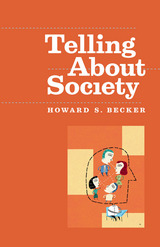 Telling About Society
Howard S. Becker
University of Chicago Press, 2007 I Remember, one of French writer Georges Perec’s most famous pieces, consists of 480 numbered paragraphs—each just a few short lines recalling a memory from his childhood. The work has neither a beginning nor an end. Nor does it contain any analysis. But it nonetheless reveals profound truths about French society during the 1940s and 50s.
Taking Perec’s book as its cue, Telling About Society explores the unconventional ways we communicate what we know about society to others. The third in distinguished teacher Howard Becker’s best-selling series of writing guides for social scientists, the book explores the many ways knowledge about society can be shared and interpreted through different forms of telling—fiction, films, photographs, maps, even mathematical models—many of which remain outside the boundaries of conventional social science. Eight case studies, including the photographs of Walker Evans, the plays of George Bernard Shaw, the novels of Jane Austen and Italo Calvino, and the sociology of Erving Goffman, provide convincing support for Becker’s argument: that every way of telling about society is perfect—for some purpose. The trick is, as Becker notes, to discover what purpose is served by doing it this way rather than that.
With Becker’s trademark humor and eminently practical advice, Telling About Society is an ideal guide for social scientists in all fields, for artists interested in saying something about society, and for anyone interested in communicating knowledge in unconventional ways.
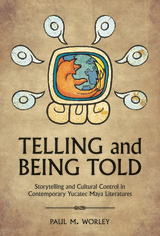 Telling and Being Told: Storytelling and Cultural Control in Contemporary Yucatec Maya Literatures
Paul M. Worley
University of Arizona Press, 2013 Through performance and the spoken word, Yucatec Maya storytellers have maintained the vitality of their literary traditions for more than five hundred years. Telling and Being Told presents the figure of the storyteller as a symbol of indigenous cultural control in contemporary Yucatec Maya literatures. Analyzing the storyteller as the embodiment of indigenous knowledge in written and oral texts, this book highlights how Yucatec Maya literatures play a vital role in imaginings of Maya culture and its relationships with Mexican and global cultures.
Through performance, storytellers place the past in dynamic relationship with the present, each continually evolving as it is reevaluated and reinterpreted. Yet non-indigenous actors often manipulate the storyteller in their firsthand accounts of the indigenous world. Moreover, by limiting the field of literary study to written texts, Worley argues, critics frequently ignore an important component of Latin America’s history of conquest and colonization: The fact that Europeans consciously set out to destroy indigenous writing systems, making orality a key means of indigenous resistance and cultural continuity.
Given these historical factors, outsiders must approach Yucatec Maya and other indigenous literatures on their own terms rather than applying Western models. Although oral literature has been excluded from many literary studies, Worley persuasively demonstrates that it must be included in contemporary analyses of indigenous literatures as oral texts form a key component of contemporary indigenous literatures, and storytellers and storytelling remain vibrant cultural forces in both Yucatec communities and contemporary Yucatec writing.
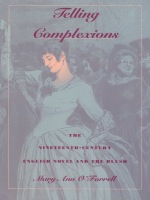 Telling Complexions: The Nineteenth-Century English Novel and the Blush
Mary Ann O Farrell
Duke University Press, 1997 In Telling Complexions Mary Ann O’Farrell explores the frequent use of "the blush" in Victorian novels as a sign of characters’ inner emotions and desires. Through lively and textured readings of works by such writers as Jane Austen, Elizabeth Gaskell, Charles Dickens, and Henry James, O’Farrell illuminates literature’s relation to the body and the body’s place in culture. In the process, she plots a trajectory for the nineteenth-century novel’s shift from the practices of manners to the mode of self-consciousness.
Although the blush was used to tell the truth of character and body, O’Farrell shows how it is actually undermined as a stable indicator of character in novels such as Pride and Prejudice, Persuasion, North and South, and David Copperfield. She reveals how these writers then moved on in search of other bodily indicators of mortification and desire, among them the swoon, the scar, and the blunder. Providing unique and creative insights into the constructedness of the body and its semiotic play in literature and in culture, Telling Complexions includes parallel examples of the blush in contemporary culture and describes ways that textualized bodies are sometimes imagined to resist the constraints imposed by such construction.
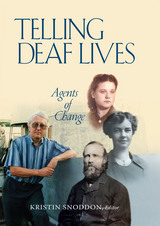 Telling Deaf Lives: Agents of Change
Kristin Snoddon
Gallaudet University Press, 2014 In July 2012, the 8th Deaf History International (DHI) Conference featured 27 presentations from members of Deaf communities around the world who related their own autobiographies as well as the biographies of historical Deaf individuals. The presenters came from 12 different countries, but their stories traverse many other locales. Thus, they created a transnational phenomenon of widespread interest in the collection, documentation, and dissemination of Deaf history by and for members of the deaf community. Telling Deaf Lives: Agents of Change brings together the best of the DHI Conference offerings in this volume.
Due to the dearth of formal research on deaf people, Deaf community historians drove the preservation of the stories in this collection. Their diversity is remarkable: Melissa Anderson and Breda Carty describe the Cosmopolitan Correspondence Club, a group of Deaf individuals who corresponded in the early 20th century from Australia to Western Europe to the United States; Ulla-Bell Thorin recounts first-hand growing up deaf in Sweden and her process in authoring six memoirs; Harry Lang reflects on writing biographies of numerous Deaf Americans in the arts and science; Akio Suemori profiles the first Deaf president of a Japanese school for the Deaf; Tatiana Davidenko writes about her Deaf family’s experience during the World War II siege of Leningrad; Theara Yim and Julie Chateauvert look at the evolution of ASL poetry by analyzing works of prominent ASL poets Clayton Valli, Peter Cook, and Kenny Lerner. These and the other contributions here enshrine Deaf people in collective memory by virtue of disseminating and preserving their stories.
The Telling Distance: Conversations with the American Desert
Bruce Berger
University of Arizona Press, 1990
Winner of the 1990 Western States Book Award for Creative Nonfiction,The Telling Distance evokes the yearning expanses of our southwestern deserts and finds them full of sensuous marvels, erratic life forms, eccentric fellow travelers, dry humor, and surprise. In prose that revels in paradox, it reveals desert distances to be doubly telling: they both magnify our spirit and have incomparable tales to tell.
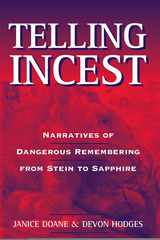 Telling Incest: Narratives of Dangerous Remembering from Stein to Sapphire
Janice Doane and Devon Hodges
University of Michigan Press, 2001 In the last decade, women's accounts of father-daughter incest have prompted much public debate. Are these accounts true? Are they false? Telling Incest, however, asks a different question: what does a believable incest story sound like and why?
Examining the work of writers from Gertrude Stein to Toni Morrison and Dorothy Allison, Telling Incest argues that an incest story's plausibility depends upon a shifting set of narrative conventions and cultural expectations. As contexts for telling incest stories have changed, so too have the tasks of those who tell and those who listen. The authors analyze both fictional and nonfiction narratives about father-daughter incest, beginning by scrutinizing the shadowy accounts found in nineteenth-century case records, letters, and narratives.
Telling Incest next explores African American stories that shift the blame for incest from the black family to the predations of a paternalistic white culture. Janice Doane and Devon Hodges demonstrate that writers drew upon this reworked incest narrative in the 1970s and early 1980s in order to relate a feminist story about incest, a story that criticizes patriarchal power. This feminist form of the story, increasingly emphasizing trauma and recovery, can be found in such popular books as Alice Walker's The Color Purple and Jane Smiley's A Thousand Acres. Doane and Hodges then examine recent memoirs and novels such as Dorothy Allison's Bastard Out of Carolina and Sapphire's Push, narratives that again rework the incest story in an effort to "tell" about women's complex experiences of subjugation and hope.
Telling Incest will be of particular interest to readers who have enjoyed the popular and culturally significant work of writers such as Alice Walker, Toni Morrison, Jane Smiley, and Dorothy Allison and to students of women's studies, feminist theory, and cultural studies.
Janice Doane is Professor of English, St. Mary's College of California. Devon Hodges is Professor of English, George Mason University. They have also coauthored From Klein to Kristeva: Psychoanalytic Feminism and the Search for the "Good Enough" Mother and Nostalgia and Sexual Difference: The Resistance to Contemporary Feminism.
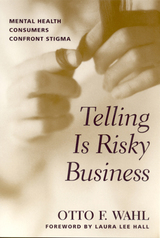 Telling is Risky Business: Mental Health Consumers Confront Stigma
Wahl, Otto F
Rutgers University Press, 1999 Individuals with a mental illnesses—such as schizophrenia, bipolar disorder, and depression—have a double burden, Otto Wahl writes. Not only must they cope with disabling disorders, but they also must contend with the negative attitudes of the public toward those disorders. To truly understand the full extent of this stigma, we need to hear from the consumers (the term used in this book for people with mental illness) themselves. Telling is Risky Business is the first book to examine what these people have to say about their own experiences of stigma. The center of Wahl’s research was a nationwide survey in which mental health consumers across the United States were asked, both through questionnaires and interviews, to tell about their experiences of stigma and discrimination. The research comes to life as many of the over 1,300 respondents’ acute observations are reported directly, in their own words. Telling is Risky Business vividly covers topics such as isolation, rejection, discouragement, and discrimination. Consumers also offer perceptive observations of how our society depicts people with mental illness. The book ends with suggestions for strategies and coping; an invaluable section on resources available for fighting stigma guarantees its place on many bookshelves. As Laura Lee Hall writes, “This book will likely open your eyes to a topic that you probably did not understand.”
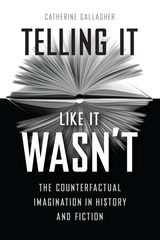 Telling It Like It Wasn’t: The Counterfactual Imagination in History and Fiction
Catherine Gallagher
University of Chicago Press, 2018 Inventing counterfactual histories is a common pastime of modern day historians, both amateur and professional. We speculate about an America ruled by Jefferson Davis, a Europe that never threw off Hitler, or a second term for JFK. These narratives are often written off as politically inspired fantasy or as pop culture fodder, but in Telling It Like It Wasn’t, Catherine Gallagher takes the history of counterfactual history seriously, pinning it down as an object of dispassionate study. She doesn’t take a moral or normative stand on the practice, but focuses her attention on how it works and to what ends—a quest that takes readers on a fascinating tour of literary and historical criticism.
Gallagher locates the origins of contemporary counterfactual history in eighteenth-century Europe, where the idea of other possible historical worlds first took hold in philosophical disputes about Providence before being repurposed by military theorists as a tool for improving the art of war. In the next century, counterfactualism became a legal device for deciding liability, and lengthy alternate-history fictions appeared, illustrating struggles for historical justice. These early motivations—for philosophical understanding, military improvement, and historical justice—are still evident today in our fondness for counterfactual tales. Alternate histories of the Civil War and WWII abound, but here, Gallagher shows how the counterfactual habit of replaying the recent past often shapes our understanding of the actual events themselves. The counterfactual mode lets us continue to envision our future by reconsidering the range of previous alternatives. Throughout this engaging and eye-opening book, Gallagher encourages readers to ask important questions about our obsession with counterfactual history and the roots of our tendency to ask “What if…?”
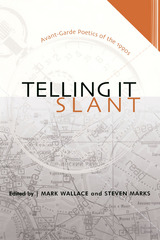 Telling It Slant: Avant Garde Poetics of the 1990S
Mark Wallace
University of Alabama Press, 2001 The finest essays from the newest generation of critics and poet-critics are gathered together in this volume documenting the growth in readership and awareness of avant-garde poetries. This collection demonstrates the breadth and openness of the field of avant-garde poetry by introducing a wide range of work in poetics, theory, and criticism from emerging writers. Examining the directions innovative poetry has taken since the emergence and success of the Language movement, the essays discuss new forms and the reorientation of older forms of poetry in order to embody present and ongoing involvements. The essays center around four themes: the relation between poetics and contemporary cultural issues; new directions for avant-garde practices; in-depth explorations of current poets and their predecessors; and innovative approaches to the essay form or individual poetics. Diverging from the traditional, linear argumentative style of academic criticism, many of the essays in this collection instead find critical forms more subtly related to poetry. Viewed as a whole, the essays return to a number of shared issues, namely poetic form and the production of present-day poetry. While focusing on North American poetry, the collection does reference the larger world of contemporary poetics, including potential biases and omissions based on race and ethnicity. This is cutting-edge criticism at its finest, essential reading for students and scholars of avant-garde poetry, of interest to anyone interested in contemporary American literature and poetry.
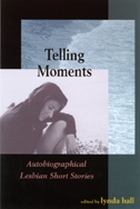 Telling Moments: Autobiographical Lesbian Short Stories
Edited by Lynda Hall
University of Wisconsin Press, 2003 Telling Moments collects contemporary short stories by a diverse group of twenty-four lesbian writers. Engaging themes of life and death, aging, motherhood, race, love, work, and travel, the writers offer brief glimpses into lesbian lives.
The stories are by well-known contemporary writers—Gloria Anzaldúa, Mary Cappello, Emma Donoghue, Jewelle Gomez, Karla Jay, Anna Livia, Valerie Miner, Lesléa Newman, Minnie Bruce Pratt, Ruthann Robson, Sarah Schulman, and Jess Wells—and exciting newer voices, such as Donna Allegra and Marion Douglas. There are also stories from performance artists Carmelita Tropicana, Peggy Shaw, and Maya Chowdhry. Anna Livia’s protagonist appreciates her mother’s artful garden creation. Ruthann Robson tells of a survivor of the health care system. In Marion Douglas’s story a teenager dances with an alluring classmate. Donna Allegra’s strong construction worker copes with the death of her mother. And Karla Jay sets her character forth to swim with sharks. Most of the stories are accompanied by an author photo, biographical sketch, and—a most significant feature—a commentary from the author on her writing process and the autobiographical nature of her story, illustrating the truth behind the fiction.
Telling Narratives: Secrets in African American Literature
Leslie W. Lewis
University of Illinois Press, 2007 Telling Narratives analyzes key texts from nineteenth- and early twentieth-century African American literature to demonstrate how secrets and their many tellings have become slavery's legacy. By focusing on the ways secrets are told in texts by Jessie Fauset, Charles W. Chesnutt, Pauline Hopkins, Frederick Douglass, and others, Leslie W. Lewis suggests an alternative model to the feminist dichotomy of "breaking silence" in response to sexual violence. This fascinating study also suggests that masculine bias problematically ignores female experience in order to equate slavery with social death. In calling attention to the sexual behavior of slave masters in African American literature, Lewis highlights its importance to slavery’s legacy and offers a new understanding of the origins of self-consciousness within African American experience.
Telling Rhythm: Body and Meaning in Poetry
Amittai Aviram
University of Michigan Press, 1994 In an era when poetry as a cultural force in the West appears to be waning, Telling Rhythm presents a hopeful and invigorating new approach to reading and interpreting poetry. At the same time, the book reviews a tradition of theorizing about poetry and suggests some innovations in literary theory itself that point to new ways of thinking about poetic texts.
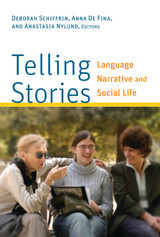 Telling Stories: Language, Narrative, and Social Life
Deborah Schiffrin, Anna De Fina, and Anastasia Nylund, Editors
Georgetown University Press, 2010 Narratives are fundamental to our lives: we dream, plan, complain, endorse, entertain, teach, learn, and reminisce through telling stories. They provide hopes, enhance or mitigate disappointments, challenge or support moral order and test out theories of the world at both personal and communal levels. It is because of this deep embedding of narrative in everyday life that its study has become a wide research field including disciplines as diverse as linguistics, literary theory, folklore, clinical psychology, cognitive and developmental psychology, anthropology, sociology, and history. In Telling Stories leading scholars illustrate how narratives build bridges among language, identity, interaction, society, and culture; and they investigate various settings such as therapeutic and medical encounters, educational environments, politics, media, marketing, and public relations. They analyze a variety of topics from the narrative construction of self and identity to the telling of stories in different media and the roles that small and big life stories play in everyday social interactions and institutions. These new reflections on the theory and analysis of narrative offer the latest tools to researchers in the fields of discourse analysis and sociolinguistics.
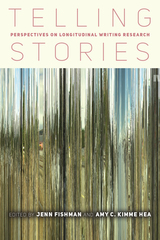 Telling Stories: Perspectives on Longitudinal Writing Research
Jenn Fishman
Utah State University Press, 2023 In Telling Stories, more than a dozen longitudinal writing researchers look beyond conventional project findings to story their work and, in doing so, offer otherwise unavailable glimpses into the logics and logistics of long-range studies of writing. The result is a volume that centers interrelations among people, places, and politics across two decades of praxis and an array of educational sites: two-year colleges, a senior military college, an adult literacy center, a small liberal arts college, and both public and private four-year universities. Contributors share direct knowledge of longitudinal writing research, citing project data (e.g., interview transcripts, research notes, and journals), descriptions drawn from memory, and extended personal reflections. The resulting stories, tempered by the research and scholarship of others, convey a sense of longitudinal research as a lived activity as well as a prominent and consequential approach to inquiry. Yet Telling Stories is not a how-to guide, nor is it written for longitudinal researchers alone. Instead, this volume addresses issues about writing research that are germane to all who conduct or count on it. Such topics include building and sustaining good interpersonal research relations, ethically negotiating the institutional power dynamics that undergird writing research, effectively using knowledge from longitudinal studies to advocate for writers and writing educators, and improving both conceptual and concrete resources for long-range research in writing studies.
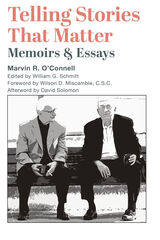 Telling Stories That Matter: Memoirs and Essays
Marvin R. O'Connell
St. Augustine's Press, 2020 The late historian Marvin O’Connell left a legacy of brilliant prose and pictures of the past, and in this book the reader at long last has access to O’Connell’s own story. Fr. Bill Miscamble, a noted historian and scholar in his own right, attributes to O’Connell the title ‘Master’ above all on account of his ability to know what matters and then write about it “in the way that all great stories are told.” In addition to his status as histor (giver of history), O’Connell was a long-time professor and chair of the history department at the University of Notre Dame. He is author of the masterwork, Sorin, which presents the riveting and dynamic narrative of the founding of Notre Dame on the inspired ambition of Edward Sorin, C.S.C. O’Connell was not a man who “genuflected in hagiography.” Rather, in the manner he lived faithfully yet soberly under the shining shadow of the Golden Dome, O’Connell told stories in the manner they were lived and with all the accompanying faults and triumphs. In Miscamble’s thorough introduction of O’Connell, he writes that the latter “utilized his striking talents as a historian as an integral part of his fundamental vocation as a priest. [O’Connell] once described the historian as a veritable ‘midwife to our faith,’ who must capture, as best as evidence will allow, the truth of the past.” This position lends itself to the structure of this work. The first part is the sadly incomplete memoirs of Fr. O’Connell, wherein the reader meets the historian and moves with eagerness and confidence into the essays that follow. Highlights of these collected essays include thoughts on Cardinal Newman, Belloc, the Spanish Inquisition, and the historical perspective of evangelization in the United States and modernism at large. What one reads are stories that might have been lost but are here preserved in what can with all moral certainty be called truthfulness. As his friend Ralph McInerny once qualified him, O’Connell combined compassion and judgment such that his histories were always indeed primarily stories and, as the reader well knows, stories have layers and threads and are not told simply for their conclusions. O’Connell succeeds in showing one how human history is written. Above all, he reveals that history is made by humans, but must also be remembered and deciphered by humans who cannot forego leaving their own marks and prints on everything they encounter (in memory or otherwise). The objectivity we seek can be found in one historical account alone, asserts the priest-storyteller, yet a sharp eye to the past is always consonant with a compassionate desire to understand. Bill Schmitt, Fr. Bill Miscamble and David Solomon do posterity a service by giving us this man and his masterful engagement of history. These friends of O’Connell deem the historian’s passion for truth-in-context to be foundational for shaping stories that matter, including his own. "This artful combination of memoir and selected essays reawakens our memory of Father O'Connell in all his immense personal charm, intellectual energy, rich erudition, keen wit, and steadfast dedication to his interlocking callings as priest and historian." —J. Philip Gleason, Emeritus Professor, History Department, University of Notre Dame "The work of a master historian, these memoirs and essays are reliable in recounting what happened, insightful in judging how and why, and eloquent in presenting it all with a flair and wit rarely equaled in historical writing. Moreover, they come forth from a Catholic faith so deep and secure that it need not be imposed on the reader. Rather, they do what good historical writing does, placing the reader into a past that can be seen and felt, recognized and understood. Whether it be his colorful accounts of the tumultuous life and times of Thomas More, or the valiant struggles of Newman and the Oxford Movement, or his own seminary training and teaching in St. Paul, or his fortunes as a graduate student at Notre Dame under the tutelage of the eminent Monsignor Phillip Hughes—whatever the topic, reading O’Connell’s history gives one the gift of being able to say, I remember that happening and I wasn’t even there!"—Michael J. Baxter, Director of Catholic Studies, Regis University in Denver "O'Connell was a master story teller. He was not, however, just a story teller. He was painstakingly rigorous in what and how he taught. His stories always perfectly illustrated a point, but they were never a substitution for the truth--rather an illustration of it." —Bradley Birzer, Russell Amos Kirk Chair in American Studies, Hillsdale College
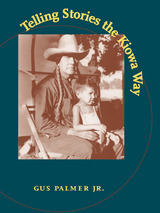 Telling Stories the Kiowa Way
Gus Palmer
University of Arizona Press, 2003 Among the Kiowa, storytelling takes place under familiar circumstances. A small group of relatives and close friends gather. Tales are informative as well as entertaining. Joking and teasing are key components. Group participation is expected. And outsiders are seldom involved. This book explores the traditional art of storytelling still practiced by Kiowas today as Gus Palmer shares conversations held with storytellers. Combining narrative, personal experience, and ethnography in an original and artful way, Palmer—an anthropologist raised in a traditional Kiowa family—shows not only that storytelling remains an integral part of Kiowa culture but also that narratives embedded in everyday conversation are the means by which Kiowa cultural beliefs and values are maintained. Palmer's study features contemporary oral storytelling and other discourses, assembled over two and a half years of fieldwork, that demonstrate how Kiowa storytellers practice their art. Focusing on stories and their meaning within a narrative and ethnographic context, he draws on a range of material, including dream stories, stories about the coming of Táimê (the spirit of the Sun Dance) to the Kiowas, and stories of tricksters and tribal heroes. He shows how storytellers employ the narrative devices of actively participating in oral narratives, leaving stories wide open, or telling stories within stories. And he demonstrates how stories can reflect a wide range of sensibilities, from magical realism to gossip. Firmly rooted in current linguistic anthropological thought, Telling Stories the Kiowa Way is a work of analysis and interpretation that helps us understand story within its larger cultural contexts. It combines the author's unique literary talent with his people's equally unique perspective on anthropological questions in a text that can be enjoyed on multiple levels by scholars and general readers alike.
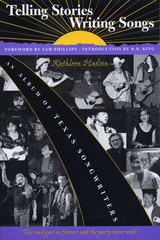 Telling Stories, Writing Songs: An Album of Texas Songwriters
By Kathleen Hudson
University of Texas Press, 2001 Willie Nelson, Joe Ely, Marcia Ball, Tish Hinojosa, Stevie Ray Vaughan, Lyle Lovett...the list of popular songwriters from Texas just goes on and on. In this collection of thirty-four interviews with these and other songwriters, Kathleen Hudson pursues the stories behind the songs, letting the singers' own words describe where their songs come from and how the diverse, eclectic cultures, landscapes, and musical traditions of Texas inspire the creative process. Conducted in dance halls, dressing rooms, parking lots, clubs-wherever the musicians could take time to tell their stories-the interviews are refreshingly spontaneous and vivid. Hudson draws out the songwriters on such topics as the sources of their songs, the influence of other musicians on their work, the progress of their careers, and the nature of Texas music. Many common threads emerge from these stories, while the uniqueness of each songwriter becomes equally apparent. To round out the collection, Hudson interviews Larry McMurtry and Darrell Royal for their perspectives as longtime friends and fans of Texas musicians. She also includes a brief biography and discography of each songwriter.
Telling the Little Secrets: American Jewish Writing since the 1980s
Janet Handler Burstein
University of Wisconsin Press, 2006 Janet Burstein argues that American Jewish writers since the 1980s have created a significant literature by wrestling with the troubled legacy of trauma, loss, and exile. Their ranks include Cynthia Ozick, Todd Gitlin, Art Spiegelman, Pearl Abraham, Aryeh Lev Stollman, Jonathan Rosen, and Gerda Lerner. Whether confronting the massive losses of the Holocaust, the sense of “home” in exile, or the continuing power of Jewish memory, these Jewish writers search for understanding within “the little secrets” of their dark, complicated, and richly furnished past.
 Telling the Technical Services Story: Communicating Value
Kimberley A. Edwards
American Library Association, 2021 Technical Services isn’t the hidden discipline it once was. Even so, despite all the cross-departmental interaction, misconceptions about the work are all too common. It’s incumbent on technical services staff to take a proactive approach by communicating to others their value to the library and institutional mission. Spotlighting several successful initiatives, this collection will give you the guidance to bolster communication within departments, across the library, and campus-wide. You’ll learn about - applying the 7 principles of communities of practice to break down silos;
- software such as Trello, Basecamp, and Confluence that can improve communications workflows;
- ticketing systems and training to help frontline staff solve e-resource access problems;
- engaging faculty in collection decisions using a mix of communication channels;
- how informational classes on metadata can improve the work of staff across the library;
- supporting research data management through metadata outreach;
- using focus groups to develop shared expectations with subject librarians;
- 4 narrative strategies to market library resources;
- using infographics as a dynamic way to illustrate progress in a collection management program;
- developing an external communication plan for a library de-selection project;
- using portfolio management to collaboratively implement new services; and
- planning a cross-departmental retreat.
 Telling the Truth: Titus Brandsma Among the Carmelite Martyrs of World War II
Paul Chandler
Catholic University of America Press, 2026 Titus Brandsma is best known for courageously speaking out against the ideology of National Socialism and for defending the freedom of the Catholic press to refuse their propaganda. Indeed, it was his activities as a Catholic journalist and on behalf of Catholic journalism that placed him in the crosshairs of the Nazi authorities. But his imprisonment and eventual death in the concentration camp of Dachau was preceded by a notable academic career and a life of tireless service.
As Paul Chandler reveals in this ground-breaking volume, the torture and “experiments” that he suffered in the infirmary at Dachau included shocking examples of sexual abuse, according to the infirmary nurse who administered the fatal injection, whose eye-witness account previous biographers have glossed over. For the first time, Chandler provides an English translation of her complete testimony.
Additional material reminds us of other major Carmelite “witnesses to truth” during World War II, including St. Edith Stein (Teresa Benedicta of the Cross) and Père Jacques Bunel. All of them show that authentic Carmelite and Christian spirituality is not something abstract and ethereal, but has social consequences, and that mystical prayer must express itself in prophetic words and actions.
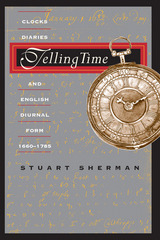 Telling Time: Clocks, Diaries, and English Diurnal Form, 1660-1785
Stuart Sherman
University of Chicago Press, 1997 A revolution in clock technology in England during the 1660s allowed people to measure time more accurately, attend to it more minutely, and possess it more privately than previously imaginable. In Telling Time, Stuart Sherman argues that innovations in prose emerged simultaneously with this technological breakthrough, enabling authors to recount the new kind of time by which England was learning to live and work.
Through brilliant readings of Samuel Pepys's diary, Joseph Addison and Richard Steele's daily Spectator, the travel writings of Samuel Johnson and James Boswell, and the novels of Daniel Defoe and Frances Burney, Sherman traces the development of a new way of counting time in prose—the diurnal structure of consecutively dated installments—within the cultural context of the daily institutions which gave it form and motion. Telling Time is not only a major accomplishment for seventeenth- and eighteenth-century literary studies, but it also makes important contributions to current discourse in cultural studies.
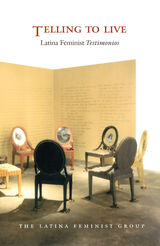 Telling to Live: Latina Feminist Testimonios
Latina Feminist Group
Duke University Press, 2001 Telling to Live embodies the vision that compelled Latina feminists to engage their differences and find common ground. Its contributors reflect varied class, religious, ethnic, racial, linguistic, sexual, and national backgrounds. Yet in one way or another they are all professional producers of testimonios—or life stories—whether as poets, oral historians, literary scholars, ethnographers, or psychologists. Through coalitional politics, these women have forged feminist political stances about generating knowledge through experience. Reclaiming testimonio as a tool for understanding the complexities of Latina identity, they compare how each made the journey to become credentialed creative thinkers and writers. Telling to Live unleashes the clarifying power of sharing these stories. The complex and rich tapestry of narratives that comprises this book introduces us to an intergenerational group of Latina women who negotiate their place in U.S. society at the cusp of the twenty-first century. These are the stories of women who struggled to reach the echelons of higher education, often against great odds, and constructed relationships of sustenance and creativity along the way. The stories, poetry, memoirs, and reflections of this diverse group of Puerto Rican, Chicana, Native American, Mexican, Cuban, Dominican, Sephardic, mixed-heritage, and Central American women provide new perspectives on feminist theorizing, perspectives located in the borderlands of Latino cultures. This often heart wrenching, sometimes playful, yet always insightful collection will interest those who wish to understand the challenges U.S. society poses for women of complex cultural heritages who strive to carve out their own spaces in the ivory tower. Contributors. Luz del Alba Acevedo, Norma Alarcón, Celia Alvarez, Ruth Behar, Rina Benmayor, Norma E. Cantú, Daisy Cocco De Filippis, Gloria Holguín Cuádraz, Liza Fiol-Matta, Yvette Flores-Ortiz, Inés Hernández-Avila, Aurora Levins Morales, Clara Lomas, Iris Ofelia López, Mirtha N. Quintanales, Eliana Rivero, Caridad Souza, Patricia Zavella
Telling Twain: A book of short stories by Mark Twain
Steve Daut
Parkhurst Brothers, Inc., 2019 Updated versions of Mark Twain classic stories in the best tradition of comedic writing. All of the stories were originally penned by Mark Twain, including "The Jumping Frog of Calaveras County." The author is a contemporary American storyteller who has included notes for readers and re-tellers in addition to an introduction that comments on Mr. Twain and the era in which his stories were written.
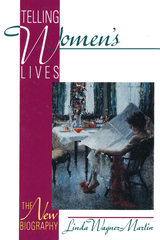 Telling Women's Lives: The New Biography
Wagner-Martin, Linda
Rutgers University Press, 1996 Placing herself in the avid reader’s chair, Linda Wagner-Martin writes about women’s biography from George Eliot and Virginia Woolf to Eleanor Roosevelt and Margaret Mead, and even to Cher and Elizabeth Taylor. Along the way, she looks at dozens of other life stories, probing at the differences between biographies of men and women, prevailing stereotypes about women’s lives and roles, questions about what is public and private, and the hazy margins between autobiography, biography, and other genres. In quick paced and wide-ranging discussions, she looks at issues of authorial stance (who controls the narrative? who chooses which story to tell?), voice (is this story told in the traditional objective tone? and if it is, what effect does that telling have on our reading?), and the politics of publishing (why aren’t more books about women’s lives published? and when they are, what happens to their advertising budgets?). She discusses the problems of writing biography of achieving women who were also wives (how does the biographer balance the two?), of daughters who attempt to write about their mothers, and of husbands trying to portray their wives.
Telling Women’s Lives is the first overview of the writing and the history of biographies about women. It is a significant contribution to the reassessment of the work of the hundreds of women writers who have made a difference in our conception of what women’s stories--and women’s lives--have been, and are becoming. The book is a must read for anyone who loves reading biographies, particularly biographies of women.
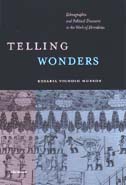 Telling Wonders: Ethnographic and Political Discourse in the Work of Herodotus
Rosaria Munson
University of Michigan Press, 2001 As he explores the causes of the East-West conflict from its most remote antecedents, Herodotus includes conflicting traditions about different historical periods as well as apparently tangential descriptions of the customs of faraway peoples. What was his aim in combining such diverse material? Rosaria Vignolo Munson argues that Herodotus' aim was two-fold: to use historical narrative to illuminate the present and to describe barbarian customs so that the Greeks might understand themselves. Herodotus assumes the role of advisor to his audience, acting as a master of metaphor and oracular speech and as an intellectual fully aware of new philosophical and political trends. By comparing, interpreting, and evaluating facts through time and space or simply by pointing them out as objects of "wonder," he teaches that correct political action is linked to an appropriate approach to foreigners and additional "others." Munson relies on traditional scholarship and modern studies in narratology and related critical fields to distinguish between narrative and metanarrative, providing a framework for analyzing the construction of Herodotus' discourse and his presentation of himself through it. Munson's work will be useful to classicists and ancient historians and will also engage anthropologists interested in cultural interaction and notions of ethnicity and literary critics interested in narrative constructions.
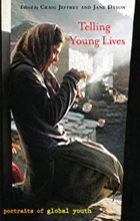 Telling Young Lives: Portraits of Global Youth
edited by Craig Jeffrey and Jane Dyson
Temple University Press, 2008 Telling Young Lives presents more than a dozen fascinating, ethnograph-ically informed portraits of young people facing rapid changes in society and politics from different parts of the world. From a young woman engaged in agricultural labor in the High Himalayas to a youth activist based in Tanzania, the distinctive voices from the U.K., India, Germany, Sierra Leone, South Africa and Bosnia Herzegovina, provide insights into the active and creative ways these youths are addressing social and political challenges such as war, hunger and homelessness. Telling Young Lives has great appeal for classroom use in geography courses and makes a welcome contribution to the growing field of “young geographies,” as well as to politics and political geography. Its focus on individual portraits gives readers a fuller, more vivid picture of the ways in which global changes are reshaping the actual experiences and strategies of young people around the world.
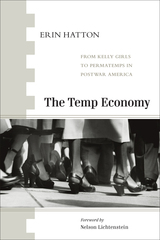 The Temp Economy: From Kelly Girls to Permatemps in Postwar America
Authored by Erin Hatton
Temple University Press, 2010 Everyone knows that work in America is not what it used to be. Layoffs, outsourcing, contingent work, disappearing career ladders—these are the new workplace realities for an increasing number of people. But why? In The Temp Economy, Erin Hatton takes one of the best-known icons of the new economy—the temp industry—and finds that it is more than just a symbol of this degradation of work. The temp industry itself played an active role in this decline—and not just for temps. Industry leaders started by inventing the "Kelly Girl," exploiting 1950s gender stereotypes to justify low wages, minimal benefits, and chronic job insecurity. But they did not stop with Kelly Girls. From selling human"business machines" in the 1970s to "permatemps" in the 1990s, the temp industry relentlessly portrayed workers as profit-busting liabilities that hurt companies' bottom lines even in boom times. These campaigns not only legitimized the widespread use of temps, they also laid the cultural groundwork for a new corporate ethos of ruthless cost cutting and mass layoffs. Succinct, highly readable, and drawn from a vast historical record of industry documents, The Temp Economy is a one-stop resource for anyone interested in the temp industry or the degradation of work in postwar America.
Temper
Beth Bachmann
University of Pittsburgh Press, 2009 Temper is at once violent and controlled, unflinching and unforgiving in temperament. The poems are mercilessly recursive, placing pressure on the lyric as a mode of both the elegiac and the ecstatic. The result is an enforced silence, urgent with grief.
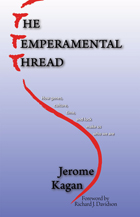 The Temperamental Thread: How Genes, Culture, Time and Luck make Us Who We Are
Jerome Kagan, Ph.D.
Dana Press, 2010
Temperament is the single most pervasive aspect of us and our fellow human beings. We notice it; we gossip about it; we make judgments based on it; we unconsciously shape our lives around it.
In The Temperamental Thread, developmental psychologist Jerome Kagan draws on decades of research to describe the nature of temperament—the in-born traits that underlie our responses to experience. Along the way he answers such questions as, How does the temperament we are born with affect the rest of our lives? Are we set at birth on an irrevocable path of optimism or pessimism? Must a fussy baby always become an anxious adult?
Kagan paints a picture of temperament as a thread that, when woven with those of life experiences, forms the whole cloth of an individual’s personality. He presents solid evidence to show how genes, gender, culture, and chance interact with temperament and influence a mature personality. He explains how temperament sets the stage for the many personality variations that we see all around us.
Research into temperament, powered by the new tools of neuroscience and psychological science, is enriching our understanding of others in every context, from our closest relationships to those in workplaces, schools, and even casual encounters. Jerome Kagan shows us how.
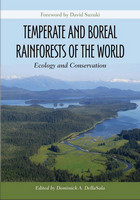 Temperate and Boreal Rainforests of the World: Ecology and Conservation
Edited by Dominick A. DellaSala
Island Press, 2010 While tropical rainforests have received much conservation attention and support for their protection, temperate and boreal rainforests have been largely overlooked. Yet these ecosystems are also unique, supporting rainforest communities rich in plants and wildlife and containing some of the most massive trees on Earth. Temperate and Boreal Rainforests of the World brings together leading scientists from around the world to describe the ecology and conservation of these lesser-known rainforests in an attempt to place them on par with tropical rainforests in conservation efforts. The book - summarizes major scientific findings
- presents new computer models that were used to standardize rainforest definitions
- identifies regions previously not widely recognized as rainforest
- provides the latest estimates on rainforest extent and degree of protection
- explores conservation strategies
The book ends with a summary of the key ecological findings and outlines an ambitious vision of how we can conserve and manage the planet's remaining temperate and boreal rainforests in a truly ecological way that is better for nature, the climate, and ultimately our own welfare. Temperate and Boreal Rainforests of the World is a call to action for an accord to protect the world's rainforests. It offers a global vision rooted in ecological science but written in common language useful for governments, decision makers, and conservation groups concerned about the plight of these remarkable forests.
Temperature Measurement and Control
J.R. Leigh
The Institution of Engineering and Technology, 1988 The temperature on earth varies over a wide range whereas man can only work comfortably in a quite narrow temperature range that has to be artificially maintained. In addition, many industries have extensive requirements for temperature control. Thus control engineers are called upon very frequently to design temperature control loops.
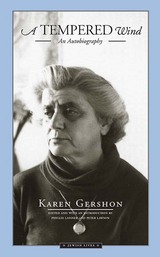 A Tempered Wind: An Autobiography
Karen Gershon
Northwestern University Press, 2010 Poet Karen Gershon opens A Tempered Wind, the sequel to volume 1 of her autobiography A Lesser Child, in 1943. It begins tragically with the death of Karen’s sister Anne in England, where they had escaped from Nazi Germany with their third sister Lise via the Kindertransport mission. A Tempered Wind proceeds to chart the difficult period from 1939 to 1943 as Karen adapts to a new culture and undertakes the complicated passage from adolescence to adulthood in the British Isles. Now orphans—their parents were murdered by the Nazis—the sisters are separated, and Karen is left haunted by feelings of abandonment by her sister as well as her parents who sent her away from them. Such feelings, along with her struggle with her imperiled Jewish identity, make their way into Karen’s writing, which includes stories, essays, and poems. In writing, she starts to find a home in language. Charting the creative growth of an astonishing Jewish author, A Tempered Wind concludes with Karen making her own urgent way as a writer with a mission to tell the world her archetypal German Jewish story.
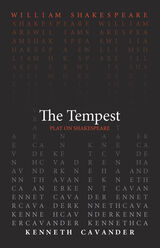 The Tempest
William Shakespeare
Arizona Center for Medieval and Renaissance Studies, 2021 Considered by most scholars to be the last play that Shakespeare wrote, The Tempest is a stormy tale of betrayal and forgiveness. After being banished by his brother Antonio, Prospero harnesses the magic of an otherworldly island full of monsters and spirits to seek revenge. In reworking this play for a twenty-first-century audience, Kenneth Cavander focuses on the humor and the magic in the tale, much of which has largely escaped modern audiences in recent years.
Cavander’s translation of The Tempest, which premiered at the Alabama Shakespeare Festival in 2017, was written as part of the Play On! Shakespeare project, an ambitious undertaking from the Oregon Shakespeare Festival that commissioned new translations of 39 Shakespeare plays. These translations present the Bard’s work in language accessible to modern audiences while never losing the beauty of Shakespeare’s verse. Enlisting the talents of a diverse group of contemporary playwrights, screenwriters, and dramaturges from diverse backgrounds, this project reenvisions Shakespeare for the twenty-first century. These volumes make these works available for the first time in print—a new First Folio for a new era.
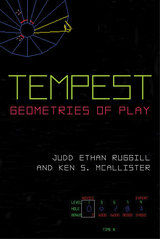 Tempest: Geometries of Play
Judd Ethan Ruggill and Ken S. McAllister
University of Michigan Press, 2015 Atari’s 1981 arcade hit Tempest was a “tube shooter” built around glowing, vector-based geometric shapes. Among its many important contributions to both game and cultural history, Tempest was one of the first commercial titles to allow players to choose the game’s initial play difficulty (a system Atari dubbed “SkillStep”), a feature that has since became standard for games of all types. Tempest was also one of the most aesthetically impactful games of the twentieth century, lending its crisp, vector aesthetic to many subsequent movies, television shows, and video games. In this book, Ruggill and McAllister enumerate and analyze Tempest’s landmark qualities, exploring the game’s aesthetics, development context, and connections to and impact on video game history and culture. By describing the game in technical, historical, and ludic detail, they unpack the game’s latent and manifest audio-visual iconography and the ideological meanings this iconography evokes.
 Tempest In The Caribbean
Jonathan Goldberg
University of Minnesota Press, 2003 Places sexuality at the center of Caribbean responses to Shakespeare's play.
Shakespeare's The Tempest has long been claimed by colonials and postcolonial thinkers alike as the dramatic work that most enables them to confront their entangled history, recognized as early modernity's most extensive engagement with the vexing issues of colonialism--race, dispossession, language, European displacement and occupation, disregard for native culture.
Tempest in the Caribbean reads some of the "classic" anticolonial texts--by Aimé Césaire, Roberto Fernández Retamar, George Lamming, and Frantz Fanon, for instance--through the lens of feminist and queer analysis exemplified by the theoretical essays of Sylvia Wynter and the work of Michelle Cliff. Extending the Tempest plot, Goldberg considers recent works by Caribbean authors and social theorists, among them Patricia Powell, Jamaica Kincaid, and Hilton Als. These rewritings, he suggests, and the lived conditions to which they testify, present alternatives to the masculinist and heterosexual bias of the legacy that has been derived from The Tempest.
By placing gender and sexuality at the center of the debate about the uses of Shakespeare for anticolonial purposes, Goldberg's work points to new possibilities that might be articulated through the nexus of race and sexuality.
Jonathan Goldberg is Sir William Osler Professor of English Literature at The Johns Hopkins University. His previous books include Shakespeare's Hand (2003), Desiring Women Writing (1997), Sodometries (1992), and, as editor, Reclaiming Sodom (1994) and Queering the Renaissance (1994).
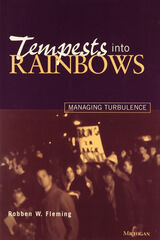 Tempests into Rainbows: Managing Turbulence
Robben W. Fleming
University of Michigan Press, 1996 Robben W. Fleming was President of the University of Michigan during the turmoil of the Vietnam era. He brought a clear and effective philosophy to the challenges he faced as manager and leader in a turbulent time. Fleming recounts the dramatic confrontations and demonstrations at Michigan over the war in Vietnam, military research in universities, the investment of university endowment funds in South African enterprises, and black student campaigns for improved conditions on campus. Robben W. Fleming has much to teach. There are lessons for all who face the challenges of leadership in this lively and readable autobiography of one who has displayed grace, style and effectiveness in difficult and sometimes threatening situations. Tempests into Rainbows also explores the influences on his life that nurtured his exceptional ability to create agreement and to solve conflict. The story of his formative years is filled with both humor and pathos. Fleming writes about local personalities, the deaths of his "twin" brother and father, and the difficulties of the family during the economic recession of the 1920s and 1930s. Academic and athletic prowess enabled him to put himself through college and law school, emerging just in time to serve as a military government officer with troops in North Africa and Europe. After World War II, Fleming became a specialist in labor-management relations, teaching at the University of Illinois and serving as a professional mediator and arbitrator of labor disputes. Then in 1964 he became Chancellor of the University of Wisconsin in Madison, and later President of the University of Michigan until 1979. Although he remains active as a consultant deploying his mediation skills, his last career position was as President of the Corporation for Public Broadcasting. This unusual autobiography, appealing in its honesty and in the original story it has to tell, is also instructive in showing how a thoughtful person with a humane, consistent philosophy can manage when chaos and turmoil threaten. It will thus appeal not only to those who knew Fleming and who have ties to the universities in which he served, but also to all who manage and study the management of complex institutions. "Robben Fleming has written a fascinating memoir, especially his intensely personal account of the trials and terrors that faced this university president as Ann Arbor's student body--and he came to grips with the civil rights revolution and the Vietnam War." ---Mike Wallace "To relive Robben Fleming's life is to relive an American epoch. There was a time when America was at war with its enemies, and a time when America was at war with itself. He writes perceptively from both battlegrounds." ---Daniel Schorr "Robben Fleming is a giant--a creative and imaginative leader of exceptional talent. All of us can learn from the lessons of his life. His book is a treasure." ---Newton N. Minow
 Templars and Hospitallers as Professed Religious in the Holy Land
Jonathan Riley-Smith
University of Notre Dame Press, 2009
"In this book, Jonathan Riley-Smith provides an approachable and expert introduction to the two most famous and most active military orders, the Knights Templar and Knights Hospitaller, and their activities in the Levant. It is a first-rate study, energetically and engagingly written by the world's most accomplished historian of the crusades." --Thomas Madden, St. Louis University
"The image of the military orders is mostly dominated by their military, political, or economic role while their spirituality and their religious character are often neglected. This book, from a great authority on crusading and military orders, offers an inspiring new perspective. Its chapters, concise and well-founded studies concentrating on the inner life of Templars and Hospitallers in the Holy Land, will thus contribute to a considerably better understanding of their history." --Juergen Sarnowsky, Universitaet Hamburg
"Jonathan Riley-Smith, Grand Master of Hospitaller studies since the 1960s, offers the first systematic comparison of the two earliest, most famous, and most researched Military Orders--the Temple and the Hospital. Contrasting the Templars' exclusive commitment to warfare with the Hospitaller dedication to the care of the sick and poor as well as to warfare, Riley-Smith persuasively argues that this disparity influenced decisively not only the internal stratification and the governance of the two Orders, but also their chances of survival. The book, which will have a major impact on future studies, amounts also to an act of love for the Hospital." --Benjamin Z. Kedar, The Hebrew University of Jerusalem
"There is no historian better equipped to define the nature of the two great orders of the Hospital and the Temple than Jonathan Riley-Smith. In this concise analysis he brings to bear his great depth of experience not only to show the similarities and differences between the two orders, but also to place them firmly in their contemporary context." --Malcolm Barber, University of Reading, UK
The Templars and the Hospitallers were the two earliest and most famous of the major Military Orders of the Roman Catholic Church from the early twelfth to the middle of the thirteenth century. In this book, Jonathan Riley-Smith attends to the Templars' and Hospitallers' primary role as religious orders, not as military phenomena or economic powerhouses. In a prologue, four chapters, and an epilogue, Riley-Smith discusses the origins of the orders in dedication to the protection of pilgrims to the Holy Land (Templars) and to the care of the poor and the sick among them (Hospitallers). He examines their traditions and early history, the organization of their communities, modes of governance, and, in the fourth chapter, important differences between the orders and a brief account of their respective fates in the wake of the Crusades. The Templars were eventually persecuted by the Church and the order suppressed. Riley-Smith speculates that the violent end of the order was caused both by jealousy of its wealth and by internal problems of governance that left it vulnerable to accusations of conducting blasphemous rites. The Hospitallers survived in one form or another to the present day; vestiges of the original order inform the contemporary Knights of Malta.
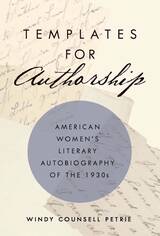 Templates for Authorship: American Women's Literary Autobiography of the 1930s
Windy Counsell Petrie
University of Massachusetts Press, 2021 As autobiographies by famous women like Eleanor Roosevelt and Amelia Earhart became bestsellers in the 1930s, American publishers sought out literary autobiographies from female novelists, poets, salon hosts, and editors. Templates for Authorship analyzes the market and cultural forces that created an unprecedented boom in American women's literary autobiography.
Windy Counsell Petrie considers twelve autobiographies from a diverse group of writers, ranging from highbrow modernists such as Gertrude Stein and Harriet Monroe to popular fiction writers like Edith Wharton and Edna Ferber, and lesser known figures such as Grace King and Carolyn Wells. Since there were few existing examples of women's literary autobiography, these writers found themselves marketed and interpreted within four cultural templates: the artist, the activist, the professional, and the celebrity. As they wrote their life stories, the women adapted these templates to counter unwanted interpretations and resist the sentimental feminine traditions of previous generations with innovative strategies of deferral, elision, comedy, and collaboration. This accessible study contends that writing autobiography offered each of these writers an opportunity to define and defend her own literary legacy.
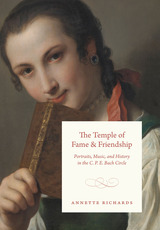 The Temple of Fame and Friendship: Portraits, Music, and History in the C. P. E. Bach Circle
Annette Richards
University of Chicago Press, 2020 This book examines the renowned portrait collection assembled by C. P. E. Bach, J. S. Bach’s second son.
One of the most celebrated German composers of the eighteenth century, C. P. E. Bach spent decades assembling an extensive portrait collection of some four hundred music-related items—from oil paintings to engraved prints. The collection was dispersed after Bach’s death in 1788, but with Annette Richards’s painstaking reconstruction, the portraits once again present a vivid panorama of music history and culture, reanimating the sensibility and humor of Bach’s time. Far more than a mere multitude of faces, Richards argues, the collection was a major part of the composer’s work that sought to establish music as an object of aesthetic, philosophical, and historical study.
The Temple of Fame and Friendship brings C. P. E. Bach’s collection to life, giving readers a sense of what it was like for visitors to tour the portrait gallery and experience music in rooms thick with the faces of friends, colleagues, and forebears. She uses the collection to analyze the “portraitive” aspect of Bach’s music, engaging with the influential theories of Swiss physiognomist Johann Caspar Lavater. She also explores the collection as a mode of cultivating and preserving friendship, connecting this to the culture of remembrance that resonates in Bach’s domestic music. Richards shows how the new music historiography of the late eighteenth century, rich in anecdote, memoir, and verbal portrait, was deeply indebted to portrait collecting and its negotiation between presence and detachment, fact and feeling.
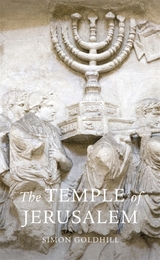 The Temple of Jerusalem
Simon Goldhill
Harvard University Press, 2005 It was destroyed nearly 2,000 years ago, and yet the Temple of Jerusalem—cultural memory, symbol, and site—remains one of the most powerful, and most contested, buildings in the world. This glorious structure, imagined and re-imagined, reconsidered and reinterpreted again and again over two millennia, emerges in all its historical, cultural, and religious significance in Simon Goldhill’s account.
Built by Herod on a scale that is still staggering—on an earth and rock platform 144,000 square meters in area and 32 meters high—and destroyed by the Roman emperor Titus 90 years later, in 70 AD, the Temple has become the world’s most potent symbol of the human search for a lost ideal, an image of greatness. Goldhill travels across cultural and temporal boundaries to convey the full extent of the Temple’s impact on religious, artistic, and scholarly imaginations. Through biblical stories and ancient texts, rabbinical writings, archaeological records, and modern accounts, he traces the Temple’s shifting significance for Jews, Christians, and Muslims.
A complex and engaging history of a singular locus of the imagination—a site of longing for the Jews; a central metaphor of Christian thought; an icon for Muslims: the Dome of the Rock—The Temple of Jerusalem also offers unique insight into where Judaism, Christianity, and Islam differ in interpreting their shared inheritance. It is a story that, from the Crusades onward, has helped form the modern political world.
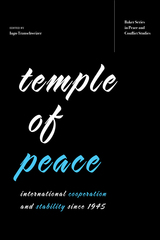 Temple of Peace: International Cooperation and Stability since 1945
Ingo Trauschweizer
Ohio University Press, 2021 This collection raises timely questions about peace and stability as it interrogates the past and present status of international relations. The post–World War II liberal international order, upheld by organizations such as the United Nations, the North Atlantic Treaty Organization, and similar alliances, aspired to ensure decades of collective security, economic stability, and the rule of law. All of this was a negotiated process that required compromise—and yet it did not make for a peaceful world. When Winston Churchill referred to the UN framework as “the temple of peace” in his famous 1946 Iron Curtain speech, he maintained that international alliances could help provide necessary stability so free people could prosper, both economically and politically. Though the pillars of international order remain in place today, in a world defined as much by populism as protest, leaders in the United States no longer seem inclined to serve as the indispensable power in an alliance framework that is built on shared values, human rights, and an admixture of hard and soft power. In this book, nine scholars and practitioners of diplomacy explore both the successes and the flaws of international cooperation over the past seventy years. Collectively, the authors seek to address questions about how the liberal international order was built and what challenges it has faced, as well as to offer perspectives on what could be lost in a post-American world.
 Temple of Science: The Pre-Raphaelites and Oxford University Museum of Natural History
John Holmes
Bodleian Library Publishing, 2020 Built between 1855 and 1860, the Oxford University Museum of Natural History is the extraordinary result of close collaboration between artists and scientists. The architect Benjamin Woodward consulted with two groups on the design and decoration of the building: a panel of Oxford scientists and dons, and the society of artists known as the Pre-Raphaelite Brotherhood. The museum's decorative art was modeled on the Pre-Raphaelites' principle of meticulous observation of nature, itself indebted to science. The structure was an experiment in using architecture and art to communicate natural history, modern science, and natural theology. Temple of Science sets out the history of the campaign to build the museum before taking the reader on a tour of the art found in the museum itself. It looks at the façade and the central court, the natural history carvings and marble columns illustrating different geological strata, and the meticulously carved sculptures of influential scientists. With unique insights and lavish illustrations, Temple of Science tells the story of one of the most remarkable collaborations between scientists and artists in European art.
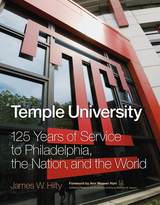 Temple University: 125 Years of Service to Philadelphia, the Nation, and the World
James W. Hilty with Matthew M. Hanson, foreword by Ann Weaver Hart
Temple University Press, 2010 Temple University's alumni number over a quarter million, andinclude entertainment legend Bill Cosby and Shirley Tilghman, the first woman president of Princeton University. One of every eight college graduates in the Philadelphia area received their degrees at Temple. Temple Owls are everywhere!
Temple University: 125 Years of Service to Philadelphia, the Nation, and the World, by noted historian and Temple professor James Hilty offers the first full history of Temple University. Lovingly written and beautifully designed, it presents a rich chronicle from founder Russell Conwell’s vision to democratize, diversify, and broaden the reach of higher education to Temple's present-day status as the twenty-eighth largest university and the fifth largest provider of professional education in the United States. With its state-of-the-art technological capabilities, improved amenities, and new multi-million- dollar facilities, Temple remains at the forefront of America’s modern urban universities.
The book captures Temple’s long record of service to its North Philadelphia neighbors, its global reach to Rome, Tokyo, and beyond, and its development from a rowhouse campus into a lively 11,000- resident urban village—all the while assuring “Access to Excellence.” Along the way, we learn how Temple reacted to and helped shape major developments in the history of American higher education.
Featuring 250 full-color photos, Temple University provides a wonderful keepsake for those who already know the university and will become a valued resource for anyone interested in the urban university.
Temples for Cahokia Lords: Preston Holder's 1955–1956 Excavations of Kunnemann Mound
Timothy R. Pauketat with contributions by John R. Bozell, Sandra L. Dunavan, and a foreword by John O'Shea
University of Michigan Press, 1993 Preston Holder, a brilliant iconoclast, excavated these mounds in 1955. Decades later, the excavation still stands as one of the best-documented major excavations of the Cahokia area. This volume, meticulously researched and written, is the book Holder never completed. Pauketat also includes the massive research and theoretical developments that have emerged since 1957.
Temples Of Justice: County Courthouses Of Nevada
Ronald M. James
University of Nevada Press, 1994 From Storey County's High Victorian Italianate-styled courthouse to Lander County's former schoolhouse, now a Neo-classical courthouse, Temples of Justice provides an architectural history of the courthouses of Nevada. In Nevada's first published architectural history, Temples of Justice treats the state's buildings as a series of documents from the past. Presented collectively the courthouses illustrate the choices and influences that have affected Nevada's communities as the citizens have sought to project an image of themselves and their aspirations through public architecture. The courthouses are important local public facilities, and they provide an excellent opportunity to understand the history of attitudes and tastes in the state.
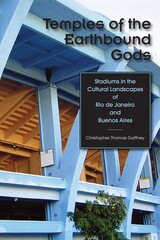 Temples of the Earthbound Gods: Stadiums in the Cultural Landscapes of Rio de Janeiro and Buenos Aires
By Christopher Thomas Gaffney
University of Texas Press, 2008 In Rio de Janeiro, the spiritual home of world football, and Buenos Aires, where a popular soccer club president was recently elected mayor, the game is an integral part of national identity. Using the football stadium as an illuminating cultural lens, Temples of the Earthbound Gods examines many aspects of urban culture that play out within these monumental architectural forms, including spirituality, violence, rigid social norms, anarchy, and also expressions of sexuality and gender. Tracing the history of the game in Brazil and Argentina through colonial influences as well as indigenous ball courts in Mayan, Aztec, Zapotec, Mixtec, and Olmec societies, Christopher Gaffney's study spans both ancient and contemporary worlds, linking the development of stadiums to urbanization and the consolidation of nation building in two of Latin America's most intriguing megacities.
The Templeton Plan: 21 Steps to Personal Success and Real Happiness
John Marks Templeton
Templeton Press, 2011 John Templeton believes that his financial accomplishments are directly related to his strong convictions. Now he shares the secrets of his phenomenal success in twenty-one principles that provide readers with solid guidelines for prosperity and happiness. Templeton maintains that the common denominator connecting successful people with successful enterprises is a devotion to ethical and spiritual principles. He emphasizes the “laws of life”—truthfulness, perseverance, thrift, enthusiasm, humility, and altruism—that can help everyone discover and develop their individual abilities. A Giniger Book formerly published by Harper & Row in 1987
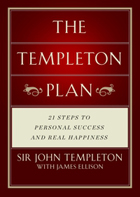 Templeton Plan: 21 Steps to Personal Success and Real Happiness
Sir John Templeton
Templeton Press, 2013 Sir John Templeton (1912–2008), the Wall Street legend who has been described as “arguably the greatest global stock picker of the twentieth century,” clearly knew what it took to be successful. The most important thing, he observed, was to have strong convictions that guided your life—this was the common denominator he saw in all successful people and enterprises. Fortunately for us, he was eager to share his own blueprint for personal success and happiness with the rest of the world. In The Templeton Plan, he laid out the twenty-one guiding principles by which he governed both his professional and personal life. These principles were grounded in virtues that he considered important enough to be considered the “laws of life”—they include honesty, perseverance, thrift, enthusiasm, humility, and altruism. From this moral foundation, Templeton formulated a step-by-step plan to help improve anyone’s personal and professional life. Among the steps he enumerates, readers will find: · Four exercises that will help anyone find the positive in every negative · How to be the one person in ten that will productively use more time than they waste · The secret trait that separates great workers from good workers · How to control your thoughts for effective action · The practical applications of a sense of humility · How successful people approach risks differently from most people Taken as a whole, the lessons contained within his twenty-one steps will help readers make lasting friendships, reap significant financial rewards, and find personal satisfaction. Ever a believer in the future’s vast potential, Templeton hoped that sharing his principles would inspire others to seek their own laws of life, formulate their own plans, and find success and happiness on a scale exponentially greater than his own. He freely admitted that he didn’t know everything and that there was yet much to be discovered about prosperity and joy. The Templeton Plan not only offers his recipe for success, but also shows us the way to formulate our own plans.
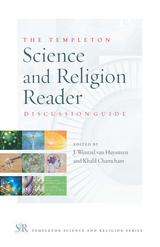 Templeton Science and Religion Book Series Bundle
J. Wetzel van Huysssteen
Templeton Press, 2013 In the Templeton Science and Religion Series, scientists from a wide range of fields distill their experience and knowledge into brief tours of their respective specialties. The series was launched in 2008 with the publication of Harold G. Koenig’s book, Medicine, Religion, and Health. Since that time, the series editors J. Wentzel van Huyssteen and Khalil Chamcham have expanded it to nine titles covering everything from paleontology, to neuroscience, to technology. Also found in the bundle is the TSR Reader and a companion study guide.
The books found in the bundle are: •Medicine, Religion, and Health by Harold G. Koenig, •Neuroscience, Psychology and Religion by Malcolm Jeeves and Warren Brown •Technology and Religion by Noreen Herzfeld •Horizons of Cosmology by Joseph Silk •Paleontology by Ian Tttersall •Cognitive Science, Religion, and Theology by Justin L. Barrett •Ecology and the Environment by R. J. Berry •The Language of Genetics by Denis Alexander •Mathematics and Religion by Javier Leach •The Templeton Science and Religion Reader •The Templeton Science and Religion Study Guide This bundle is only sold in e-book format!
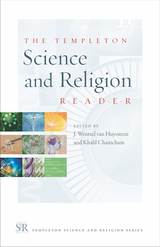 The Templeton Science and Religion Reader
J. Wetzel van Huysssteen
Templeton Press, 2012
Our attempts to understand the world around us are greatly advanced by scientific research, which holds nearly unlimited potential to address our questions of what? and how? Some scientific fields, however, seem to take a hands-off approach to the big question of why? Why does the universe work the way it does? Why do our brains make us think certain thoughts or feel certain sensations? Why did we evolve the way we did? Some fundamental scientific understanding is necessary before one can venture too deeply into these types of inquiries, which almost inevitably involve larger philosophical and theological implications. The Templeton Science and Religion Reader invites readers to explore some of these fascinating questions and offers them the kind of knowledge they’ll need in order to seriously consider possible answers.
In the Templeton Science and Religion Series, scientific experts from a wide range of fields have distilled their experience and knowledge into brief tours of their respective specialties. The series was launched in 2008 with the publication of the inaugural volume, Medicine, Religion, and Health. Since that time, the series editors J. Wentzel van Huyssteen and Khalil Chamcham have expanded it to nine titles covering everything from paleontology to neuroscience to technology. Now, in The Templeton Science and Religion Reader, the editors have gathered together the very best chapters from these volumes into a single edited collection.
These chapters presuppose no scientific background and are designed to be accessible to the general reader. Each section may have a different focus—a quantum, a star in a galaxy, a bee, or the seat of human intelligence, which some may call the soul—but the editors have done a great service to the reader by juxtaposing these subjects in a way that suggests how each one relates to other entities, including both its own kind and the wider global environment. The end result is a truly cohesive collection that will both broaden and deepen our understanding of these interconnected relations and, in turn, the world around us.
Contributors include Denis R. Alexander, Justin L. Barrett, R. J. Berry, Warren S. Brown, Noreen Herzfeld, Malcom Jeeves, Harold G. Koenig, Javier Leach, Joseph Silk, and Ian Tattersall.
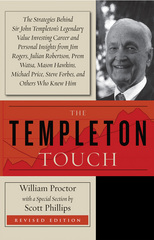 The Templeton Touch
William Proctor
Templeton Press, 2012 Although John Templeton (1912–2008) simply considered himself a bargain hunter, those in the know on Wall Street considered him one of the greatest stock pickers of the twentieth century. Anyone prudent enough to have invested $10,000 in his Templeton Growth Fund when it was first established in 1954 would today have over $7 million to their name if they left those funds alone. Few mutual funds can match that kind of spectacular and consistent performance.
How did he do it? What kind of principles guided his decisions through bull and bear markets? What was the secret to his success? Fortunately, generosity was one of Templeton’s defining characteristics, and he freely shared his investing wisdom with the world in The Templeton Touch. This edition, which has been greatly expanded and revised from the original 1983 publication, gives the reader an inside look at the mindset that made Templeton a Wall Street legend. His global focus, his relentless curiosity, his future-mindedness, his personal touch with clients, his willingness to take reasonable risks, his reliance on deep research and fundamental analysis— everything that set him apart from the crowd is covered here in great detail by authorized biographer William Proctor. This updated edition also contains a new section comprised of twenty-two interviews with those who knew and worked with Templeton, conducted by Scott Phillips. Among those interviewed are business luminaries like Jim Rogers, Julian Robertson, Steve Forbes, Prem Watsa, Mason Hawkins, and Michael Price.
The Templeton Touch should be required reading for any investor, from the absolute novice to the most experienced. Not only could Templeton’s practical advice help guide investors through tricky market conditions, but the many insights into his character and his philosophies could help anyone live a more successful life.
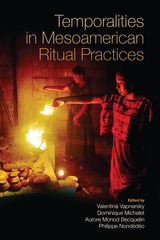 Temporalities in Mesoamerican Ritual Practices
Valentina Vapnarsky
University Press of Colorado, 2024 Temporalities in Mesoamerican Ritual Practices examines the time-based dimensions of ritual activities in past and present Mesoamerican societies, including the prehispanic, colonial, and modern periods. The authors explore ritual around three principal categories of action—creating, transforming, and destroying—as significant cultural manifestations of the temporal dimension of transition processes.
Based on specific case studies, new analysis of fieldwork data, and long-term collaboration between authors, chapters engage empirically and theoretically with the multiple temporalities of ritual in relation to both the unfolding of ritual performance and its external and symbolic anchors. Taking rituals as a series of specific, formalized actions that produce transitory changes within an initial context, the authors examine activities that generate change linked to artifact production, life cycles, healing, conflict resolution, crisis management, the enthronement of rulers and transfers of responsibilities, and practices relating to the occupation, abandonment, reuse, or conversion of socialized spaces.
Adopting a multidisciplinary approach in archaeology, ethnohistory, anthropology, and linguistic anthropology, Temporalities in Mesoamerican Ritual Practices offers new insights into ritual time approached through multi-semiotic, material, sensorial, and pragmatic perspectives that encourage further interdisciplinary dialogue.
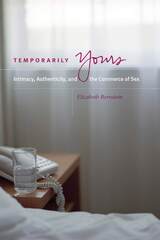 Temporarily Yours: Intimacy, Authenticity, and the Commerce of Sex
Elizabeth Bernstein
University of Chicago Press, 2007 Generations of social thinkers have assumed that access to legitimate paid employment and a decline in the ‘double standard’ would eliminate the reasons behind women’s participation in prostitution. Yet in both the developing world and in postindustrial cities of the West, sexual commerce has continued to flourish, diversifying along technological, spatial, and social lines. In this deeply engaging and theoretically provocative study, Elizabeth Bernstein examines the social features that undergird the expansion and diversification of commercialized sex, demonstrating the ways that postindustrial economic and cultural formations have spawned rapid and unforeseen changes in the forms, meanings, and spatial organization of sexual labor.
Drawing upon dynamic and innovative research with sex workers, their clients, and state actors, Bernstein argues that in cities such as San Francisco, Stockholm, and Amstersdam, the nature of what is purchased in commercial sexual encounters is also new. Rather than the expedient exchange of cash for sexual relations, what sex workers are increasingly paid to offer their clients is an erotic experience premised upon the performance of authentic interpersonal connection. As such, contemporary sex markets are emblematic of a cultural moment in which the boundaries between intimacy and commerce—and between public life and private—have been radically redrawn. Not simply a compelling exploration of the changing landscape of sex-work, Temporarily Yours ultimately lays bare the intimate intersections of political economy, desire, and culture.
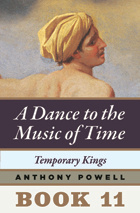 Temporary Kings: Book 11 of A Dance to the Music of Time
Anthony Powell
University of Chicago Press, 1995 Anthony Powell’s universally acclaimed epic A Dance to the Music of Time offers a matchless panorama of twentieth-century London. Now, for the first time in decades, readers in the United States can read the books of Dance as they were originally published—as twelve individual novels—but with a twenty-first-century twist: they’re available only as e-books.
In this penultimate volume, Temporary Kings (1973), Nick and his contemporaries are at the height of their various careers in the arts, business, and politics. X. Trapnel is dead, but his mystery continues to draw ghoulish interest from readers and academics alike—as well as from his lover, Pamela Widmerpool. Kenneth Widmerpool, meanwhile, is an MP with mysterious connections beyond the newly dropped Iron Curtain, but he continues to be tormented by Pamela; a spectacular explosion, Nick can’t help but realize, is imminent. "Anthony Powell is the best living English novelist by far. His admirers are addicts, let us face it, held in thrall by a magician."--Chicago Tribune
"A book which creates a world and explores it in depth, which ponders changing relationships and values, which creates brilliantly living and diverse characters and then watches them grow and change in their milieu. . . . Powell's world is as large and as complex as Proust's."--Elizabeth Janeway, New York Times
"One of the most important works of fiction since the Second World War. . . . The novel looked, as it began, something like a comedy of manners; then, for a while, like a tragedy of manners; now like a vastly entertaining, deeply melancholy, yet somehow courageous statement about human experience."--Naomi Bliven, New Yorker “The most brilliant and penetrating novelist we have.”--Kingsley Amis
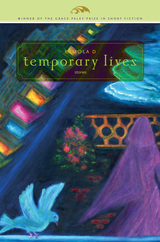 Temporary Lives: Stories
Ramola Dharmaraj
University of Massachusetts Press, 2010 These ten memorable stories explore interior worlds and moments of intensity, either awakening or loss, in the lives of diverse characters—mostly young girls and married women, but also boys and long-laboring men. Whether Hindu, Muslim, or Christian, they are all burdened by the complex layerings of class and gender, and are variously able or unable to find escape from the conditions of oppression that surround them. Some manage to rise above their situations by experiencing the denials and hardships of their lives as temporary; others find no such relief.
In the title story, Rose Ammal, who married young and bore numerous children, survives her husband's betrayal and religious conversion by creating her own private redemptions and conversions. "The Next Corpse Collector" chronicles significant moments in the lives of two young brothers, Anwar and Amir, who seek to escape the destiny of corpse
collector, the job their father is determined to bequeath to them. "What the Watchman Saw" offers a glimpse into the life of Venkatesh, a longtime watchman who is faced with the dilemma of whether to report the theft of stolen antiquities from the house of his new neighbor.
"Esther" is a tale of the haunting, troubled spirit of Leeza's grandmother, who lingers in Leeza's childhood home and unexpectedly helps her during the summer her grandfather dies as she wakes to an adolescent infatuation with a neighbor boy. In "The Couple in the Park," a young middle-class wife, Laura, in a constrictive arranged marriage, finds comfort in watching a couple in the park who remind her of her own grandparents as she tips over the edge into schizophrenia. "The Man on the Veranda" traces a significant day in the life of retired government-worker Parameswaran—the day his wife finally leaves him.
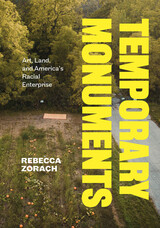 Temporary Monuments: Art, Land, and America's Racial Enterprise
Rebecca Zorach
University of Chicago Press, 2024 How art played a central role in the design of America’s racial enterprise—and how contemporary artists resist it.
Art has long played a key role in constructing how people understand and imagine America. Starting with contemporary controversies over public monuments in the United States, Rebecca Zorach carefully examines the place of art in the occupation of land and the upholding of White power in the US, arguing that it has been central to the design of America’s racial enterprise. Confronting closely held assumptions of art history, Zorach looks to the intersections of art, nature, race, and place, working through a series of symbolic spaces—the museum, the wild, islands, gardens, home, and walls and borders—to open and extend conversations on the political implications of art and design.
Against the backdrop of central moments in American art, from the founding of early museums to the ascendancy of abstract expressionism, Zorach shows how contemporary artists—including Dawoud Bey, Theaster Gates, Maria Gaspar, Kerry James Marshall, Alan Michelson, Dylan Miner, Postcommodity, Cauleen Smith, and Amanda Williams—have mined the relationship between environment and social justice, creating works that investigate and interrupt White supremacist, carceral, and environmentally toxic worlds. The book also draws on poetry, creative nonfiction, hip-hop videos, and Disney films to illuminate crucial topics in art history, from the racial politics of abstraction to the origins of museums and the formation of canons.
Temporary Power Systems: A guide to the application of BS 7671 and BS 7909 for temporary events
James Eade
The Institution of Engineering and Technology, 2014 This book provides the reader with a clear understanding of the application of both BS 7671 and BS 7909 to events and other relevant industry guidance. It is an indispensable guide for all those working with any temporary power system including agricultural shows and outdoors fairs, concerts, theatrical events, film and TV broadcasting, exhibitions, festivals as well as temporary buildings and structures.
Temporary Stages II: Critically Oriented Drama Education
Jo Beth Gonzalez
Intellect Books, 2013 Theater teachers are forced to adapt constantly. Whether responding to advancing technologies, cuts to (or the growth of) their program, or ever-changing governmental mandates, they struggle to serve both their students and their craft. Using a theater arts program at one at a Midwestern high school, this book explores how change, good or ill, directly impacts students as well as teachers. Building on the work of the previous edition of Temporary Stages, Jo Beth Gonzalez shows teachers how to sustain confidence and outlines “critically conscious” teaching, a technique that encourages students to practice self-agency and critical awareness. Essential reading for all theater teachers, this indispensable resource is a font of innovative classroom and production practices.
Temptation in the Archives: Essays in Golden Age Dutch Culture
Lisa Jardine
University College London, 2015 Temptation in the Archives is a collection of essays by Lisa Jardine, that takes readers on a journey through the Dutch Golden Age. Through the study of such key figures as Sir Constantjin Huygens, a Dutch polymath and diplomat, we begin to see the Anglo-Dutch cultural connections that formed during this period against the backdrop of unfolding political events in England.Temptation in the Archives paints a picture of a unique relationship between the Netherlands and England in the 17th century forged through a shared experience – and reveals the lessons we can learn from it today.
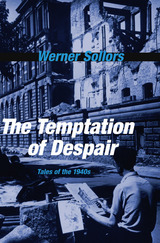 The Temptation of Despair: Tales of the 1940s
Werner Sollors
Harvard University Press, 2014 In Germany, the years immediately following World War II call forward images of obliterated cities, hungry refugees, and ghostly monuments to Nazi crimes. The temptation of despair was hard to resist, and to contemporary observers the road toward democracy in the Western zones of occupation seemed rather uncertain. Drawing on a vast array of American, German, and other sources—diaries, photographs, newspaper articles, government reports, essays, works of fiction, and film—Werner Sollors makes visceral the experiences of defeat and liberation, homelessness and repatriation, concentration camps and denazification.
These tales reveal writers, visual artists, and filmmakers as well as common people struggling to express the sheer magnitude of the human catastrophe they witnessed. Some relied on traditional images of suffering and death, on Biblical scenes of the Flood and the Apocalypse. Others shaped the mangled, nightmarish landscape through abstract or surreal forms of art. Still others turned to irony and black humor to cope with the incongruities around them. Questions about guilt and complicity in a totalitarian country were raised by awareness of the Holocaust, making “After Dachau” a new epoch in Western history.
The Temptation of Despair is a book about coming to terms with the mid-1940s, the contradictory emotions of a defeated people—sorrow and anger, guilt and pride, despondency and resilience—as well as the ambiguities and paradoxes of Allied victory and occupation.
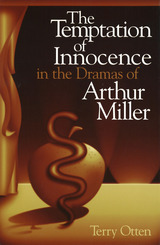 The Temptation of Innocence in the Dramas of Arthur Miller
Terry Otten
University of Missouri Press, 2002
For a half century Arthur Miller has been more than a dramatist. He has been a chronicler of American culture, which he has both celebrated and criticized. The Temptation of Innocence in the Dramas of Arthur Miller examines all of Miller’s plays, from his unpublished undergraduate dramas written at the University of Michigan to Mr. Peters’ Connections, his last performed play. Terry Otten offers a broad critical review and assessment of Miller’s plays in light of the major revival of Miller’s work in the past decade and a growing critical reassessment of his work by the scholarly community.
Focusing on the temptation of innocence, a recurrent theme in Miller’s work, Otten explores the conflict between innocence and personal responsibility, from such widely acclaimed early plays as Death of a Salesman, which forges a “tragedy of the common man,” to his later, near postmodern texts, which treat memory in very different ways. Still locating the presentness of the past as a center of meaning in characters who follow Willy Loman, Miller continues to investigate the role innocence plays in the lives of his more modern characters.
Otten contends that, for over a half century, Miller examined the relationship between self and society in remarkably consistent terms while adapting his art to contemporary changes in concepts of reality. Fully documented and thoroughly researched, this book will prove a valuable source for later studies of Miller and a standard reference for examining the entire range of the plays. Otten avoids critical jargon, making this book an appealing choice for a general audience interested in literature and American culture.
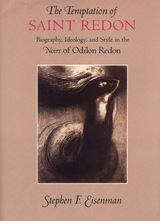 The Temptation of Saint Redon: Biography, Ideology, and Style in the Noirs of Odilon Redon
Stephen F. Eisenman
University of Chicago Press, 1992 Bristling with demons, grotesques, and bizarre apparitions, the graphic work of Odilon Redon has often seemed to be the product of a mind unhinged. In The Temptation of Saint Redon, Stephen F. Eisenman argues instead that these works are Redon's conscious and considered response to changing social realities—an attempt to find refuge from the forces of modernization in an imaginative world of the macabre and the fantastic. Eisenman's careful attention to the circumstances of Redon's life (1840-1916) allows him to bring into focus the interconnections between Redon's complex style and the culture and society of his time. Born and raised on a sixteenth-century estate near Bordeaux, Redon was immersed as a child in traditional rural culture. "I spent my entire childhood in the Médoc completely free, among peasant children," he recalled in his memoirs. "I heard them tell supernatural tales—witches still exist there."
Indeed, local tales and legends of witches, ghosts, one-eyed monsters, evil eyes, and wood fairies figure prominently in Redon's graphic works, which he called his noirs, or "blacks." After formal training at Bordeaux and Paris in the 1850s and 1860s, Redon began to chart his independent artistic course. Eisenman shows how, rejecting both naturalism and classicism, Redon, a prototypical Symbolist, found in grotesque and epic genres the expression of organic communities and precapitalist societies. He places Redon's desire for this imagined world of superstitious simplicity a desire manifest in his entire mature artistic practice in the context of contemporary avant-garde movements.
Redon's great noirs of the 1870s and 1880s, dreamlike configurations of seemingly irreconcilable elements from portraits, still lifes, and landscapes, show an increasingly subtle control of connotation and a complex indebtedness to caricature, allegory, and puns. Many of the noirs also visually interpret works by like-minded authors, including Baudelaire, Flaubert, Poe, and Mallarmé, one of Redon's close friends. Eisenman's analysis of the noirs underscores Redon's interest in creating an imaginative, even fantastic art, that could act directly on the human spirit. In addition to deepening our understanding of Redon and his art, The Temptation of Saint Redon exposes a link between place, politics, personal history, and the artistic imagination.
Temptation of the Word: The Novels of Mario Vargas Llosa
Efrain Kristal
Vanderbilt University Press, 1998 Choice Outstanding Academic Book 1998
Temptation of the Word offers an ambitious and careful reading of the creative process--the origin of themes and the development of literary techniques--that Mario Vargas Llosa has brought to each of his novels, published through 1996. To understand the novelist's intellectual environment, Efrain Kristal analyzes the entire corpus of Vargas Llosa's writings, his literary influences in several languages, his intellectual biography, and his political activism, all in the light of the evolving political turbulence of his times and his own changing concept of literature.
The Temptation to Exist
E. M. Cioran
University of Chicago Press, 1998 This collection of eleven essays originally appeared in France thirty years ago and created a literary whirlwind on the Left Bank. Cioran writes incisively about Western civilizations, the writer, the novel, mystics, apostles, and philosophers.
"A sort of final philosopher of the Western world. His statements have the compression of poetry and the audacity of cosmic clowning."—Washington Post
"An intellectual bombshell that blasts away at all kinds of cant, sham and conventionality. . . . [Cioran's] language is so erotic, his handling of words so seductive, that the act of reading becomes an encounter in the erogenous zone."—Jonah Raskin, L.A. Weekly
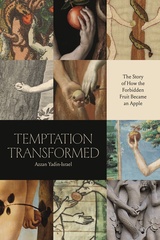 Temptation Transformed: The Story of How the Forbidden Fruit Became an Apple
Azzan Yadin-Israel
University of Chicago Press, 2022 A "brisk and entertaining" (Wall Street Journal) journey into the mystery behind why the forbidden fruit became an apple, upending an explanation that stood for centuries.
How did the apple, unmentioned by the Bible, become the dominant symbol of temptation, sin, and the Fall? Temptation Transformed pursues this mystery across art and religious history, uncovering where, when, and why the forbidden fruit became an apple.
Azzan Yadin-Israel reveals that Eden’s fruit, once thought to be a fig or a grape, first appears as an apple in twelfth-century French art. He then traces this image back to its source in medieval storytelling. Though scholars often blame theologians for the apple, accounts of the Fall written in commonly spoken languages—French, German, and English—influenced a broader audience than cloistered Latin commentators. Azzan Yadin-Israel shows that, over time, the words for “fruit” in these languages narrowed until an apple in the Garden became self-evident. A wide-ranging study of early Christian thought, Renaissance art, and medieval languages, Temptation Transformed offers an eye-opening revisionist history of a central religious icon.
 Temptations of a Superpower
Ronald Steel
Harvard University Press, 1995 America is the last remaining superpower. Yet what does this triumph mean when the challenges we face often defy military solutions? In Temptations of a Superpower, one of our most eloquent and incisive foreign policy analysts takes a hard look at this question, with all its implications for America's role in the post-Cold War world. Ronald Steel offers a devastating critique of a high-stakes game of foreign policy played by rules that no longer apply, and then proposes a more realistic--and pragmatic--view of the world and our place in it.
The Cold War imposed a certain order on the world, giving us a secure sense of our enemies and allies, our interests and our mission. Steel paints a disturbing picture of the world now deprived of its ordering principle, where ethnic conflicts and national rivalries once held in check erupt in violence, where the shifting allegiances and fevered ambitions flout familiar strategies for keeping peace, conducting trade, and protecting human rights. He explores the history of our present predicament and explains the dangers of adapting outmoded but habitual policies to a new world whose shape is fast evolving. What, for instance, is the future of America's military, deeply embedded as it is in our culture and economy? If Wilsonian idealism, with its vision of converting the world to democracy, replaces anti-communism as the guiding principle behind foreign policy, how far should it take us? What distinctions should we make between our nearest neighbors and distant nations? How are we to balance economic needs and ethical imperatives?
Analyzing the turmoil sweeping the world from China to Bosnia, Haiti to the Caucasus, Steel depicts the shattering dilemmas facing American policymakers. What concern should the United States have with many world quarrels? How can national interest be reconciled with strategic considerations and morality? When should domestic needs take precedence over foreign policy? The alternatives that Steel proposes to current policies defy much of the conventional wisdom and are certain to provoke controversy. He asks not only what America should do for the world, but what it must do for itself. Reminding us that foreign and domestic policy are inseparable, Steel argues that a renewed foreign policy must address not only changes in the world order, but the pressing, unmet needs within America itself.
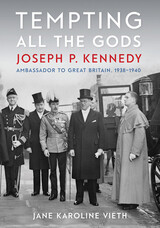 Tempting All the Gods: Joseph P. Kennedy, Ambassador to Great Britain, 1938–1940
Jane Karoline Vieth
Michigan State University Press, 2021 Tempting All the Gods is a detailed study of Joseph P. Kennedy’s diplomatic career in London. It examines Kennedy’s role as ambassador to the Court of St. James’s from 1938–1940, a crucial time in world history. It describes his attitudes toward American foreign policy before the outbreak of war and after the war began, explains why he held those views, and assesses their impact on Anglo-American relations. It also looks at the diplomatic background against which he worked, at the political philosophies and personalities of the statesmen with whom he dealt, and at his relations with them, particularly President Franklin Roosevelt and British Prime Ministers Neville Chamberlain and Winston Churchill. Here the reader will find a meticulously researched account of Kennedy’s career based on the latest evidence available, providing a current and balanced historical reassessment. Scholars will be able to study Kennedy’s diplomatic career within the broader context of international relations and also to gain a fuller understanding of his view of his own motives and policies, including an understanding of why the ambassadorship was the greatest achievement—with the poorest outcome—in the varied life of an intensely ambitious man who was dedicated foremost to family, friends, and fortune. This book will prove significant to students of Anglo-American relations and of World War II, and to the general public, with its enduring fascination with the Kennedy family.
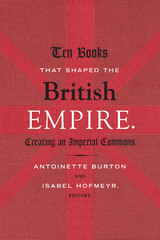 Ten Books That Shaped the British Empire: Creating an Imperial Commons
Antionette Burton and Isabel Hofmeyr, eds.
Duke University Press, 2014 Combining insights from imperial studies and transnational book history, this provocative collection opens new vistas on both fields through ten accessible essays, each devoted to a single book. Contributors revisit well-known works associated with the British empire, including Charlotte Brontë's Jane Eyre, Thomas Macaulay's History of England, Charles Pearson's National Life and Character, and Robert Baden-Powell's Scouting for Boys. They explore anticolonial texts in which authors such as C. L. R. James and Mohandas K. Gandhi chipped away at the foundations of imperial authority, and they introduce books that may be less familiar to students of empire. Taken together, the essays reveal the dynamics of what the editors call an "imperial commons," a lively, empire-wide print culture. They show that neither empire nor book were stable, self-evident constructs. Each helped to legitimize the other.
Contributors. Tony Ballantyne, Elleke Boehmer, Catherine Hall, Isabel Hofmeyr, Aaron Kamugisha, Marilyn Lake, Charlotte Macdonald, Derek Peterson, Mrinalini Sinha, Tridip Suhrud, André du Toit
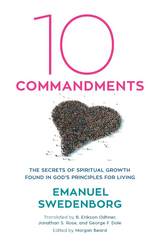 Ten Commandments: The Secrets of Spiritual Growth Found in God's Principles for Living
Emanuel Swedenborg
Swedenborg Foundation Publishers, 2016 Swedish scientist and visionary Emanuel Swedenborg (1688–1772) writes that the Ten Commandments are the most important part of the Bible. They encapsulate what we need to do to grow as spiritual people, with a meaning that penetrates far beyond the surface level of words and deeds.
One of the fundamentals of Swedenborg’s theology is the concept that underlying the literal text of the Bible is an inner spiritual meaning. Using this method of interpretation, Swedenborg peels back the layers of the Ten Commandments to reveal a cohesive set of teachings with both practical applications and far-reaching spiritual implications.
Although Swedenborg discusses the Ten Commandments in many places throughout his writings, he wrote four extended commentaries on the subject in four separate volumes: Secrets of Heaven (volume 7, published in 1754), True Christianity (1771), the short work Life (1763), and the posthumously published Revelation Explained (1758–1759). Those four commentaries are now being combined in a single volume for the first time, allowing the reader to compare and contrast Swedenborg’s approach across a seventeen-year span.
This book offers new insights for spiritual seekers and students of Swedenborg alike, illuminating what is at once a familiar set of biblical teachings and one of the cornerstones of Swedenborg’s system of personal growth.
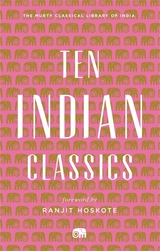 Ten Indian Classics
Murty Classical Library of India
Harvard University Press, 2025 “The Murty Classical Library of India sifts through multiple languages and thousands of years to bring a nation’s literary treasures to English-language readers.” —Wall Street Journal
Romantic ghazals and devotional quatrains, medieval battles and separated lovers, Buddhist women on their journeys toward nirvana and Ram’s battle against a demon army to rescue Sita—all this and more can be found in the Murty Classical Library of India’s Ten Indian Classics.
Beginning in the sixth century B.C.E. and coming up to the eighteenth century, spanning the Indian subcontinent, the selections in this anthology include some of the oldest women’s writing in the world, exquisite Sanskrit court poems, verses from the Sikh sacred tradition recited by millions around the world, the renowned chronicle of the Mughal emperor Akbar, and Tulsidas’s retelling of the epic Ramayana that is cherished in north India to this day. Here, too, are the poems of Surdas, Mir Taqi Mir, and Bullhe Shah, which continue to inspire artists today and live on in contemporary music.
The anthology showcases original translations by leading experts from a vast array of India’s literary traditions: Hindi, Kannada, Pali, Panjabi, Persian, Sanskrit, Telugu, and Urdu. With a foreword by the award-winning poet and translator Ranjit Hoskote, Ten Indian Classics is an invitation to readers worldwide to immerse themselves in a literary tradition that continues to shape modern South Asian culture and aesthetics in all its stunning diversity.
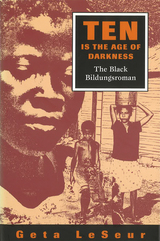 Ten Is the Age of Darkness: The Black Bildungsroman
Geta LeSeur
University of Missouri Press, 1995 In Ten Is the Age of Darkness, Geta LeSeur explores how black authors of the United States and English- speaking Caribbean have taken a European literary tradition and adapted it to fit their own needs for self-expression. LeSeur begins by defining the structure and models of the European genre of the bildungsroman, then proceeds to show how the circumstances of colonialism, oppression, race, class, and gender make the maturing experiences of selected young black protagonists different from those of their white counterparts. Examining the parallels and differences in attitudes toward childhood in the West Indies and the United States, as well as the writers' individual perspectives in each work of fiction, LeSeur reaches intriguing conclusions about family life, community participation in the nurturing of children, the timing and severity of the youngsters' confrontation of adult society, and the role played by race in the journey toward adulthood. LeSeur's readings of African American novels provide new insights into the work of Langston Hughes, James Baldwin, Toni Morrison, Paule Marshall, and Richard Wright, among others. When read as examples of the bildungsroman rather than simply as chronicles of black experiences, these works reveal an even deeper significance and have a more powerful impact. LeSeur convincingly demonstrates that such African American novels as Baldwin's Go Tell It on the Mountain, Wright's Black Boy, and Morrison's The Bluest Eye concentrate to a large extent on protest, while such African West Indian works as George Lamming's In the Castle of My Skin, Austin Clarke's Amongst Thistles and Thorns, Jamaica Kincaid's Annie John, and Erna Brodber's Jane and Louisa Will Soon Come Home reflect a more naive, healthy re-creation of what childhood can and should be, despite economic and physical impoverishment. She also gives a special space within the genre to Paule Marshall's BrownGirl, Brownstones and Ntozake Shange's Betsey Brown and the importance of "woman time," "woman voice," and mothers. While enlarging our understanding of both the similarities and the differences in the black experiences of the Carribean and American youngsters coming of age, Ten Is the Age of Darkness also suggests that children of color in similar spheres share many common experiences. LeSeur concludes that the bildungsromane by black writers provide uniquely revealing contributions to the Afro-World literary canon and point the way for others to examine literary pieces in Third World communities of color.
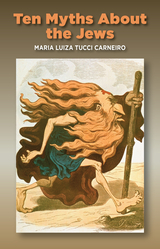 Ten Myths About the Jews
Maria Luiza Carneiro Tucci
Sussex Academic Press, 2022 Ten Myths about the Jews; analyzes the complex facets of anti-Semitism and anti-Judaism in an accessible and easy-to-read format. Based on wide research, Brazilian historian Maria Luiza Tucci Carneiro examines different manifestations against Jews and their faith through history and political culture along the centuries. Tucci Carneiro unmasks the roots of anti-Semitism and exposes contemporary prejudices. Her book is an invitation to reflect upon current realities marked by racism and shows how the main myths about the Jews have been vested of a verisimilitude that has persisted for the last 2000 years, all over the world, by means of hatred of the other, political/religious opportunism, and economic deceit. The myths are kept alive by means of constant repetition and re-elaboration of a particular narrative, invariably seductive. The author proves each of the ten myths in terms of their historical record, their origins, and purposes. Even though Jews are fully integrated into western society in multiple ways (entrepreneurship, medicine, literature, philosophy, the arts), racist myths against the community have been particularly resilient; they attempt to override common sense and their continuous circulation and rehashing through scapegoating and caricature has had profound negative repercussions for society as a whole. Ten Myths,; now published in five languages, is an essential tool in the struggle against the discourse of racist hatred.
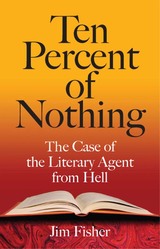 Ten Percent of Nothing: The Case of the Literary Agent from Hell
Jim Fisher
Southern Illinois University Press, 2004 Former FBI agent Jim Fisher upends the genteel racket of fee-based literary agents and vanity publishers in this searing look at the rise and fall of one bogus entrepreneur who systematically swindled thousands of would-be writers out of millions of dollars with promises of having their work turned into salable books. In divulging the details of this colossal and shocking confidence game, Ten Percent of Nothing: The Case of the Literary Agent from Hell exposes a growing and serious crime against writers and a dark, ugly secret about the American publishing industry. In 1989, Dorothy L. Deering, possessing a high school degree, a recent embezzlement conviction, and no experience as a professional writer, editor, or publisher, began operating a fee-based literary agency out of her garage in Nicholasville, Kentucky. Over the next ten years, she racked up a fortune in reading and marketing fees, learning the business of sham publishing as she went along. Later, as the owner of a vanity press, she bilked 1.5 million dollars out of her clients, masterfully manufacturing dreams of literary success until she was brought to justice by Fisher’s investigative journalism, an FBI probe, and the retaliation and testimonies of numerous victims. Deering never sold a single manuscript to a major publisher. With the money in her pocket and her clients’ hopes and hard work wrapped up in fraudulent contracts, Deering produced a few copies of four cheaply printed, poorly edited paperbacks. These she used as bait to hoodwink more clients. She was abetted by her husband, Charles, a former car salesman; his son, Daniel, a drug user with a ninth-grade education; and her brother, Bill, a fugitive from the law at the time he headed her vanity press. By successfully impersonating a literary agent for ten years, Deering operated one of the longest-running confidence games in American history. The financial loss for her clients was devastating, and the heartbreak was extreme. Drawing on victims’ experiences and documents recovered from the Deering venture, Fisher shows how Deering engineered and executed her scam, emphasizing the warning signs of sham agents, crook book doctors, and mendacious publishers. Ten Percent of Nothing provides essential information for aspiring writers and publishing professionals. Fisher’s findings also prompt new inquiries into the potential licensing of literary agents and the prosecution of interstate scam artists. The volume’s gallery of illustrations includes reproductions of correspondence, newsletters, and advertisements used by the Deering operation.
 Ten Steps for Recording Pictographs and Petroglyphs: Methods and Technologies
Lawrence Loendorf and Nancy Medaris Stone
University of Utah Press, 2024 Pictograph and petroglyph sites, commonly identified as sacred by Indigenous communities, offer the potential of great insight into past belief systems and ritual activities if carefully recorded. The aesthetic appeal of the art itself has long been appreciated, and chemical and artistic analyses have been applied to these depictions to uncover deeper information such as chronology and pigment composition. In Ten Steps for Recording Pictographs and Petroglyphs, Lawrence Loendorf and Nancy Medaris Stone present their thorough and systematic ten-step guide to recording not just the imagery itself, but also the entire site amid which it is set. This essential context situates the depictions within the immediate and broader landscape, assembling a more complete picture of their significance.
Despite having survived for thousands of years, erosion, decay, and even vandalism are all threats to these important cultural sites. A field session involving documentation might be the only opportunity to record these unique and significant images. The ten steps laid out here by Loendorf and Stone offer a general overview of current best practices to maintain a scientific and professional documentation program.
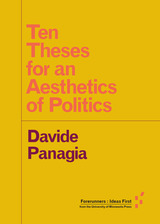 Ten Theses for an Aesthetics of Politics
Davide Panagia
University of Minnesota Press, 2016 Ten Theses for an Aesthetics of Politics is an invitation to culture makers, political thinkers of all kinds, and everyday spectators to reconsider their love of the world of appearances. Inspired by Jacques Rancière’s Ten Theses on Politics and work by Hannah Arendt, Stanley Cavell, and Roland Barthes, Davide Panagia offers conceptual provocations that emphasize the sense of conviction one has when facing the frictions of aesthetic experience. Rooted in varied and variable experiences of border crossings, Panagia invites readers to reflect on the relational practices that appearances engender. Forerunners: Ideas First is a thought-in-process series of breakthrough digital publications. Written between fresh ideas and finished books, Forerunners draws on scholarly work initiated in notable blogs, social media, conference plenaries, journal articles, and the synergy of academic exchange. This is gray literature publishing: where intense thinking, change, and speculation take place in scholarship.
 Ten Thousand Democracies: Politics and Public Opinion in America's School Districts
Michael B. Berkman and Eric Plutzer
Georgetown University Press, 2005 The essence of democracy is popular sovereignty. The people rule. In the United States, citizens exercise this right through elected officials who they believe will best represent their own values and interests. But are those interests and values always being followed? Authors Michael B. Berkman and Eric Plutzer provide the first systematic examination of the extent to which the governments closest to the American public—its 10,000-plus local school boards—respond to the wishes of the majority. Ten Thousand Democracies begins with a look at educational reforms from the Progressive era in the late 19th and early 20th centuries through the civil rights movement and ending with Pennsylvania's 2004 tax relief measure. Berkman and Plutzer explore what factors determine education spending levels in school districts, including the effects of public opinion, the nature of local political institutions, and the roles played by special interests. The authors show how board members are selected, how well the boards represent minorities, whether the public can bypass the board through referenda, and how the schools are financed. By providing an innovative statistical portrait that combines public opinion data with Census data for these school districts, the authors answer questions central to democratic control of our schools: how responsive are school boards to their public and when? How powerful are such special interests such as teachers' unions and senior citizens?
By using the lens of America's public school districts to examine the workings of democracy, Ten Thousand Democracies offers new insight not only into the forces shaping local education policy but also how democratic institutions may function throughout all levels of government.
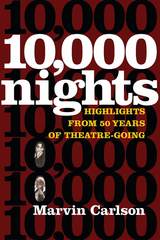 Ten Thousand Nights: Highlights from 50 Years of Theatre-Going
Marvin Carlson
University of Michigan Press, 2017 Esteemed scholar and theater aficionado Marvin Carlson has seen an unsurpassed number of theatrical productions in his long and distinguished career. Ten Thousand Nights is a lively chronicle of a half-century of theatre-going, in which Carlson recalls one memorable production for each year from 1960 to 2010. These are not conventional reviews, but essays using each theatre experience to provide an insight into the theatre and theatre-going at a particular time. The range of performances covered is broad, from edgy experimental fare to mainstream musicals, most of them based in New York but with stops at major theatre events in Paris, Berlin, Moscow, Milan, and elsewhere. The engagingly written pieces convey a vivid sense not only of each production but also of the particular venue, neighborhood, and cultural context, covering nearly all significant movements, theatre artists, and groups of the late twentieth century.
 Ten Thousand Scrolls: Reading and Writing in the Poetics of Huang Tingjian and the Late Northern Song
Yugen Wang
Harvard University Press, 2011 The Northern Song (960–1126) was one of the most transformative periods in Chinese literary history, characterized by the emergence of printing and an ensuing proliferation of books. The poet Huang Tingjian (1045–1105), writing at the height of this period, both defined and was defined by these changes. The first focused study on the cultural consequences of printing in Northern Song China, this book examines how the nascent print culture shaped the poetic theory and practice of Huang Tingjian and the Jiangxi School of Poetry he founded.
Author Yugen Wang argues that at the core of Huang and the Jiangxi School’s search for poetic methods was their desire to find a new way of reading and writing that could effectively address the changed literary landscape of the eleventh century. Wang chronicles the historical and cultural negotiation Huang and his colleagues were conducting as they responded to the new book culture, and opens new ground for investigating the literary interpretive and hermeneutical effects of printing. This book should be of interest not only to scholars and readers of classical Chinese poetry but to anyone concerned with how the material interacts with the intellectual and how technology has influenced our conception and practice of reading and writing throughout history.
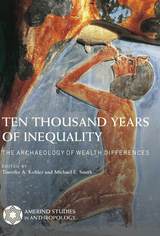 Ten Thousand Years of Inequality: The Archaeology of Wealth Differences
Edited by Timothy A. Kohler and Michael E. Smith
University of Arizona Press, 2018 Is wealth inequality a universal feature of human societies, or did early peoples live an egalitarian existence? How did inequality develop before the modern era? Did inequalities in wealth increase as people settled into a way of life dominated by farming and herding? Why in general do such disparities increase, and how recent are the high levels of wealth inequality now experienced in many developed nations? How can archaeologists tell?
Ten Thousand Years of Inequality addresses these and other questions by presenting the first set of consistent quantitative measurements of ancient wealth inequality. The authors are archaeologists who have adapted the Gini index, a statistical measure of wealth distribution often used by economists to measure contemporary inequality, and applied it to house-size distributions over time and around the world. Clear descriptions of methods and assumptions serve as a model for other archaeologists and historians who want to document past patterns of wealth disparity.
The chapters cover a variety of ancient cases, including early hunter-gatherers, farmer villages, and agrarian states and empires. The final chapter synthesizes and compares the results. Among the new and notable outcomes, the authors report a systematic difference between higher levels of inequality in ancient Old World societies and lower levels in their New World counterparts.
For the first time, archaeology allows humanity’s deep past to provide an account of the early manifestations of wealth inequality around the world.
Contributors
Nicholas Ames
Alleen Betzenhauser
Amy Bogaard
Samuel Bowles
Meredith S. Chesson
Abhijit Dandekar
Timothy J. Dennehy
Robert D. Drennan
Laura J. Ellyson
Deniz Enverova
Ronald K. Faulseit
Gary M. Feinman
Mattia Fochesato
Thomas A. Foor
Vishwas D. Gogte
Timothy A. Kohler
Ian Kuijt
Chapurukha M. Kusimba
Mary-Margaret Murphy
Linda M. Nicholas
Rahul C. Oka
Matthew Pailes
Christian E. Peterson
Anna Marie Prentiss
Michael E. Smith
Elizabeth C. Stone
Amy Styring
Jade Whitlam
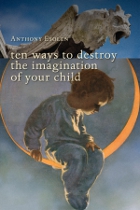 Ten Ways to Destroy the Imagination of Your Child
Anthony Esolen
Intercollegiate Studies Institute, 2010
Extinguishing the minds (and souls) of our children in ten easy steps
Play dates, soccer practice, day care, political correctness, drudgery without facts, television, video games, constant supervision, endless distractions: these and other insidious trends in child rearing and education are now the hallmarks of childhood. As author Anthony Esolen demonstrates in this elegantly written, often wickedly funny book, almost everything we are doing to children now constricts their imaginations, usually to serve the ulterior motives of the constrictors.
Ten Ways to Destroy the Imagination of Your Childtakes square aim at these accelerating trends, in a bitingly witty style reminiscent of C. S. Lewis, while offering parents—and children—hopeful alternatives. Esolen shows how imagination is snuffed out at practically every turn: in the rearing of children almost exclusively indoors; in the flattening of love to sex education, and sex education to prurience and hygiene; in the loss of traditional childhood games; in the refusal to allow children to organize themselves into teams; in the effacing of the glorious differences between the sexes; in the dismissal of the power of memory, which creates the worst of all possible worlds in school—drudgery without even the merit of imparting facts; in the strict separation of the child’s world from the adult’s; and in the denial of the transcendent, which places a low ceiling on the child’s developing spirit and mind.
But Esolen doesn’t stop at pointing out the problem; he offers clear solutions as well. With charming stories from his own boyhood and an assist from the master authors and thinkers of the Western tradition, Ten Ways to Destroy the Imagination of Your Child is a welcome respite from the overwhelming banality of contemporary culture. Interwoven throughout this indispensable guide to child rearing is a rich tapestry of the literature, music, art, and thought that once enriched the lives of American children.
Ten Ways to Destroy the Imagination of Your Child confronts contemporary trends in parenting and schooling by reclaiming lost traditions. This practical, insightful book is essential reading for any parent who cares about the paltry thing that childhood has become, and who wants to give a child something beyond the dull drone of today’s culture.
Ten Women of Mystery
Edited by Earl F. Bargainnier
University of Wisconsin Press, 1981 This volume, which examines the special contributions of a number of women mystery writers, sheds light on this significant example of common interests in recreational reading among women and men and the reasons behind the early and continuing uncharacteristic near-equality of both sexes in this field of endeavor.
Ten Years After: A History of Roma School Desegregation in Central and Eastern Europe
Iulius Rostas
Central European University Press, 2012 The volume presents the results collated in the frames of the fact finding project led by the editor. The analysis includes the examination of a large number of legal documents and policy statements issued by national authorities and the international community on the matter. A critical overview is also made about the various Roma-specific political campaigns on national and European scale. The second half of the book contains interviews with activists that assumed a leading role in school desegregation. These testimony pieces have been critically reviewed by educational and policy analysts from the concerned countries.
 Ten Years of War and Peace
Archibald Cary Coolidge
Harvard University Press Professor Coolidge has here gathered ten articles from Foreign Affairs of which he is the editor, from the Yale Review , and from the American Historical Review. All of them deal with the great problems of world politics. Of those problems they provide clear, historical accounts, accompanied by judicial comment. Such titles as “Nationality and the New Europe,” “The Break Up of the Hapsburg Empire,” “Russia after Genoa and The Hague,” sufficiently show how extended a view the book affords of the European field. Three papers deal specifically with the United States: “Two Years of American Foreign Policy,” which recounts the first achievements of Secretary Hughes, “The Future of the Monroe Doctrine,” and “After the Election,” wherein the advent of President Coolidge is discussed mainly from the point of view of its effect on our foreign policy. These chapters round out the volume and make of it a comprehensive review of the affairs of our world.
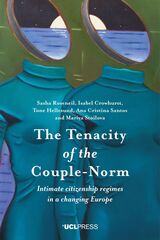 The Tenacity of the Couple-Norm: Intimate Citizenship Regimes in a Changing Europe
Sasha Roseneil, Isabel Crowhurst, Tone Hellesund, Ana Cristina Santos, and Mariya Stoilava
University College London, 2020 Despite changes and challenges, coupledom has long been constructed as the normal, natural, and superior way of being an adult. The Tenacity of the Couple-Norm offers an anatomical dissection of the concept—an analysis of its structure, organization, and internal workings. It explores how the couple-norm is lived and experienced, how it has evolved and mutated, and how it varies among places and social groups. In doing so, the book provides an analysis of changing intimate citizenship regimes in Europe and makes a major intervention in understandings of the contemporary condition of personal life.
The Tenacity of the Couple-Norm makes an important contribution to literature on citizenship, intimacy, family life, and social change in sociology, social policy, socio-legal studies, gender/sexuality/queer studies, and psychosocial studies.
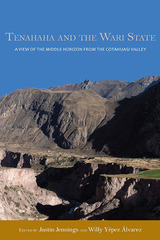 Tenahaha and the Wari State: A View of the Middle Horizon from the Cotahuasi Valley
Edited by Justin Jennings and Willy Yépez Álvarez
University of Alabama Press, 2015 The Middle Horizon period (A.D. 600–1000) was a time of sweeping cultural change in the Andes. Archaeologists have long associated this period with the expansion of the Wari (Huari) and Tiwanaku (Tiahuanaco) states in the south-central Andes and the Pacific coasts of contemporary Peru and Chile.
Tenahaha and the Wari State contains a series of essays that challenge current beliefs about the Wari state and suggest a reassessment of this pivotal era in Andean history. In this collection, a picture emerges of Wari power projected across the region’s rugged and formidable topography less as a conquering empire than as a source of ideas, styles, and material culture voluntarily adopted by neighboring peoples.
Much of the previous fieldwork on Wari history took place in the Wari heartland and in Wari strongholds, not areas where Wari power and influence were equivocal. In Tenahaha and the Wari State, editors Justin Jennings and Willy Yépez Álvarez set out to test whether current theories of the Wari state as a cohesive empire were accurate or simply reflective of the bias inherent in studying Wari culture in its most concentrated centers. The essays in this collection examine instead life in the Cotahuasi Valley, an area into which Wari influence expanded during the Middle Horizon period.
Drawing on ten years of exhaustive field work both at the ceremonial site of Tenahaha and in the surrounding valley, Jennings and Yépez Álvarez posit that Cotahuasinos at Tenahaha had little contact with the Wari state. Their excavations and survey in the area tell the story of a region in flux rather than of a people conquered by Wari. In a time of uncertainty, they adopted Wari ideas and culture as ways to cope with change.
The Tenant of Fire: Poems
Ryan Black
University of Pittsburgh Press, 2019 Winner of the 2019 Agnes Lynch Starrett Poetry Prize
The Tenant of Fire is about Queens, NY—its history, public and personal, real and imagined. Many of the people who populate this book—Irish Catholics, Italian-Americans—were once considered ethnic but now fall wholly under the banner of white. And from their anxieties a man like Donald Trump emerges. Born and raised in Queens, Trump is both the product and purveyor of a localized nativist politic.
The young white speaker of these poems works to record his parents’ and neighbors’, both white and of color, and his own attempts at navigating a shifting landscape. In poems on the homecoming of Vietnam vets, or the aftermath of Hurricane Sandy, or the firebombing of Malcolm X’s house, The Tenant of Fire explores how and why the plurality of a place like Queens, where now nearly two hundred languages are spoken, is viewed as a threat to national security.
Tendencies
Eve Kosofsky Sedgwick
Duke University Press, 1983 Tendencies brings together for the first time the essays that have made Eve Kosofsky Sedgwick "the soft-spoken queen of gay studies" (Rolling Stone). Combining poetry, wit, polemic, and dazzling scholarship with memorial and autobiography, these essays have set new standards of passion and truthfulness for current theoretical writing.
The essays range from Diderot, Oscar Wilde, and Henry James to queer kids and twelve-step programs; from "Jane Austen and the Masturbating Girl" to a performance piece on Divine written with Michael Moon; from political correctness and the poetics of spanking to the experience of breast cancer in a world ravaged and reshaped by AIDS. What unites Tendencies is a vision of a new queer politics and thought that, however demanding and dangerous, can also be intent, inclusive, writerly, physical, and sometimes giddily fun.
Tender
Toi Derricotte
University of Pittsburgh Press, 1997 Toi Derricotte’s fourth collection of poetry. Tender probes sexuality, spirituality, emotion, child abuse, mother hatred, and the physical and psychological ravages of violence. These poems are raw and upsetting in subject matter, yet extremely readable.
Tender Comrades: A Backstory of the Hollywood Blacklist
Patrick McGilligan
University of Minnesota Press, 2012
More than sixty years ago, McCarthyism silenced Hollywood. In the pages of Tender Comrades, those who were suppressed, whose lives and careers were ruined, finally have their say. A unique collection of profiles in cinematic courage, this extraordinary oral history brings to light the voices of thirty-six blacklist survivors (including two members of the Hollywood Ten), seminal directors of film noir and other genres, starring actresses and memorable supporting players, top screenwriters, and many less known to the public, who are rescued from obscurity by the stories they offer here that, beyond politics, open a rich window into moviemaking during the Golden Age of Hollywood.
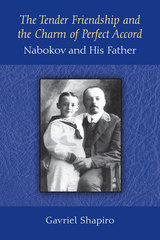 The Tender Friendship and the Charm of Perfect Accord: Nabokov and His Father
Gavriel Shapiro
University of Michigan Press, 2014 Vladimir Nabokov (1899–1977), a writer of world renown, grew up in a culturally refined family with diverse interests. Nabokov’s father, Vladimir Dmitrievich (1870–1922), was a distinguished jurist and statesman at the turn of the twentieth century. He was also a great connoisseur and aficionado of literature, painting, theater, and music as well as a passionate butterfly collector, keen chess player, and avid athlete. This book, the first of its kind, examines Vladimir Nabokov’s life and works as impacted by his distinguished father. It demonstrates that V. D. Nabokov exerted the most fundamental influence on his son, making this examination pivotal to understanding the writer’s personality and his world perception, as well as his literary, scholarly, and athletic accomplishments. The book contains never heretofore published archival materials. It is appended with rare articles by Nabokov and his father and is accompanied by old photographs. In addition, the book constitutes a survey of sorts of Russian civilization at the turn of the twentieth century by providing a partial view of the multifaceted picture of Imperial Russia in its twilight hours. The book illumines the historical background, political struggle, juridical battles, and literary and artistic life as well as athletic activities during the epoch, rich in cultural events and fraught with sociopolitical upheavals. Cover illustration: Vladimir Nabokov and his father, 1906. The Nabokov family photographs. Copyright © The Estate of Vladimir Nabokov, used by permission of The Wylie Agency, LLC; and of The Henry W. and Albert A. Berg Collection of English and American Literature, The New York Public Library, Astor, Lenox and Tilden Foundations.
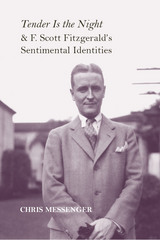 Tender Is the Night and F. Scott Fitzgerald's Sentimental Identities
Chris Messenger
University of Alabama Press, 2015 In this fascinating study, Chris Messenger posits F. Scott Fitzgerald as a great master of sentiment in modern American fiction. Sentimental forms both attracted and repelled Fitzgerald while defining his deepest impulses as a prose writer. Messenger demonstrates that the sentimental identities, refractions, and influences Fitzgerald explores in Tender Is the Night define key components in his affective life, which evolved into a powerful aesthetic that informed his vocation as a modernist writer.
In “Tender Is the Night” and F. Scott Fitzgerald’s Sentimental Identities, Messenger traces the roots of Fitzgerald’s writing career to the deaths of his two infant sisters a few months before his own birth. It was their loss, Fitzgerald wrote, that made him a writer. Messenger highlights how the loss of Fitzgerald’s siblings powerfully molded his relation to maternal nurturing and sympathy in Tender Is the Night as well as how it shaped the homosocial intimations of its care-giving protagonist, psychiatrist Dick Diver. A concomitant grief and mourning was fueled by Fitzgerald’s intimate and intense creative rivalry with his often-institutionalized wife, Zelda Sayre Fitzgerald.
While sentiment is a discredited strain in high modernism, Fitzgerald nevertheless embraced it in Tender Is the Night to fashion this most poignant and beautiful successor to The Great Gatsby. Fitzgerald’s aesthetic and emotional preoccupations came most vividly to life in this major novel. Messenger describes how Fitzgerald, creating his character Nicole Warren Diver as a victim of paternal incest, finally found the sentimental key to finishing his novel and uniting his vision of the two narratives of “saving” the two sisters and reimagining the agony of his wife and their marriage.
Fitzgerald’s productive quarrel with and through sentiment defines his career, and Messenger convincingly argues that Tender Is the Night should be placed alongside TheGreat Gatsby as a classic exemplar of the modern novel.
Tender Machines
J. Mae Barizo
Tupelo Press, 2023 Set against the backdrop of a changing urban landscape, the poems in Tender Machines swing between the domestic and the surreal, charting motherhood, desire and an immigrant family’s haunted inheritance. Mapping the lives of women and the lives they inhabit, poems such as “Small Essays on Disappearance,”—which channel the aftermath of motherhood and 9-11—collide with aubades describing mornings in a ruined city: “buying food at the bodegas…nectarines and skin-tight plums.” The poems in Tender Machines live in the space between the public and the private, braiding an intimate narrative. This is an intersectional portrait of womanhood with all its losses, departures and wonders.
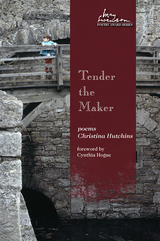 Tender the Maker
Christina Hutchins
Utah State University Press, 2015 "Again and again in Christina Hutchins’s exquisite Tender the Maker, poems startle us into awareness of the overlooked, the nearly always invisible (such as a library’s unused dictionary), and the marvelous, those aspects of life that come under the rubric of ‘mystery,’ in all senses of the word. Hutchins combines a pitch-perfect and precise lyricism with a postmodern sensibility of language’s materiality.”
—Cynthia Hogue, judge for the 2015 May Swenson Poetry Award
"An elegantly crafted, dense work that invites readers to travel on spiritual, philosophical, and historical journeys."
—Kirkus Reviews "Tender the Maker revisits the age-old comparison between poet and deity, highlighting its blind spots, namely the times when creating also means losing, destroying, forgetting. . . . Each poem becomes a map where time and space intersect and unearth connections that help us confront the weight of history, whether our own or that of others."
—Fjords Review
"[T]hroughout the book, Hutchins guides me into her patient, fragile, complex vision. . . . Both the depth and the precision of Hutchins’s work arise from her exact attention to the 'motion-in-relation' of herself as an artist, which is also attention to the tools of her work and to her imagination’s duty to honor the seen and the not seen."
—Beloit Poetry Journal The May Swenson Poetry Award is an annual competition named for May Swenson, one of America’s most provocative and vital writers. During her long career, Swenson was loved and praised by writers from virtually every school of American poetry. She left a legacy of fifty years of writing when she died in 1989. She is buried in her hometown of Logan, Utah.
A Tenderfoot in Colorado
Richard Baxter Townshend
University Press of Colorado, 1968 Publication supported in part by the National Science Foundation.
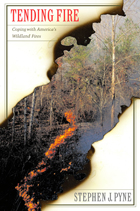 Tending Fire: Coping With America's Wildland Fires
Stephen J. Pyne
Island Press, 2004 The wildfires that spread across Southern California in the fall of 2003 were devastating in their scale-twenty-two deaths, thousands of homes destroyed and many more threatened, hundreds of thousands of acres burned. What had gone wrong? And why, after years of discussion of fire policy, are some of America's most spectacular conflagrations arising now, and often not in a remote wilderness but close to large settlements? That is the opening to a brilliant discussion of the politics of fire by one of the country's most knowledgeable writers on the subject, Stephen J. Pyne. Once a fire fighter himself (for fifteen seasons, on the North Rim of the Grand Canyon) and now a professor at Arizona State University, Pyne gives us for the first time a book-length discussion of fire policy, of how we have come to this pass, and where we might go from here. Tending Fire provides a remarkably broad, sometimes startling context for understanding fire. Pyne traces the "ancient alliance" between fire and humanity, delves into the role of European expansion and the creation of fire-prone public lands, and then explores the effects wrought by changing policies of "letting burn" and suppression. How, the author asks, can we better protect ourselves against the fires we don't want, and better promote those we do? Pyne calls for important reforms in wildfire management and makes a convincing plea for a more imaginative conception of fire, though always grounded in a vivid sense of fire's reality. "Amid the shouting and roar, a central fact remains," he writes. "Fire isn't listening. It doesn't feel our pain. It doesn't care-really, really doesn't care. It understands a language of wind, drought, woods, grass, brush, and terrain, and it will ignore anything stated otherwise." We need to think about fire in more deeply biological ways and recognize ourselves as the fire creatures we are, Pyne argues. Even if, in recent times, "we have gone from being keepers of the flame to custodians of the combustion chamber," tending fire wisely remains our responsibility as a species. "The Earth's fire scene," he writes of us, "is largely the outcome of what this creature has done, and not done, and the species operates not according to strict evolutionary selection but in the realm of culture, which is to say, of choice and confusion." Rich in insight, wide-ranging in its subject, and clear-eyed in its proposals, Tending Fire is for anyone fascinated by fire, fire policy, or human culture.
Tending Iowa’s Land: Pathways to a Sustainable Future
Cornelia F. Mutel
University of Iowa Press, 2022 2023 Midwest Book Awards in Nonfiction - Nature, winner
In the last 200 years, Iowa’s prairies and other wildlands have been transformed into vast agricultural fields. This massive conversion has provided us with food, fiber, and fuel in abundance. But it has also robbed Iowa’s land of its native resilience and created the environmental problems that today challenge our everyday lives: polluted waters, increasing floods, loss and degradation of rich prairie topsoil, compromised natural systems, and now climate change.
In a straightforward, friendly style, Iowa’s premier scientists and experts consider what has happened to our land and outline viable solutions that benefit agriculture as well as the state’s human and wild residents.
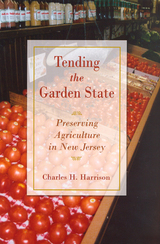 Tending the Garden State: Preserving Agriculture in New Jersey
Harrison, Charles
Rutgers University Press, 2006 Early in the nineteenth century, an army colonel stood before a crowd at the Salem County Courthouse and ate buckets of tomatoes to prove that they were not poisonous. Ever since, the red vegetable of summer has played a starring role in New Jersey’s history. Although today visitors to the state are more likely to see smoke-spewing factories than acres of farmland or grazing cattle, the state’s legacy of agriculture and farming continues, and extends far beyond the popular Jersey tomato. In Tending the Garden State, Charles Harrison tells the story of the state’s rich agricultural history from the time when Leni-Lenape Indians scratched the earth with primitive tools up through today. He recalls New Jersey’s rural past, traces the evolution of farming over the course of the twentieth century, and explains innovative approaches to protecting the industry. Drawing on interviews with farmers, as well as researchers, professional planners, designers, and architects, Harrison discovers that despite the discouraging spread of suburban sprawl, the Garden State’s farming legacy is not as endangered as it may seem. Many residents care deeply about preserving New Jersey’s agricultural industry and are making great strides to keep the tradition alive for future generations. Some of these protective measures include new laws that encourage the conservation of land and research devoted to helping farmers make the most of their limited acreage. Innovative techniques such as high-tunnel farming, together with the growth of some very profitable farm specializations, such as turf grass, aquaculture, horticulture, and wine making, will enable farmers to remain active and successful in the state’s oldest industry. Anyone interested in New Jersey’s history or, more broadly, in the history of American agriculture, will be delighted by Harrison’s engaging and readable account of farming in the Garden State.
Tending The Talking Wire: A Buck Soldier's View of Indian Country, 1863-1866
William E Unrau
University of Utah Press, 1979 Hervey Johnson's letters offer a fascinating first-person account of the critical Indian War years on the high plains of eastern Wyoming during which a confederation of Sioux, Cheyenne, and Arapaho Indians successfully defended their Powder River buffalo range.
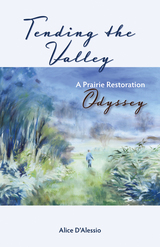 Tending the Valley: A Prairie Restoration Odyssey
Alice D'Alessio
Wisconsin Historical Society Press, 2020 On a gray and drizzly day in 1983, writer Alice D’Alessio and her math professor husband, Laird, made their way down a curving, tree-lined driveway on their way to a picnic. They were visiting 110 acres of land in Wisconsin’s unglaciated Driftless Area that Laird had inherited from his parents. Emerging from the trees, Alice had her first glimpse of the valley that would become a twenty-five-year labor of love for the couple.
In Tending the Valley, Alice chronicles their efforts to return the land to its natural prairie state and to manage their oak and pine woods. Along the way they joined the land restoration movement, became involved in a number of stewardship groups, and discovered the depths of dedication and toil required to bring their dream to fruition. With hard-earned experience and the evocative language of a poet, D’Alessio shares her personal triumphs and setbacks as a prairie steward, along with a profound love for the land and respect for the natural history of the Driftless.
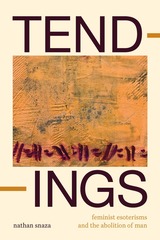 Tendings: Feminist Esoterisms and the Abolition of Man
Nathan Snaza
Duke University Press, 2024 In Tendings, Nathan Snaza brings contemporary feminist and queer popular culture’s resurging interest in esoteric practices like tarot and witchcraft into conversation with Black feminist and new materialist thought. Analyzing writing and performances by Maryse Condé, Barbara Ehrenreich and Deirdre English, Starhawk, Christina Sharpe, Alexis Pauline Gumbs, and others, Snaza introduces his theory of tending as a concept that links ontology, attunement, care, and anticipatory action to explore how worlds persist through everyday acts of participation. In contrast to the universalizing presuppositions of the enlightenment, Snaza shows how certain feminist occult and esoteric practices constitute what he calls an endarkenment that embraces decolonial spiritual knowledge. Highlighting how endarkenment practices challenge universal presumptions and reject the racializing and colonialist mission of enlightenment modernity, Snaza demonstrates the ways esoterism affirms a pluriversal worldview that reimagines what it means to live in a more-than-human world.
The Tenement Saga: The Lower East Side and Early Jewish American Writers
Sanford Sternlicht
University of Wisconsin Press, 2004 Nearly two million Jewish men, women, and children emigrated from Eastern Europe between 1882 and 1924 and settled in, or passed through, the Lower East Side of New York City. Sanford Sternlicht tells the story of his own childhood in this vibrant neighborhood and puts it within the context of fourteen early twentieth-century East Side writers. Anzia Yezierska, Abraham Cahan, Michael Gold, and Henry Roth, and others defined this new "Jewish homeland" and paved the way for the later great Jewish American novelists.
Sternlicht discusses the role of women, the Yiddish Theater, secular values, the struggle between generations, street crime, politics, labor unions, and the importance of newspapers and periodicals. He documents the decline of Yiddish culture as these immigrants blended into what they called "The Golden Land."
Tenement Songs: The Popular Music of the Jewish Immigrants
Mark Slobin
University of Illinois Press, 1982 Yiddish-speaking Jewish immigrants brought a rich heritage of musical expression to the United States. On Manhattan's Lower East Side, a thriving Yiddish theater scene developed, and a new, distinctly Jewish American songcraft began to emerge. Mark Slobin's ethnographic study of the music and culture of the time traces the development of Yiddish popular song in America, delving into melodies, sheet music, and printers' iconography to bring alive a time and place that, while almost forgotten, still exercises an enormous effect on American popular culture.
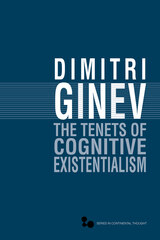 The Tenets of Cognitive Existentialism
Dimitri Ginev
Ohio University Press, 2011 In The Tenets of Cognitive Existentialism, Dimitri Ginev draws on developments in hermeneutic phenomenology and other programs in hermeneutic philosophy to inform an interpretative approach to scientific practices. At stake is the question of whether it is possible to integrate forms of reflection upon the ontological difference in the cognitive structure of scientific research. A positive answer would have implied a proof that (pace Heidegger) “science is able to think.” This book is an extended version of such a proof. Against those who claim that modern science is doomed to be exclusively committed to the nexus of objectivism and instrumental rationality, the interpretative theory of scientific practices reveals science’s potentiality of hermeneutic self-reflection. Scientific research that takes into consideration the ontological difference has resources to enter into a dialogue with Nature. Ginev offers a critique of postmodern tendencies in the philosophy of science, and sets out arguments for a feminist hermeneutics of scientific research.
 TennCare, One State's Experiment with Medicaid Expansion
Christina Juris Bennett
Vanderbilt University Press, 2014 A history of the struggle among competing stakeholders in one of the oldest and most controversial experiments in US health care policy, a precursor to Obamacare. In 1993, Tennessee launched a reform initiative designed to simultaneously expand the proportion of residents with health insurance and curtail cost increases. It was guided by principles that nearly match those that guided the creation of the Affordable Care Act, also known as Obamacare. Like the ACA, TennCare used corporations, rather than a single government payer, to implement the plan, and it relied on a mix of managed care, market competition, and government regulation.
While many states cut back on their Medicaid enrollments from 1993 to 2001, TennCare grew from 750,000 to 1.47 million enrollees. The state was less successful in controlling costs, however. Each major stakeholder group (the state, the managed care organizations, the providers, and the enrollees and their advocates) pushed back against parts of the state's strategy that adversely affected their interests, and they eventually dismantled the mechanisms of cost constraint.
The author lays out the four stakeholder perspectives for each period in the history of TennCare and provides a link to difficult-to-access primary documents.
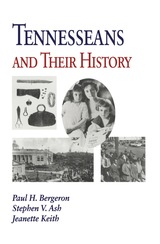 Tennesseans & Their History
Paul H. Bergeron
University of Tennessee Press, 1999 The history of Tennessee is full of dramatic episodes and colorful characters that give the Volunteer State a major place in the American saga. From the bloody battle of Shiloh in 1862 to the Dayton "monkey trial" of 1925 to the assassination of Martin Luther King in Memphis in 1968, Tennessee has been the locale for many of America's most important events.
This new book presents a synthesis of Tennessee history from earliest times to the present. Striking a balance of social, economic, and political perspectives, it moves from frontier times to early statehood, antebellum society through the Civil War to Reconstruction, then establishes Tennessee's place in the New South and in modern times.
Full coverage is devoted to the Civil Rights era and to events in the later years of this century, including environmental issues. The text deals honestly with slavery and segregation and also corrects shortcomings of previous works by placing the state's history in the context of national issues and events within the South.
The authors introduce readers to famous personages like Andrew Jackson and Austin Peay, often using quotations to give them voice. They also tell stories of ordinary people and their lives to show how they are an integral part of history. Sidebars throughout the text highlight stories of particular interest, and reading lists at the end of chapters further enhance the text's utility.
Tennesseans and Their History was written for students needing a basic introduction to state history and to general readers looking for a lively introduction to Tennessee's past. Written to be entertaining as well as instructive, it makes the state's history relevant to a new generation of Tennesseans.
The Authors: Paul H. Bergerson is professor of history at the University of Tennessee and the editor of The Papers of Andrew Johnson.
Stephen V. Ash is associate professor of history at the University of Tennessee and author of Middle Tennessee Transformed, 1860-1870: War and Peace in the Upper South.
Jeanette Keith is associate professor of history at Bloomsburg University and the author of Country People in the New South: Tennessee's Upper Cumberland.
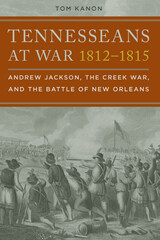 Tennesseans at War, 1812–1815: Andrew Jackson, the Creek War, and the Battle of New Orleans
Tom Kanon
University of Alabama Press, 2014 Tennesseans at War, 1812–1815 by Tom Kanon tells the often forgotten story of the central role citizens and soldiers from Tennessee played in the Creek War in Alabama and War of 1812.
Although frequently discussed as separate military conflicts, the War of 1812 against Great Britain and the Creek War against Native Americans in the territory that would become Alabama were part of the same forceful projection of growing American power. Success in both wars won for America security against attack from abroad and vast tracks of new land in “the Old Southwest.” In Tennesseans at War, 1812–1815, Tom Kanon explains the role Tennesseans played in these changes and how they remade the south.
Because it was a landlocked frontier state, Tennessee’s economy and security depended heavily upon the river systems that traversed the region; some, like the Tennessee River, flowed south out of the state and into Native American lands. Tennesseans of the period perceived that gaining mastery of these waterways formed an urgent part of their economic survival and stability.
The culmination of fifteen years’ research, Kanon’s work draws on state archives, primary sources, and eyewitness accounts, bringing the information in these materials together for first time. Not only does he narrate the military campaigns at the heart of the young nation’s expansion, but he also deftly recalls the economic and social pressures and opportunities that encouraged large numbers of Tennesseans to leave home and fight. He expertly weaves these themes into a cohesive narrative that culminates in the vivid military victories of the War of 1812, the Creek War, and the legendary Battle of New Orleans—the victory that catapulted Tennessee’s citizen-soldier Andrew Jackson to the presidency.
Expounding on the social roles and conditions of women, slaves, minorities, and Native Americans in Tennessee, Kanon also brings into focus the key idea of the “home front” in the minds of Tennesseans doing battle in Alabama and beyond. Kanon shows how the goal of creating, strengthening, and maintaining an ordered society permeated the choices and actions of the American elites on the frontiers of the young nation.
Much more than a history of Tennesseans or the battles they fought in Alabama, Tennesseans at War, 1812–1815, is the gripping story of a pivotal turning point in the history of the young American republic.
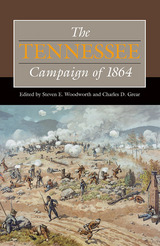 The Tennessee Campaign of 1864
Edited by Steven E. Woodworth and Charles D. Grear
Southern Illinois University Press, 2016 Few American Civil War operations matched the controversy, intensity, and bloodshed of Confederate general John Bell Hood’s ill-fated 1864 campaign against Union forces in Tennessee. In the first-ever anthology on the subject, The Tennessee Campaign of 1864, edited by Steven E. Woodworth and Charles D. Grear, fourteen prominent historians and emerging scholars examine the three-month operation, covering the battles of Allatoona, Spring Hill, and Franklin, as well as the decimation of Hood’s army at Nashville.
Contributors explore the campaign’s battlefield action, including how Major General Andrew J. Smith’s three aggressive divisions of the Army of Tennessee became the most successful Federal unit at Nashville, how vastly outnumbered Union troops held the Allatoona Pass, why Hood failed at Spring Hill and how the event has been perceived, and why so many of the Army of Tennessee’s officer corps died at the Battle of Franklin, where the Confederacy suffered a disastrous blow. An exciting inclusion is the diary of Confederate major general Patrick R. Cleburne, which covers the first phase of the campaign. Essays on the strained relationship between Ulysses S. Grant and George H. Thomas and on Thomas’s approach to warfare reveal much about the personalities involved, and chapters about civilians in the campaign’s path and those miles away show how the war affected people not involved in the fighting. An innovative case study of the fighting at Franklin investigates the emotional and psychological impact of killing on the battlefield, and other implications of the campaign include how the courageous actions of the U.S. Colored Troops at Nashville made a lasting impact on the African American community and how preservation efforts met with differing results at Franklin and Nashville.
Canvassing both military and social history, this well-researched volume offers new, illuminating perspectives while furthering long-running debates on more familiar topics. These in-depth essays provide an expert appraisal of one of the most brutal and notorious campaigns in Civil War history.
 Tennessee Delta Quiltmaking
Teri Klassen
University of Tennessee Press, 2016 “Tennessee Delta Quiltmaking is an excellent study of quilting in rural West Tennessee. Both black and white quilters inhabit the small-farm region, and their quilting traditions are largely shared across racial lines. A study that highlights shared culture, rather than seeking to distinguish racial or ethnic contributions, is a welcome direction in cultural research.”—Alan Jabbour, former director of the American Folklore Society, Library of Congress
Prior to the 1960s, quiltmaking thrived in the Tennessee Delta as a crucial source of warm bedcovers among cash-poor, yet self-sufficient farm households. As agriculture mechanized, rural workers switched to factory jobs and could afford nicer houses and blankets. Quiltmaking survived because women—both black and white—reinvented it as a hobby that met personal and social needs. Though scholars have studied quilt styles with rural southern roots, few have considered black and white quiltmakers together or as part of a shared regional culture.
In Tennessee Delta Quiltmaking, Teri Klassen traces how mid-twentieth-century common quilts developed from nineteenth-century styles. Through interviews with people from rural households, Klassen uncovers the ways in which designs and labor were shared and the ways in which quiltmaking was part of the small-farm culture that was common to blacks and whites. While quiltmaking was a creative form passed down in families, limited means and accessible materials made it both a necessity and a highly evolved custom in southwestern Tennessee’s upper Delta region. For families in this region, the quilt symbolized homemaker competence and self-reliance, a trait especially valued by sharecroppers and tenant-farmers who owned no land. The culture of quiltmaking reflected living conditions and values of these folk, and Klassen details numerous changes in this culture, from how it contributed to small-farm stability to how industrialization affected the practice.
By considering quiltmaking’s practical, aesthetic, and social aspects in a historical, mixed-race context, Tennessee Delta Quiltmaking makes a unique contribution to the study of the Tennessee Delta and the understanding of common-quilt design.
TERI KLASSEN is a postdoctoral research associate at the Mathers Museum of World Cultures at Indiana University. Her articles have appeared in Journal of American Folklore, Midwestern Folklore, and Journalism Quarterly.
Tennessee Government and Politics: Democracy in the Volunteer State
John R. Vile
Vanderbilt University Press, 1998 Tennessee Government and Politics offers a timely and comprehensive new survey of the state's political evolution. With its concise historical analysis, up-to-date presentation of contemporary issues, and appended state constitution, Tennessee Government and Politics will serve as a primary text for any course on Tennessee government and as a supplemental text for broader courses in state and local government or southern politics.
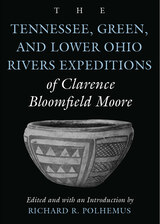 The Tennessee, Green, and Lower Ohio Rivers Expeditions of Clarence Bloomfield Moore
Clarence Bloomfield Moore, edited and introduced by Richard R. Polhemus
University of Alabama Press, 2002 This richly illustrated book is the eighth of nine Classics in Southeastern Archaeology volumes based on Moore's investigations along the waterways of eastern North America.
This oversized reprint volume presents original materials from Moore's northernmost expeditions conducted in the early 1900s as he surveyed areas of potential archaeological interest in the southeastern United States. Some of the sites he found were later targeted for major excavations during the days of the WPA/CCC. Many National Register Historic Sites are today located along the rivers he explored in this work. In many cases, however, Moore's report documents sites since destroyed by river action or by lake impoundments behind hydroelectric dams or by looters.
As with all of Moore's other investigations, his thorough documentation and collaboration with other scholars advanced understanding of aboriginal peoples and fueled debate among the experts. For instance, more than 296 burials were recovered from Indian Knoll on the Green River in Kentucky. Some graves included ceremonially "killed" artifacts, dogs buried with both adults and children, and exotic materials leading to speculations concerning origins, usage, and trade networks. Stone box graves were widespread and somewhat exclusive to this area, giving rise to early assumptions regarding kinship between scattered modern Indian tribes.
Richard Polhemus has compiled a comprehensive inventory of Moore's work in Tennessee, Alabama, Mississippi, and Kentucky and written a concise introduction to place the work in context. In so doing, he has made available to contemporary scholars of history, archaeology, and anthropology a trove of resource material on one of the most archaeologically rich and artifact-diverse regions in the nation.
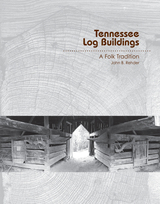 Tennessee Log Buildings: A Folk Tradition
John B. Rehder
University of Tennessee Press, 2012 Drawing on more than four decades of research, Tennessee Log Buildings examines one of the Volunteer State’s most precious—and fast-disappearing—traditions. From the pioneer era through the mid–twentieth century, folk builders in Tennessee used logs to construct cabins, barns, other outbuildings, schools, and churches. In warm, accessible prose that often makes this deeply researched work read like guidebook, John Rehder explores the varied styles and architectural characteristics of these fascinating structures, including their floor plans, the types of timber used, and the different notches that were cut into the logs to secure the structures.
Profusely illustrated with over one hundred images, Tennessee Log Houses traces the evolution of log houses from one-room (or single-pen) dwellings to more elaborate homes of various types, such as saddlebags, Cumberland houses, dogtrots, and two-story I-houses. Rehder discusses the historic settlement patterns and building traditions that led to this variety of house types and identifies their particular occurrences throughout the state by drawing on surveys conducted in forty-two counties by teams working for the Tennessee Historical Commission (THC). Similarly, he explores disparate barn and outbuilding types, including the distinctive cantilever barns that are found predominantly in East Tennessee. Sprinkled throughout the book are engaging anecdotes that convey just what it is like to conduct field research in remote rural areas. Rehder also describes in detail a number of the state’s exceptional log places, among them Wynnewood, an enormous structure in Middle Tennessee which dates back to the early nineteenth century and which suffered severe tornado damage in 2008.
As the author notes, many of the buildings originally identified in the THC investigations have now vanished completely while others are in serious disrepair. Thus, this book not only offers an instructive and delightful look at a key part of Tennessee’s heritage but also makes an eloquent plea for its preservation.
Until his death in 2011, JOHN B. REHDER was a professor of geography at the University of Tennessee, Knoxville. He first joined the UT faculty in 1967. He was the author of Appalachian Folkways, which won the Pioneer America Society’s Fred B. Kniffen Book Award in 2004, and Delta Sugar: Louisiana’s Vanishing Plantation Landscape, which won the Vernacular Architecture Forum’s 2000 Abbott Lowell Cummings Award.
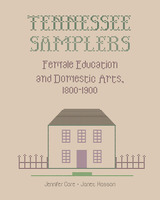 Tennessee Samplers: Female Education and Domestic Arts, 1800–1900
Jennifer Core
University of Tennessee Press, 2024 “This extensive study, nearly twenty years in the making, is a major contribution to the understanding of American textile material culture.” – Candace J. Adelson, Senior Curator of Fashion and Textiles Emeritus, Tennessee State Museum
Containing dozens of beautiful, full-color photographs, Jennifer C. Core and Janet S. Hasson’s study of samplers—embroideries that are “first attempts at a new technique, color combination, or unusual material”—provides vivid descriptions of this nineteenth-century Tennessee art form in its many varieties. The authors not only catalogue and describe samplers from each of Tennessee’s major regions—West, Middle, and East—but also incorporate research on the sampler makers and their families. This research provides fascinating insight into the stitchers, their teachers, and their academies.
Including a chapter on female education on the Tennessee frontier and another on embroideries and needlework focused on mourning, the volume draws on oral histories of the embroiderers’ descendants, family Bibles, diaries, scrapbooks, cemetery records, and other primary sources. Photos of the samplers are accompanied by detailed descriptions of styles, thread count, materials used, frames, and motifs. Ultimately, the study provides a glimpse of the lives of girls and young women in nineteenth-century Tennessee, including the role of this ornamental art in their education.
Providing important historical context on Tennessee education, economy, and domestic life, Core and Hasson describe how embroidery came to be a crucial primary source in revealing the lives of girls and young women during a time when little was recorded about them. This book is an authoritative record of the material culture produced in the daily routine of school rooms. It is for all who see beauty in sometimes-overlooked handiwork and understand the importance of curating, preserving, and analyzing it.
 Tennessee Secedes: A Documentary History
Dwight Pitcaithley
University of Tennessee Press, 2021 The election of 1860 put to rest a tumultuous decade of legislative contest over the institution of slavery—even as it set in motion events that led directly to its demise by civil war. While some scholarship tends to minimize the role of slavery in the secession of the Southern states in the early 1860s, Dwight Pitcaithley’s Tennessee Secedes: A Documentary History takes the opposite approach, examining the many factors that both fueled and complicated Tennessee’s unique journey toward secession in 1861.
Organized chronologically by source and speaker, Tennessee Secedes presents a selection of primary sources from December 1860 through the summer of 1861, inviting students to examine the arc of Tennessee’s secession march. Pitcaithley introduces proclamations, declarations, addresses, resolutions, proposed constitutional amendments, and other materials from Tennessee legislators, members of Congress, and delegates to the East Tennessee Convention. These sources highlight the political divisions apparent in the Volunteer State during this season of unrest. While many other Southern states saw little support for Unionism in the early 1860s, Tennessee stood in stark contrast, with a large and vocal population that ardently opposed secession.
Complete with appendices featuring 1861 election returns, communications from the Tennessee Congressional Delegation of the Thirty-Sixth Congress, and a timeline for Secession Winter—as well as questions for further discussion—Tennessee Secedes is an invaluable resource for students of the Civil War and Tennessee history, offering an insightful analysis of Tennessee’s uncertain path to the Confederacy in the summer of 1861.
Tennessee Strings: The Story of Country Music in Tennessee
Charles K. Wolfe
University of Tennessee Press, 1977 Country music grew up in Tennessee, drawing from sources in the white rural music of East and Middle Tennessee, from the church music of country singing conventions, and from the black music of the Memphis area. With the commercialization of this musical fusion through radio and recording, Tennessee
soon became a national center for country music. Then, in the post-war years as the Grand Ole Opry gained recognition, country music achieved worldwide popularity and significance with Nashville a it axis. In Tennessee Strings, renowned music scholar Charles K. Wolfe trace for the first time the vital role played by Tennessee and its musicians in the development of this unique American art form.
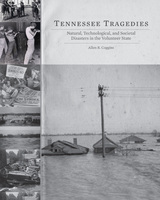 Tennessee Tragedies: Natural, Technological, and Societal Disasters in the Volunteer State
Allen R. Coggins
University of Tennessee Press, 2012
A one-of-a-kind reference book, Tennessee Tragedies examines a wide variety of disasters that have occurred in the Volunteer State over the past several centuries. Intended for both general readers and emergency management professionals, it covers natural disasters such as floods, tornadoes, and earthquakes; technological events such as explosions, transportation wrecks, and structure fires; and societal incidents including labor strikes, political violence, lynchings, and other hate crimes.
At the center of the book are descriptive accounts of 150 of the state’s most severe events. These range from smallpox epidemics in the eighteenth century to the epic floods of 1936–37, from the Sultana riverboat disaster of 1865 (the worst inland marine accident in U.S. history) to the 1968 assassination of Dr. Martin Luther King Jr. Included as well are stories of plane crashes, train wrecks, droughts, economic panics, and race riots. An extensive chronology provides further details on more than 900 incidents, the most complete listing ever compiled for a single state. The book’s introduction examines topics that include our fascination with such tragedies; major causes of death, injury, and destruction; and the daunting problems of producing accurate accountings of a disaster’s effects, whether in numbers of dead and injured or of economic impact. Among the other features are a comprehensive glossary that defines various technical terms and concepts and tables illustrating earthquake, drought, disease, and tornado intensity scales.
A work of great historical interest that brings together for the first time an impressive array of information,Tennessee Tragedies will prove exceptionally useful for those who must respond to inevitable future disasters.
 Tennessee Women in the Progressive Era: Toward the Public Sphere in the New South
Mary A. Evins
University of Tennessee Press, 2013
Discussions of Tennessee women’s history during the Progressive Era tend to focus narrowly on the critical issue of suffrage and the ratification of the Nineteenth Amendment. While the achievement of Tennessee’s suffragists remains a feather in the state’s historic cap—pushing the legislature to cast the votes that settled the issue for the nation—reform-minded Tennessee women in the late-nineteenth and early-twentieth centuries participated in a wide range of other public-sphere activities. The first exploration of the work and lives of Progressive Era Tennessee women beyond their involvement in the battle for the right to vote, this pioneering compilation provides a fuller portrait of the work undertaken by these bold activists to improve the lives of their fellow citizens.
Ranging in subject matter from the role of women’s missionary organizations and efforts to end lynching to the challenges of agricultural reform and the development of stronger educational institutions, these essays consider a wide variety of reform efforts that engaged progressive women in Tennessee before, during, and after the suffrage movement. Throughout, the contributors emphasize the influence of religion on women’s reform efforts and examine the ways in which these women expanded their public roles while at the same time professing loyalty to more traditional models of womanhood. In demonstrating Tennessee women’s engagement with politics long before they had the vote, ran for office, or served on juries, these essays also support the argument that a broader definition of “politics” permits a fuller incorporation of women’s public activities into U.S. political history.
By focusing on the actual work reform-minded women performed, whether paid employment or volunteer efforts, this anthology illustrates myriad ways in which these individuals engaged their communities and reveals the motivations that drove them to improve society. Marshaling precise and detailed evidence that illuminates the meanings of progressivism to Tennessee’s female activists, the essays in this valuable compendium connect Tennessee women to the larger movements for reform that dominated the early-twentieth-century American experience.
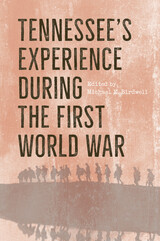 Tennessee's Experience during the First World War
Michael E. Birdwell
University of Tennessee Press, 2023 “On the day that Archduke Franz Ferdinand, heir to the Austrian throne, was assassinated, Tennesseans worried about the weather,” Carole Bucy writes. Indeed, the war that began in Europe in 1914 was unimaginably remote from Tennessee—until it wasn’t.
Drawing on a depth of research into a wide array of topics, this vanguard collection of essays aims to conceptualize World War I through the lens of Tennessee. The book begins by situating life in Tennessee within the greater context of the war in Europe, recounting America’s growing involvement in the Great War. As the volume unfolds, editor Michael E. Birdwell and the contributors weave together soldier narratives, politics and agribusiness, African American history, and present-day recollections to paint a picture of Tennessee’s Great War experience that is both informative and gripping.
An essential addition to the broader historiography of the American experience during World War I, this collection of essays presents Tennessee stories that are close to home in more than just geography and lineage. By relating international conflict through the eyes of Tennessee’s own, editor Michael E. Birdwell and the contributing authors provide new opportunities for academics and general readers alike to engage with the Great War from a unique and—until now—untold perspective.
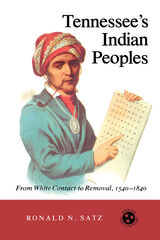 Tennessee's Indian Peoples: From White Contact To Removal, 1540-1840
Ronald N. Satz
University of Tennessee Press, 1979 Hernando De Soto’s invasion of Native lands in 1540 marked the onslaught of great change in the lives of Tennessee’s Native Americans. Although these first Tennesseans boasted a cultural heritage of thousands of years, only three centuries of contact with the white man elapsed before their population was decimated and the remnants driven out. The Indians were a settled people when de Soto visited, not the savage or exotic woods creatures so often depicted. Tennessee’s Indian Peoples, then, is a story of the ways the Cherokees, Chickasaws, Creeks, Shawnees, and other Indian peoples lived, reared families, farmed and hunted, worshipped, played, fought, and governed themselves. He describes also the eventful destruction of their societies—destroyed not only by external pressures for Indian lands, but also by internal change wrought by increasing dependence on the white man’s trade goods.
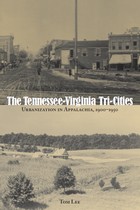 The Tennessee-Virginia Tri-Cities: Urbanization in Appalachia, 1900-1950
Tom Lee
University of Tennessee Press, 2010 In 1900, the Appalachian region of northeast Tennessee and southwest Virginia began to change. The inhabitants were dependent on the resources of the rural land, but the arrival of railroads spawned industrialization. Over the next several decades, families moved down from the mountains into the valley of East Tennessee as workers took jobs in the developing urban centers. Country stores, two-lane roads, and cornfields would eventually give way to cities, multi-lane highways, and new housing. The Tri-Cities—Kingsport, Johnson City, and Bristol—were starting to form.In this carefully documented book, Tom Lee uses archival material, newspapers, memoirs, and current scholarship in Appalachian studies to examine the economic changes that took place in the Tri-Cities region from 1900 to 1950. With modernization and urbanization, an urban-industrial strategy of economic development evolved. The entry of extractive industry into the mountains established the power of the urban elite to shape rural life. Local businessmen saw the route to financial strength in the recruitment of low-wage industry. Workers left struggling farms for factory jobs. This urban-rural relationship supported the Tri-Cities’ manufacturing economy and gave power to the area’s elite. The New Deal and the Second World War broadened this relationship as federal funding sustained the economy. The advantages of urban centers after decades of development left rural communities on the verge of disappearance and dependent on the jobs, opportunities, and economic vision of the cities. By 1950, the power of Appalachia’s elite over the people of the region had extended beyond urban boundaries and brought about the conditions necessary for the creation of the metropolitan Tri-Cities area of today. Readers will gain a better understanding of the complexity of modernization in Appalachia and the rural South from this engaging book.
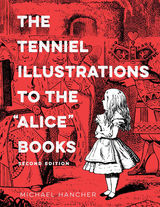 The Tenniel Illustrations to the “Alice” Books, 2nd edition
Michael Hancher
Ohio State University Press, 2019 Lewis Carroll’s two Alice books are among the most popular works of English literature thanks in part to the ninety-two indelible illustrations that John Tenniel drew for them. The Tenniel Illustrations to the “Alice” Books situates their outstanding success in several historical contexts, including Tenniel’s career as a leading artist for Punch magazine.
This new edition also pays special attention to the material circumstances that enabled and conditioned the printing of the illustrations. The original twelve chapters have been revised and updated throughout, drawing on archival and published resources made available in recent decades. Six chapters are entirely new, explaining how Tenniel’s drawings were professionally hand-engraved on wood blocks; how electrotype replicas were made from those blocks; and what problems could mar the commercial printing of such images—as notoriously happened in the first printing of Alice’s Adventures in Wonderland, which Carroll suppressed on Tenniel’s advice. Also considered for the first time here are the coloring of Tenniel’s black-and-white illustrations, by Tenniel and other artists, and the extraordinary treatment later given to Tenniel’s illustrations by the prestigious Limited Editions Club.
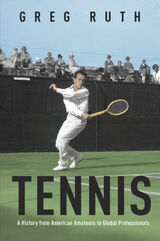 Tennis: A History from American Amateurs to Global Professionals
Greg Ruth
University of Illinois Press, 2021 Analyzing how tennis turned pro The arrival of the Open era in 1968 was a watershed in the history of tennis--the year that marked its advent as a professionalized sport. Merging wide-angle history with individual stories of players and off-the-court figures, Greg Ruth charts tennis’s evolution into the game we watch today. His vivid account moves from the cloistered world of nineteenth-century lawn tennis through the longtime amateur-professional divide and the battles over commercialization that raged from the 1920s until 1968. From there, Ruth details the post-1968 expansion of the game as it was transformed by bankable superstars, a popular women’s tour, rival governing bodies, and sponsorship money. What emerges is a fascinating history of the economics and politics that made tennis a decisive, if unlikely, force in the creation of modern-day sports entertainment. Comprehensive and engaging, Tennis tells the interlocking stories of the figures and factors that birthed the professional game.
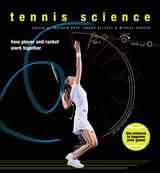 Tennis Science: How Player and Racket Work Together
Bruce Elliott, Machar Reid, and Miguel Crespo
University of Chicago Press, 2015 If you have watched a Grand Slam tennis tournament in the past decade, you are probably aware that the game is dominated by just a few international powerhouses. At the conclusion of each tournament, it is likely that you will see Serena Williams atop the women’s podium and a member of the Big Four—Roger Federer, Rafael Nadal, Novak Djokovic, and Andy Murray—hoisting the trophy for the men. And while there is not a lot of variety in the outcome of these matches, the game of tennis itself has changed drastically over the decades, as developments in technology and conditioning regimens, among other factors, have altered the style of play. Underpinning many of these developments is science, and this book explains the scientific wonders that take the ball from racket to racket and back again.
Each chapter explores a different facet of the game—learning, technique, game analysis, the mental edge, physical development, nutrition for performance and recovery, staying healthy, and equipment—and is organized around a series of questions. How do we learn the ins and outs of hitting the ball in and not out? What are the main technological developments and software programs that can be used to assist in performance and notational analysis in tennis? What role does sports psychology play in developing a tennis player? What is the role of fluid replacement for the recreational, junior, and professional player? What rule changes have been made with respect to the racket, ball, and ball-court interaction to maintain the integrity of the game in the face of technological change? Each question is examined with the aid of explanatory diagrams and illustrations, and the book can be used to search for particular topics, or read straight through for a comprehensive overview of how player and equipment work together.
Whether you prefer the grass courts of Wimbledon, the clay courts of the French Open, or the hard courts of the US and Australian Opens, Tennis Science is a must-have for anyone interested in the science behind a winning game.
 Tennyson and the Doom of Romanticism
Herbert F. Tucker
Harvard University Press, 1988 Although the reaction against Tennyson may have begun at his funeral, there is not doubt he was the central English poet of the nineteenth century as well as a fixture of the Victorian age—the fashioner of a public image that, in Tennyson’s case, bears a complex relation to the poetic imagination itself. Herbert Tucker provides a definitive account of the first half of Tennyson’s career, arguing that the poet self-consciously constructed his creative life in a dynamic balance with the work of his Romantic predecessors and with variously seductive and repellent features of Victorian culture.
Tucker narrates the life in Tennyson’s poems through a linked sequence of close readings, which supplement intrinsic interpretation of texts with considerations of Tennyson’s romantic allusiveness, generic experimentation, and aspiration to cultural spokesmanship. Explication of major poems from Tennyson’s formative years through the first decade of his unparalleled ascendancy illustrates the ways in which his original and pervasive sense of inevitability found developing expression, as a matter both of poetic form and of poetic argument. Tucker shows how Tennyson, through the authority of verbal craft that was his hallmark, consistently elaborated upon the fatalistic, intimate yet impersonal melancholy that was a source, and at length a result, of his prodigious public success.
Anyone interested in Victorian literature will read this book with profit, for it tells us a great deal not only about the preeminent Victorian poet but also about the cultural turn of mind that transformed Romanticism, during the second quarter of the nineteenth century, into a Victorian mode.
Tennyson and Tradition
Robert Pattison
Harvard University Press, 1979 Here is an analysis of Tennyson’s major poetry that clarifies the poet’s relationship to the artistic traditions he so extensively exploited and so radically modified. It is a portrait of Tennyson as manipulator, not mere borrower, of forms.
Tennyson and Tradition traces the threads that at the same time unite Tennyson’s work and tie it to the traditions the poet believed he had inherited. Robert Pattison shows why Tennyson considered the venerable idyll form a fitting vehicle for his modern portraits—above all the Idylls of the King. Analysis of In Memoriam brings further understanding of Tennyson’s poetic credo.
 Tennysonian Love: The Strange Diagonal
Gerhard Joseph
University of Minnesota Press, 1969
Tennysonian Love was first published in 1969. Minnesota Archive Editions uses digital technology to make long-unavailable books once again accessible, and are published unaltered from the original University of Minnesota Press editions.
In the century or so since Alfred Tennyson's poetry reached the height of its popularity and critical acclaim, the pendulum of criticism has swung wide in opposite directions. From the earlier idolatry to the later ridicule, that pendulum has now settled into a position of qualified and selective praise from which a more thoughtful consideration of the poet is possible. Consequently, as this critical study suggests, new values and dimensions are recognizable in his work.
Professor Joseph, concentrating on the theme of love but involving in his argument other facets of Tennyson's achievement, demonstrates the thesis that the poet moved as in a "strange diagonal." This phrase used as the subtitle of the book comes from Tennyson's poem The Princess in which the narrator "moved as in a strange diagonal / And maybe neither pleased myself nor them."
As the author shows, Tennyson throughout his work moved between a Platonic conception of love in which the highest kind of spiritual love has disencumbered itself of sense and a Neoplatonic ("Dantesque") one in which sense and soul tend to merge. In coming to terms with the nineteenth-century form of this divided Western heritage, the pietism of the evangelical revival on the one hand and the idealized eroticism of his Romantic predecessors on the other, Tennyson became the exemplary poet of Victorian love. No other Victorian poet, Professor Joseph concludes, exhibits quite his representative and successful blending of these clashing strains. For while moving between the alternate traditions of Western love, Tennyson was able to forge a large body of highly disciplined, beautifully wrought, and far-ranging verse.
 Tennyson'S Characters: "Strange Faces, Other Minds"
David Goslee
University of Iowa Press, 1989
Scholars since Paden have commented on the anxieties embedded in Tennyson's poetry, but this is the first study to examine them systematically. Within each poem Goslee discovers a vulnerable authorial presence threatened by some Other—a personification of divine, sexual, or natural power—which encroaches upon it from the fringes of the poem's imaginative universe. This Other is always interpreted, humanized, or conciliated by some mediating figure, yet the more effectively the mediator confronts an otherwise alien cosmos, the more alien he or she becomes to the authorial presence.
Goslee's approach toward understanding the conflict between Tennyson and the characters he creates includes elements of formalism, psychodynamics, and literary history without being narrowly confined to any one of these. His subtle, elegant reading mediates between those critics who stress authorial intention (e.g., Reed's Perception and Design) and the growing number of critics who follow E. D. H. Johnson in claiming that Tennyson wrote more subversively than he wanted to admit. This original, highly suggestive volume will be important for all Victorian scholars and literary critics.
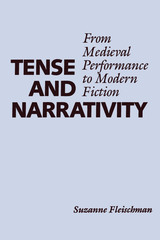 Tense and Narrativity: From Medieval Performance to Modern Fiction
By Suzanne Fleischman
University of Texas Press, 1990 In this pathfinding study, Suzanne Fleischman brings together theory and methodology from various quarters to shed important new light on the linguistic structure of narrative, a primary and universal device for translating our experiences into language. Fleischman sees linguistics as laying the foundation for all narratological study, since it offers insight into how narratives are constructed in their most primary context: everyday speech. She uses a linguistic model designed for "natural" narrative to explicate the organizational structure of "artificial" narrative texts, primarily from the Middle Ages and the postmodern period, whose seemingly idiosyncratic use of tenses has long perplexed those who study them. Fleischman develops a functional theory of tense and aspect in narrative that accounts for the wide variety of functions—pragmatic as well as grammatical—that these two categories of grammar are called upon to perform in the linguistic economy of a narration.
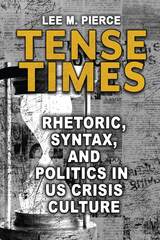 Tense Times: Rhetoric, Syntax, and Politics in US Crisis Culture
Lee M. Pierce
University of Alabama Press, 2023 How the syntax used in US political discourse creates the very crises it describes
American public culture is obsessed with crisis. Political polarization, economic collapse, moral decline—the worst seems always yet to come and already here. Tense Times argues that the ways we discuss these crises, especially through verb tenses, not only contribute to our perception and description of such crises but create them.
Past. Present. Future. These are the three principal verb tenses—the category of syntax that allows us to discuss time—that account for much of what is written about our crisis culture. Lee M. Pierce invites readers to expand their syntactic inventory beyond tense to include aspect (duration) and mood (attitude). Doing so opens new possibilities for understanding crisis discourse, as Pierce demonstrates with close readings of three syntaxes: the historical present, the past imperfective, and the retroactive subjunctive. Each mode produces a different experience of crisis and can help us understand our current political reality.
The book investigates a dozen widely circulated discourses from the past decade of US political culture, from Beyoncé’s controversial hit single “Formation” to the presidential campaign slogans of Hillary Clinton and Donald Trump, from the dueling rallies of Glenn Beck and Jon Stewart at the National Mall to the Ground Zero Mosque controversy and the 2007–2008 bailout. Taking a comparative approach that integrates theories of syntax from rhetorical, literary, affect, and cultural studies as well as linguistics, computer science, and Black studies, Tense Times suggests that the public’s conjuring of crisis is not inherently problematic. Rather, it is the openness of that crisis to contingency—the possibility that things could have been otherwise—that ought to concern anyone interested in language, politics, American culture, current events, or the direction this country is headed.
The Tension Of Paradox: José Donoso’s the Obscene Bird of Night As Spiritual Exercises
Pamela May Finnegan
Ohio University Press, 1992 Pamela Finnegan provides a detailed criticism of a major novel written by one of Chile’s leading literary figures. She analyzes the symbolism and the use of language in The Obscene Bird of Night, showing that the novel’s world becomes an icon characterized by entropy, parody, and materiality. Her study concludes that all linguistic ordering fictionalizes, that the lack of spirituality within the novel’s world is symptomatic of language gone stale, and that blindness to this fact leads to dogma or solipsism, each counter-productive to communication and human endeavor. To revive the linguistic system, she argues, we must revive the creative power of language.
Tensions in the American Dream: Rhetoric, Reverie, or Reality
Roderick Bush
Temple University Press, 2015 Could the promise of upward mobility have a dark side? In Tensions in the American Dream, Melanie and Roderick Bush ask, how does a "nation of immigrants" pledge inclusion, yet marginalize so many citizens based on race, class, and gender? The authors consider the origins and development of the U.S. nation and empire; the founding principles of belonging, nationalism, and exceptionalism; and their lived reality.
Tensions in the American Dream also addresses the relevancy of nation to empire in the context of the historical world capitalist system. The authors ask, is the American Dream a reality only questioned by those unwilling or unable to achieve it? What is the "good life" and how is it particularly "American"?
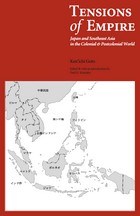 Tensions Of Empire: Japan and Southeast Asia in the Colonial and Postcolonial World
Ken’ichi Goto
Ohio University Press, 2003 Beginning with the closing decade of European colonial rule in Southeast Asia and covering the wartime Japanese empire and its postwar disintegration, Tensions of Empire focuses on the Japanese in Southeast Asia, Indonesians in Japan, and the legacy of the war in Southeast Asia. It also examines Japanese perceptions of Southeast Asia and the lingering ambivalence toward Japanese involvement in Asia and toward the war in particular. Drawing on extensive multilingual archival research and interviews, Ken‘ichi Goto has produced a factually rich and balanced view of this region’s historical events of the last century. Tensions of Empire features detailed discussions of Portuguese Timor in the 1930s and 1940s, the decolonization of Malaya, and twentieth-century Indonesia. This extended inquiry yields a unique view of the complicated network within and beyond the colonial and imperial relationships between a one-time nonwestern colonial power and an entire region. Of great interest to students of Japan-Southeast Asia relations and to specialists in the modern history of both Southeast Asia and Japan, Professor Goto’s Tensions of Empire is a fascinating account of Japan’s recent past from the inside.
Tensorial Analysis of Networks (TAN) Modelling for PCB Signal Integrity and EMC Analysis
Blaise Ravelo
The Institution of Engineering and Technology, 2020 This book describes a fast, accurate and flexible modelling methodology for PCBs. The model uses the concept of tensorial analysis of networks (TAN) based on Kron's and Kron-Branin's methods adapted for the EMC use by O. Maurice. The TAN approach is applied to the PCB SI and electromagnetic compatibility (EMC) analysis.
Tent of Miracles
Jorge Amado; translated by Barbara Shelby Merello
University of Wisconsin Press, 2003 The Wisconsin edition is not for sale in the British Commonwealth (excluding Canada), the Republic of Ireland, or South Africa.
Tentative Transgressions: Homosexuality, AIDS, and the Theater in Brazil
Severino J. Albuquerque
University of Wisconsin Press, 2004 Starting at the beginning of the twentieth century, Albuquerque examines the way the Modernist movement both fueled and inhibited the use of gay imagery in Brazilian drama. This elegant and fluid study ultimately becomes an examination of a whole Latin society, and the ways in which Latin theatre has absorbed and reflected the culture's own changing sensibilities, that will intrigue anyone interested in Latin American culture, literature, or theater. Winner, 2008 Elizabeth A. Steinberg Prize
The Tented Field: A History of Cricket in America
Tom Melville
University of Wisconsin Press, 1998 Tom Melville presents a well-documented history of cricket playing in America, focusing on its period of growth in the 1840s and its periodic revivals. Cricket failed to take on, or resisted, an American identity, but the sport had considerable appeal both as a sport and as an activity that fostered sportsmanship, control, public manners, and decorum. Cricket found acceptance mainly in the upper class but also appealed to working-class people.
 The Tenth Muse: Victorian Philology and the Genesis of the Poetic Language of Gerard Manley Hopkins
By Cary H. Plotkin
Southern Illinois University Press, 1989 With authority and sensitivity Plotkin traces the close relationship between Hopkins’s poetry and the theories of language suggested in his Journals and expounded by Victorian philologists such as Max Müller and George Marsh. Plotkin seeks to determine what changed Hopkins’s perception of language between the writing of such early poems as "The Habit of Perfection" and "Nondum" (1866) and his creation of The Wreck of the Deutschland (1875–76). Did the language of the ode, and of Hopkins’s mature poetry generally, arise as spontaneously as it appears to have done, or does it have a traceable genesis in the ways in which language as a whole was conceived and studied in mid-century England? In answer, Plotkin fixes the development of Hopkins’s singular poetic language in the philological context of his time. If one is to understand Hopkins’s writings and poetic language in the context in which they developed rather than in the terms of a present-day theory of history or textuality, then that movement in all of its complexity must be considered. Hopkins "translates" into the language of poetry patterns and categories common to Victorian language study.
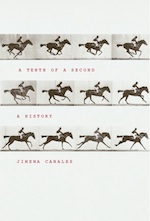 A Tenth of a Second: A History
Jimena Canales
University of Chicago Press, 2009 In the late fifteenth century, clocks acquired minute hands. A century later, second hands appeared. But it wasn’t until the 1850s that instruments could recognize a tenth of a second, and, once they did, the impact on modern science and society was profound. Revealing the history behind this infinitesimal interval, A Tenth of a Second sheds new light on modernity and illuminates the work of important thinkers of the last two centuries. Tracing debates about the nature of time, causality, and free will, as well as the introduction of modern technologies—telegraphy, photography, cinematography—Jimena Canales locates the reverberations of this “perceptual moment” throughout culture. Once scientists associated the tenth of a second with the speed of thought, they developed reaction time experiments with lasting implications for experimental psychology, physiology, and optics. Astronomers and physicists struggled to control the profound consequences of results that were a tenth of a second off. And references to the interval were part of a general inquiry into time, consciousness, and sensory experience that involved rethinking the contributions of Descartes and Kant. Considering its impact on much longer time periods and featuring appearances by Henri Bergson, Walter Benjamin, and Albert Einstein, among others, A Tenth of a Second is ultimately an important contribution to history and a novel perspective on modernity.
Tents, Tigers and the Ringling Brothers
Jerry Apps
Wisconsin Historical Society Press, 2007 This new addition to the Badger Biography series for young readers features the story of the young Ringling brothers of circus fame. The book tells the inspiring story of the seven sons of German and French immigrants who were guided by their dreams to escape poverty through hard work and ambition. These entrepreneurial brothers moved with their parents to Baraboo, Wisconsin where their fantastic circus adventure began. With no circus experience, the brothers tackled one of the riskiest businesses of the time. Each brother contributed his unique talents to make their enterprise successful. The Ringling Brothers were admired for their technological innovations, strategy and devotion to education. They were also esteemed for their genuine appreciation of their audience.
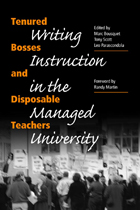 Tenured Bosses and Disposable Teachers: Writing Instruction in the Managed University
Edited by Marc Bousquet, Tony Scott, and Leo Parascondola. Foreword by Randy Martin
Southern Illinois University Press, 2003 Tenured Bosses and Disposable Teachers: Writing Instruction in the Managed University exposes the poor working conditions of contingent composition faculty and explores practical alternatives to the unfair labor practices that are all too common on campuses today. Editors Marc Bousquet, Tony Scott, and Leo Parascondola bring together diverse perspectives from pragmatism to historical materialism to provide a perceptive and engaging examination of the nature, extent, and economics of the managed labor problem in composition instruction—a field in which as much as ninety-three percent of all classes are taught by graduate students, adjuncts, and other “disposable” teachers. These instructors enjoy few benefits, meager wages, little or no participation in departmental governance, and none of the rewards and protections that encourage innovation and research. And it is from this disenfranchised position that literacy workers are expected to provide some of the core instruction in nearly everyone's higher education experience. Twenty-six contributors explore a range of real-world solutions to managerial domination of the composition workplace, from traditional academic unionism to ensemble movement activism and the pragmatic rhetoric, accommodations, and resistances practiced by teachers in their daily lives. Contributors are Leann Bertoncini, Marc Bousquet, Christopher Carter, Christopher Ferry, David Downing, Amanda Godley, Robin Truth Goodman, Bill Hendricks, Walter Jacobsohn, Ruth Kiefson, Paul Lauter, Donald Lazere, Eric Marshall, Randy Martin, Richard Ohmann, Leo Parascondola, Steve Parks, Gary Rhoades, Eileen Schell, Tony Scott, William Thelin, Jennifer Seibel Trainor, Donna Strickland, William Vaughn, Ray Watkins, and Katherine Wills.
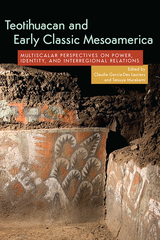 Teotihuacan and Early Classic Mesoamerica: Multiscalar Perspectives on Power, Identity, and Interregional Relations
Claudia García-Des Lauriers
University Press of Colorado, 2021 The Early Classic period in Mesoamerica has been characterized by the appearance of Teotihuacan-related material culture throughout the region. Teotihuacan, known for its monumental architecture and dense settlement, became an urban center around 100 BC and a regional state over the next few centuries, dominating much of the Basin of Mexico and beyond until its collapse around AD 650. Teotihuacan and Early Classic Mesoamerica explores the complex nature of Teotihuacan’s interactions with other regions from both central and peripheral vantage points.
The volume offers a multiscalar view of power and identity, showing that the spread of Teotihuacan-related material culture may have resulted from direct and indirect state administration, colonization, emulation by local groups, economic transactions, single-event elite interactions, and various kinds of social and political alliances. The contributors explore questions concerning who interacted with whom; what kinds of materials and ideas were exchanged; what role interregional interactions played in the creation, transformation, and contestation of power and identity within the city and among local polities; and how interactions on different scales were articulated. The answers to these questions reveal an Early Classic Mesoamerican world engaged in complex economic exchanges, multidirectional movements of goods and ideas, and a range of material patterns that require local, regional, and macroregional contextualization.
Focusing on the intersecting themes of identity and power, Teotihuacan and Early Classic Mesoamerica makes a strong contribution to the understanding of the role of this important metropolis in the Early Classic history of the region. The volume will be of interest to scholars and graduate students of Mesoamerican archaeology, the archaeology of interaction, and the archaeology of identity.
Contributors: Sarah C. Clayton, Fiorella Fenoglio Limón, Agapi Filini, Julie Gazzola, Sergio Gómez-Chávez, Haley Holt Mehta, Carmen Pérez, Patricia Plunket, Juan Carlos Saint Charles Zetina, Yoko Sugiura, Gabriela Uruñuela, Gustavo Jaimes Vences
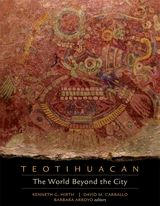 Teotihuacan: The World Beyond the City
David M. Carballo
Harvard University Press Teotihuacan was a city of major importance in the Americas between 1 and 550 CE. As one of only two cities in the New World with a population over one hundred thousand, it developed a network of influence that stretched across Mesoamerica. The size of its urban core, the scale of its monumental architecture, and its singular apartment compounds made Teotihuacan unique among Mesoamerica’s urban state societies.
Teotihuacan: The World Beyond the City brings together specialists in art and archaeology to develop a synthetic overview of the urban, political, economic, and religious organization of a key power in Classic-period Mesoamerica. The book provides the first comparative discussion of Teotihuacan’s foreign policy with respect to the Central Mexican Highlands, Oaxaca, Veracruz, and the Maya Lowlands and Highlands. Contributors debate whether Teotihuacan’s interactions were hegemonic, diplomatic, stylistic, or a combination of these or other social processes. The authors draw on recent investigations and discoveries to update models of Teotihuacan’s history, in the process covering various questions about the nature of Teotihuacan’s commercial relations, its political structure, its military relationships with outlying areas, the prestige of the city, and the worldview it espoused through both monumental architecture and portable media.
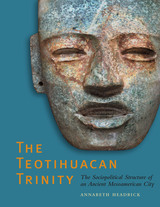 The Teotihuacan Trinity: The Sociopolitical Structure of an Ancient Mesoamerican City
By Annabeth Headrick
University of Texas Press, 2007 Northeast of modern-day Mexico City stand the remnants of one of the world's largest preindustrial cities, Teotihuacan. Monumental in scale, Teotihuacan is organized along a three-mile-long thoroughfare, the Avenue of the Dead, that leads up to the massive Pyramid of the Moon. Lining the avenue are numerous plazas and temples, which indicate that the city once housed a large population that engaged in complex rituals and ceremonies. Although scholars have studied Teotihuacan for over a century, the precise nature of its religious and political life has remained unclear, in part because no one has yet deciphered the glyphs that may explain much about the city's organization and belief systems. In this groundbreaking book, Annabeth Headrick analyzes Teotihuacan's art and architecture, in the light of archaeological data and Mesoamerican ethnography, to propose a new model for the city's social and political organization. Challenging the view that Teotihuacan was a peaceful city in which disparate groups united in an ideology of solidarity, Headrick instead identifies three social groups that competed for political power—rulers, kin-based groups led by influential lineage heads, and military orders that each had their own animal insignia. Her findings provide the most complete evidence to date that Teotihuacan had powerful rulers who allied with the military to maintain their authority in the face of challenges by the lineage heads. Headrick's analysis also underscores the importance of warfare in Teotihuacan society and clarifies significant aspects of its ritual life, including shamanism and an annual tree-raising ceremony that commemorated the Mesoamerican creation story.
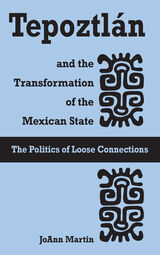 Tepoztlán and the Transformation of the Mexican State: The Politics of Loose Connections
JoAnn Martin
University of Arizona Press, 2005 During the 1980s and ’90s, Mexico weathered an economic crisis, witnessed electoral upheaval, and saw the dismantling of state subsidies to farmers and the privatization of nationally owned industries. This book considers how popular movements found fresh footing in this new political-economic landscape as villagers in Tepoztlán fought to keep communal lands out of the hands of outsiders, the state, and—increasingly—global capitalists. Examining social movement politics from the margins rather than the center, JoAnn Martin revisits the famous Redfield-Lewis debate on Tepoztlán to argue that the gossip seen by Oscar Lewis as undermining community coherence is really a form of political practice. During more than fifteen years of research, she observed the metamorphosis of a movement founded as a revolutionary popular struggle into what she terms a “politics of loose connections,” in which temporary alliances, flexible identities, and shifting rhetoric are adapted to the demands of the moment. Martin examines contemporary land struggles with an emphasis on the Comité para la Defensa de Tierra and its attempts to weave together strands of an invented tradition, contemporary agrarian reform law, and revolutionary ideology. She shows how Tepoztecan politics borrows discourses from the Mexican state; she then tells how this process shaped local politics in the midst of the contested 1988 national presidential election when local actors elaborated a discourse of democracy as a technique for disciplining gossip, and in 1991 when Tepoztecans began to draw on the support of international environmental NGOs. Throughout her analysis, Martin explores how Tepoztecan politics unfolds in the climate of mistrust first nurtured by the role of the state in local politics and later by the demands of working with U.S. and Western European environmentalists. Martin shows that the politics of loose connections is above all else a style of political participation that has proved adaptive in the contemporary political landscape, and that understandings of politics have been dogged by a conception of connections that may well be obsolete in the contemporary world. Her study is a balanced re-evaluation of Tepoztlán that reveals how politics succeeds through loose connections, a strategy that may be instructive for others seeking to survive in either local or global coalitions.
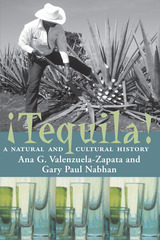 Tequila: A Natural and Cultural History
Ana G. Valenzuela-Zapata and Gary Paul Nabhan
University of Arizona Press, 2004 The array of bottles is impressive, their contents finely tuned to varied tastes. But they all share the same roots in Mesoamerica's natural bounty and human culture.
The drink is tequila—more properly, mescal de tequila, the first mescal to be codified and recognized by its geographic origin and the only one known internationally by that name. In ¡Tequila! A Natural and Cultural History, Ana G. Valenzuela-Zapata, the leading agronomist in Mexico's tequila industry, and Gary Paul Nabhan, one of America's most respected ethnobotanists, plumb the myth of tequila as they introduce the natural history, economics, and cultural significance of the plants cultivated for its production.
Valenzuela-Zapata and Nabhan take you into the agave fields of Mexico to convey their passion for the century plant and its popular by-product. In the labor-intensive business of producing quality mescal, the cultivation of tequila azul is maintained through traditional techniques passed down over generations. They tell how jimadores seek out the mature agaves, strip the leaves, and remove the heavy heads from the field; then they reveal how the roasting and fermentation process brings out the flavors that cosmopolitan palates crave.
Today in Oaxaca it's not unusual to find small-scale mescal-makers vending their wares in the market plaza, while in Jalisco the scale of distillation facilities found near the town of Tequila would be unrecognizable to old José Cuervo. Valenzuela-Zapata and Nabhan trace tequila's progress from its modest beginnings to one of the world's favored spirits, tell how innovations from cross-cultural exchanges made fortunes for Cuervo and other distillers, and explain how the meteoric rise in tequila prices is due to an epidemic—one they predicted would occur—linked to the industry's cultivation of just one type of agave.
The tequila industry today markets more than four hundred distinct products through a variety of strategies that heighten the liquor's mystique, and this book will educate readers about the grades of tequila, from blanco to añejo, and marks of distinction for connoisseurs who pay up to two thousand dollars for a bottle. ¡Tequila! A Natural and Cultural History will feed anyone's passion for the gift of the blue agave as it heightens their appreciation for its rich heritage.
Terahertz Dielectric Resonator Antennas for High Speed Communication and Sensing: From theory to design and implementation
Rajveer S. Yaduvanshi
The Institution of Engineering and Technology, 2022 Terahertz dielectric resonator antennas (DRAs) provide ultrafast data transfer rates using large bandwidth and multimode operations, which make them ideal for high speed communication due to their low loss and high efficiency. They can work at microwave, terahertz or optical frequencies, and are compact in size, which makes them well suited for advanced applications in sensing, scanning and imaging. New geometries are being developed for conical optical DRAs, cylindrical optical DRAs and spherical optical DRAs. Spherical optical DRAs have features of super directivity which can be used in quantum radars. Cylindrical optical DRAs with photo diodes can be used for wireless energy harvesting.
 A Tercentenary History of the Boston Public Latin School, 1635–1935
Pauline Holmes
Harvard University Press This official history of the Boston Public Latin School contains a vast deal of information that will be eagerly welcomed by everyone interested in educational history or in American life and letters. There are, for instance, biographical sketches of the masters, ushers, and famous pupils, including Cotton Mather, Benjamin Franklin, Samuel Adams, John Hancock, Charles Bulfinch, Ralph Waldo Emerson, Charles W. Eliot, and many more. Other chapters consider the support of the school in the Colonial period, administration and supervision, discipline and corporal punishment, the development of curriculum, and text books of the past three centuries. The illustrations are particularly noteworthy; they reproduce report cards, broadside catalogues of students, order of exercises at the “school visitations,” various school buildings, title-pages of Colonial text books, and portraits of noted masters and students.
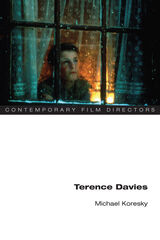 Terence Davies
Michael Koresky
University of Illinois Press, 2014 Called the most important British filmmaker of his generation, Terence Davies made his reputation with modern classics like Distant Voices, Still Lives and The Long Day Closes, personal works exploring his fractured childhood in Liverpool. His idiosyncratic and unorthodox narrative films defy easy categorization, as their seeming existence within realism and personal memory cinema is undermined by an abstractness that makes the way he lays bare personal pain come across as distant, even alien. Film critic Michael Koresky explores the unique emotional tenor of Davies's work by focusing on four paradoxes within the director's oeuvre: films that are autobiographical yet fictional; melancholy yet elating; conservative in tone and theme yet radically constructed; and obsessed with the passing of time yet frozen in time and space. Through these contradictions, the films' intricate designs reveal a cumulative, deeply personal meditation on the self. Koresky also analyzes how Davies's ongoing negotiation of--and struggle with--questions of identity related to his past and his homosexuality imbue the details and jarring juxtapositions in his films with a queer sensibility, which is too often overlooked due to the complexity of Davies's work and his unfashionable ambivalence toward his own sexual orientation.
Teresa
Neera, translated by Martha King
Northwestern University Press, 1999 Teresa, first published in 1886, is set in Italy's Po Valley near Cremona. The story relates the life of Teresa Caccia, an eldest daughter whose primary responsibilities at age fifteen include taking care of her younger siblings. When she falls in love, the union is deemed financially unsuitable and she's forced to spend the remainder of her youth caring for her family. Only when her brothers and sisters have left home can she emerge from her bleak existence and create her own life.
Through Teresa and other women characters, Neera addressed the injustice of such societal restrictions in nineteenth-century Italy. Neera's narratives are noted for their subtle psychoanalytical presentation of feminine states of mind as well as for an unflinching examination of society.
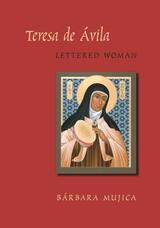 Teresa de Avila, Lettered Woman
Barbara Mujica
Vanderbilt University Press, 2009 In 1562, Teresa de Avila founded the Discalced Carmelites and launched a reform movement that would pit her against the Church hierarchy and the male officials of her own religious order. This new spirituality, which stressed interiority and a personal relationship with God, was considered dangerous and subversive. It provoked the suspicion of the Inquisition and the wrath of unreformed Carmelites, especially the Andalusian friars, who favored the lax practices of their traditional monasteries. The Inquisition investigated Teresa repeatedly, and the Carmelite General had her detained. But even during the most terrible periods of persecution, Teresa continued to fight for the reform using the weapon she wielded best: the pen. Teresa wrote hundreds, perhaps thousands, of letters to everyone from the King to prelates to mothers of novices. Teresa's epistolary writing reveals how she used her political acumen to dodge inquisitors and negotiate the thorny issues of the reform, facing off the authorities--albeit with considerable tact--and reprimanding priests and nuns who failed to follow her orders. Her letters bring to light the different strategies she used--code names, secret routing--in order to communicate with nuns and male allies. They show how she manipulated language, varying her tone and rhetoric according to the recipient or slipping into deliberate vagueness in order to avoid divulging secrets. What emerges from her correspondence is a portrait of extraordinary courage, ability, and shrewdness. In the sixteenth century, the word letrado (lettered) referred to the learned men of the Church. Teresa treated letrados with great respect and always insisted on her own lack of learning. The irony is that although women could not be letradas, Teresa was, as her correspondence shows, "lettered" in more ways than one.
 The Terezín Album of Mariánka Zadikow
Annotated by Debórah Dwork
University of Chicago Press, 2008 “With simple means, without any ‘title,’ this book should in distant times always be in your memory.”
An imprisoned bookbinder wrote these words in a small blank book that he had secretly crafted from pilfered materials at the Terezín (Theresienstadt) concentration camp in September 1944. He presented the album to a fellow prisoner, twenty-one-year-old Marianka Zadików. Over the next several months, as the Nazis pressed forward with mass deportations from Terezín to Auschwitz, Marianka began to collect inscriptions and sketches from her fellow inmates.
Marianka Zadików’salbum, presented here in a facsimile edition, is a poignant document from the last months of the Holocaust. The words and images inscribed here—by children and grandparents, factory workers and farmhands, professionals and intellectuals, musicians and artists—reflect both joy and trepidation. They include passages of remembered verse, lovingly executed drawings, and hurried farewells on the eve of transport to Auschwitz. The great German-Jewish scholar Rabbi Leo Baeck, one of the elders of the camp, offers Marianka an inscription about Jewish self-discovery, and participants in Terezín’s now-famous musical performances fill several pages with musical annotation.
Facing-page translations render the book’s multitude of languages into English, while historical and biographical notes give details, where known, of the fates of those whose words are recorded here. An introduction by acclaimed Holocaust scholar Debórah Dwork tells the story of the Terezín camp and how Marianka and her family fared while imprisoned there.
The array of voices and the glimpses into individual lives afforded us by The Terezín Album make it an arresting reminder of the sustaining power of care, community, and hope amid darkness.
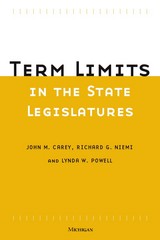 Term Limits in State Legislatures
John M. Carey, Richard G. Niemi, and Lynda W. Powell
University of Michigan Press, 2000 It has been predicted that term limits in state legislatures--soon to be in effect in eighteen states--will first affect the composition of the legislatures, next the behavior of legislators, and finally legislatures as institutions. The studies in Term Limits in State Legislatures demonstrate that term limits have had considerably less effect on state legislatures than proponents predicted.
The term-limit movement--designed to limit the maximum time a legislator can serve in office--swept through the states like wildfire in the first half of the 1990s. By November 2000, state legislators will have been "term limited out" in eleven states.
This book is based on a survey of nearly 3,000 legislators from all fifty states along with intensive interviews with twenty-two legislative leaders in four term-limited states. The data were collected as term limits were just beginning to take effect in order to capture anticipatory effects of the reform, which set in as soon as term limit laws were passed. In order to understand the effects of term limits on the broader electoral arena, the authors also examine data on advancement of legislators between houses of state legislatures and from the state legislatures to Congress.
The results show that there are no systematic differences between term limit and non-term limit states in the composition of the legislature (e.g., professional backgrounds, demographics, ideology). Yet with respect to legislative behavior, term limits decrease the time legislators devote to securing pork and heighten the priority they place on the needs of the state and on the demands of conscience relative to district interests. At the same time, with respect to the legislature as an institution, term limits appear to be redistributing power away from majority party leaders and toward governors and possibly legislative staffers.
This book will be of interest both to political scientists, policymakers, and activists involved in state politics.
John M. Carey is Assistant Professor of Political Science, Washington University in St. Louis. Richard G. Niemi is Professor of Political Science, University of Rochester. Lynda W. Powell is Professor of Political Science, University of Rochester.
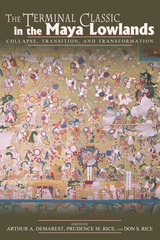 The Terminal Classic in the Maya Lowlands: Collapse, Transition, and Transformation
Arthur A. Demarest
University Press of Colorado, 2004 The Terminal Classic in the Maya Lowlands revisits one of the great problems in Mayan archaeology - the apparent collapse of Classic Maya civilization from roughly A.D. 830 to 950. During this period the Maya abandoned their power centers in the southern lowlands and rather abruptly ceased the distinctive cultural practices that marked their apogee in the Classic period. Archaeological fieldwork during the past three decades, however, has uncovered enormous regional variability in the ways the Maya experienced the shift from Classic to Postclassic society, revealing a period of cultural change more complex than acknowledged by traditional models. Featuring an impressive roster of scholars, The Terminal Classic presents the most recent data and interpretations pertaining to this perplexing period of cultural transformation in the Maya lowlands. Although the research reveals clear interregional patterns, the contributors resist a single overarching explanation. Rather, this volume's diverse and nuanced interpretations provide a new, more properly grounded beginning for continued debate on the nature of lowland Terminal Classic Maya civilization.
Terminal Diagrams: Poems
Garrick Davis
Ohio University Press, 2010 Garrick Davis’s Terminal Diagrams may have been inspired by the illustrated maps in airport lounges, or perhaps they are the blueprints of the Apocalypse, with their subjects and objects representing the bitter fruits of either some future nightmare or the present world. Regardless, their vision is so bleak and unsparing, only a few will be able to savor them. Here, the art of poetry has been mechanized just as the world has been mechanized. Whether his subject is a car accident on the freeways of Los Angeles or the Book of Revelation transmitted by television, Davis’s stanzas conjure a kind of futuristic noir. In poem after poem, he examines the artistic possibilities of the machine, and its alterations of human experience, with a modern spirit that—as Baudelaire defined it—has embraced “the sublimity and monstrousness of something new.”
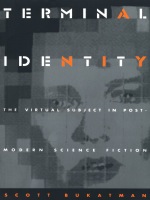 Terminal Identity: The Virtual Subject in Postmodern Science Fiction
Scott Bukatman
Duke University Press, 1993 Scott Bukatman's Terminal Identity—referring to both the site of the termination of the conventional "subject" and the birth of a new subjectivity constructed at the computer terminal or television screen--puts to rest any lingering doubts of the significance of science fiction in contemporary cultural studies. Demonstrating a comprehensive knowledge, both of the history of science fiction narrative from its earliest origins, and of cultural theory and philosophy, Bukatman redefines the nature of human identity in the Information Age.
Drawing on a wide range of contemporary theories of the postmodern—including Fredric Jameson, Donna Haraway, and Jean Baudrillard—Bukatman begins with the proposition that Western culture is suffering a crisis brought on by advanced electronic technologies. Then in a series of chapters richly supported by analyses of literary texts, visual arts, film, video, television, comics, computer games, and graphics, Bukatman takes the reader on an odyssey that traces the postmodern subject from its current crisis, through its close encounters with technology, and finally to new self-recognition. This new "virtual subject," as Bukatman defines it, situates the human and the technological as coexistent, codependent, and mutally defining.
Synthesizing the most provocative theories of postmodern culture with a truly encyclopedic treatment of the relevant media, this volume sets a new standard in the study of science fiction—a category that itself may be redefined in light of this work. Bukatman not only offers the most detailed map to date of the intellectual terrain of postmodern technology studies—he arrives at new frontiers, providing a propitious launching point for further inquiries into the relationship of electronic technology and culture.
|
|
